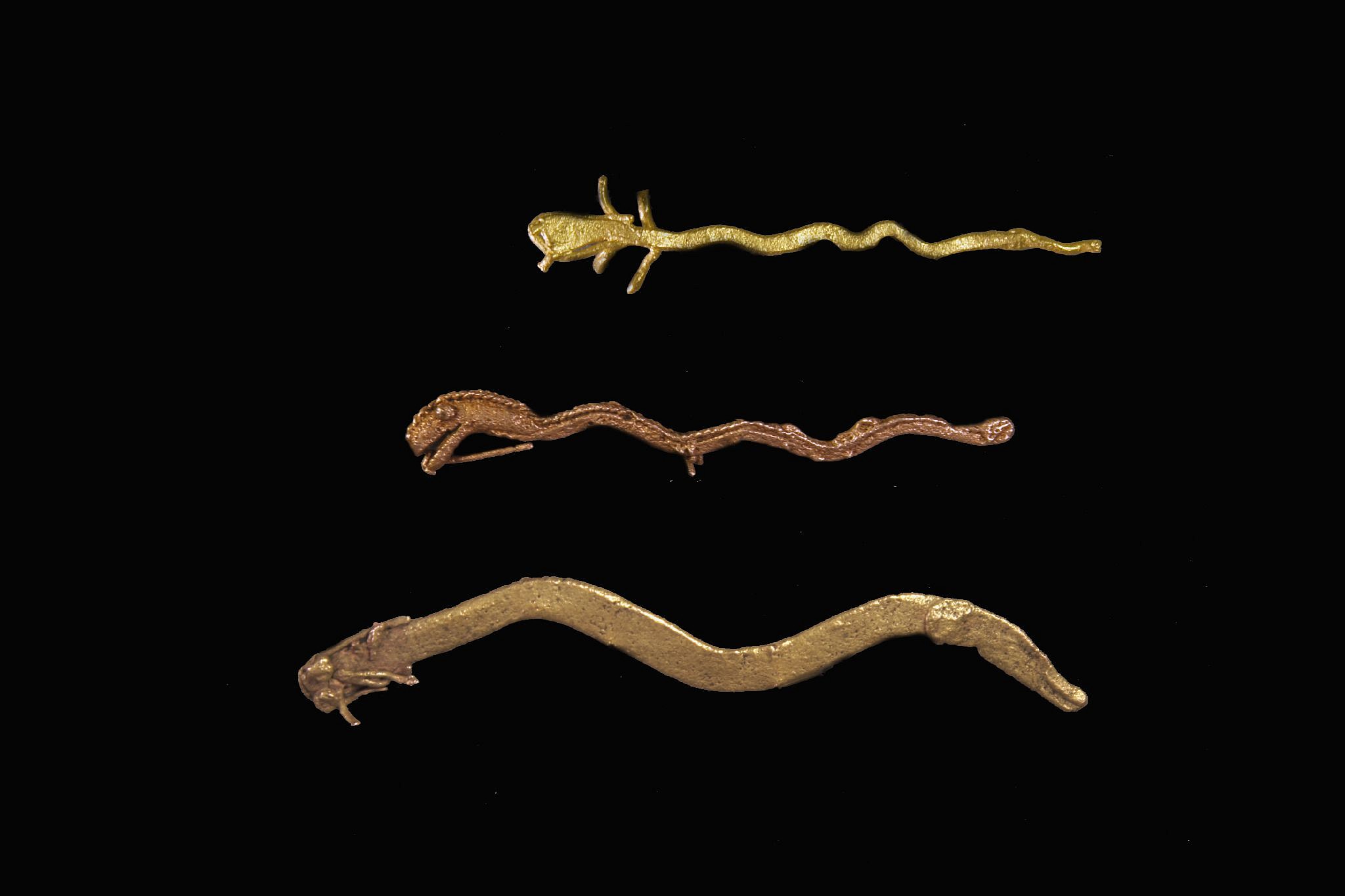


Colombia, 3 Muisca Cast Gold Snakes
The Muisca people of Eastern Columbia were known for their famous myth, El Dorado. El Dorado refers to a lord riding on a golden raft and covered in gold dust. Serpents are featured prominently in the Muisca creation myth, which describes two snakes emerging from the Iguaque lagoon as a women and child. Transmutation was an important theme to the Musica; these snakes are all cast using the lost wax technique as well as the manipulation of alloys to create the three different hues of gold.
Media: Metal
Dimensions: Length: 1. 7/8, 2. 3/16 & 3. 9/16 inches Total Weight: 5.2 grams.
$2,400
n8006







Ecuador, 7 La Tolita Gold with Platinum Miniature Ear Ornaments with Turquoise Inlays
Each ornament has an inlayed turquoise stone and a suspension ring. These are excellent examples of early granulation and sintering techniques. Sintering is the process of melting gold foil over platinum which can then be reheated and annealed to fashion small objects. Similar ear ornaments are published in The Gold of Eldorado, by Warwick Bray and in Charms in Pre-Columbian Ecuador by Christian Mesia Montenegro. Acquired in 1994 from an old estate auction.
Media: Metal
Dimensions: Approx. Length: 1" each. Weight: 4 grams.
$4,600
94203
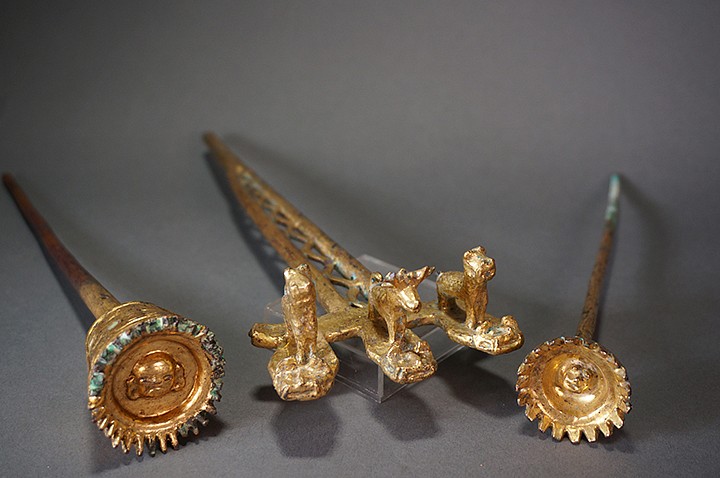








Peru, A Rare Recuay Gilt Scepter
This scepter is very rare with an unusual motif of three animals standing on three flayed feline skins. The central animal is a deer flanked by an unknown four-legged animal. The shaft of the scepter has two channels attached by a series of triangular soldered stock. Each channel has a suspension hole towards the top. This scepter must have belonged to a high status individual as its manufacture is very elaborate and technically sophisticated. Only one other known similar Recuay scepter is illustrated in Kultur Von Peru by Max Schmidt, pg. 392. The accompanying two tupus with decorated tops (longer and shorter) each have a different motif.
The longer tupu is decorated with a band of four stooping animals in low relief, each with a serpent emanating from its head. The inside of the the longer tupu’s upper cup is decorated with a frowning face, perhaps a mask. This is one of the largest known intact tupus. The smaller tupu has a rich gilt surface and is decorated with a band of two face masks. Inside the upper cup of the small tupu is the head of the same animal flanking the deer on the scepter. Both tupus have finials that are decorated with both an outside band and an inside head. The larger one has a band of 3 double headed serpents with a fox head inside. The smaller one has a band of a double-headed arched feline and a face inside.
Four tupus excavated at Pashash, the earliest known Recuay site, are illustrated in The Art and Archaeology of PSAHASH by Terence Grieder, figs. 114-117, and fig. 7. These tupus were originally sold by Alan Lapiner in the early 1970s along with a classic Recuay vessel of a lord flanked by arched felines on each side.
Media: Metal
Dimensions: Scepter Length 9" x Width 3"
Longer Tupu Length 8 ½ x diameter 1 ½â€
Shorter tupu: Length: 7 ½†x diameter 1"
Price Upon Request
M3023
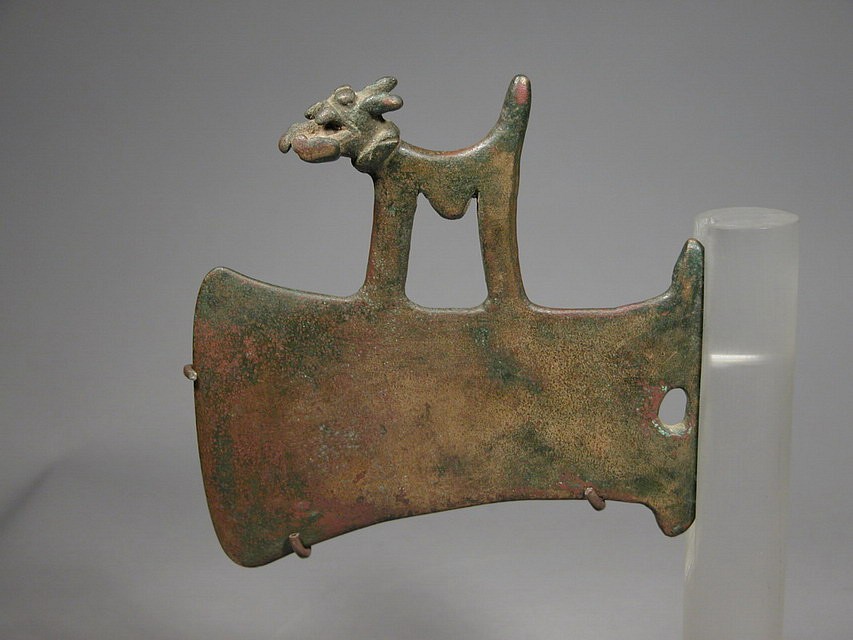


Bolivia, Bolivian Bronze Axe with jaguar on the blade
Bronze axes from Bolivia were often surmounted with the figure of a collared jaguar, with an erect tail and tongue protruding between the fangs of the lower jaw. Similarly stylized Peruvian examples are shown in Carcedo de Mufarech (1999: fig. 157; and Posnansky 1896: v. 3/4: pl. 87). Although this piece is technically provincial Inca, the form of the collared jaguar came from regional cultures in Bolivia.
Media: Metal
Dimensions: Height: 4 1/4" / Width of Blade: 5"
$6,500
MM037B





Colombia, Calima Cast Gold Lime Dipper of a Warrior with Animal Perched on Back
This finely cast gold lime dipper features a warrior with an animal perched on his back and a tapering shaft terminating in two bands of granulation. The warrior wears an elaborate mask, a curving headdress, and holds a staff with both hands. Gold lime dippers often featured warrior figures and were reserved for important personages. For further reading, see Calima and Malagana, by Marianne Cardale Schrimpff. A similar lime spoon is illustrated on p. 115, plate 111.34. This is an excellent example of lost wax casting. Acquired in 2000 from private New York collector.
Media: Metal
Dimensions: Length:(8 1/4" Weight 15.9 grams.
$12,000
MM618
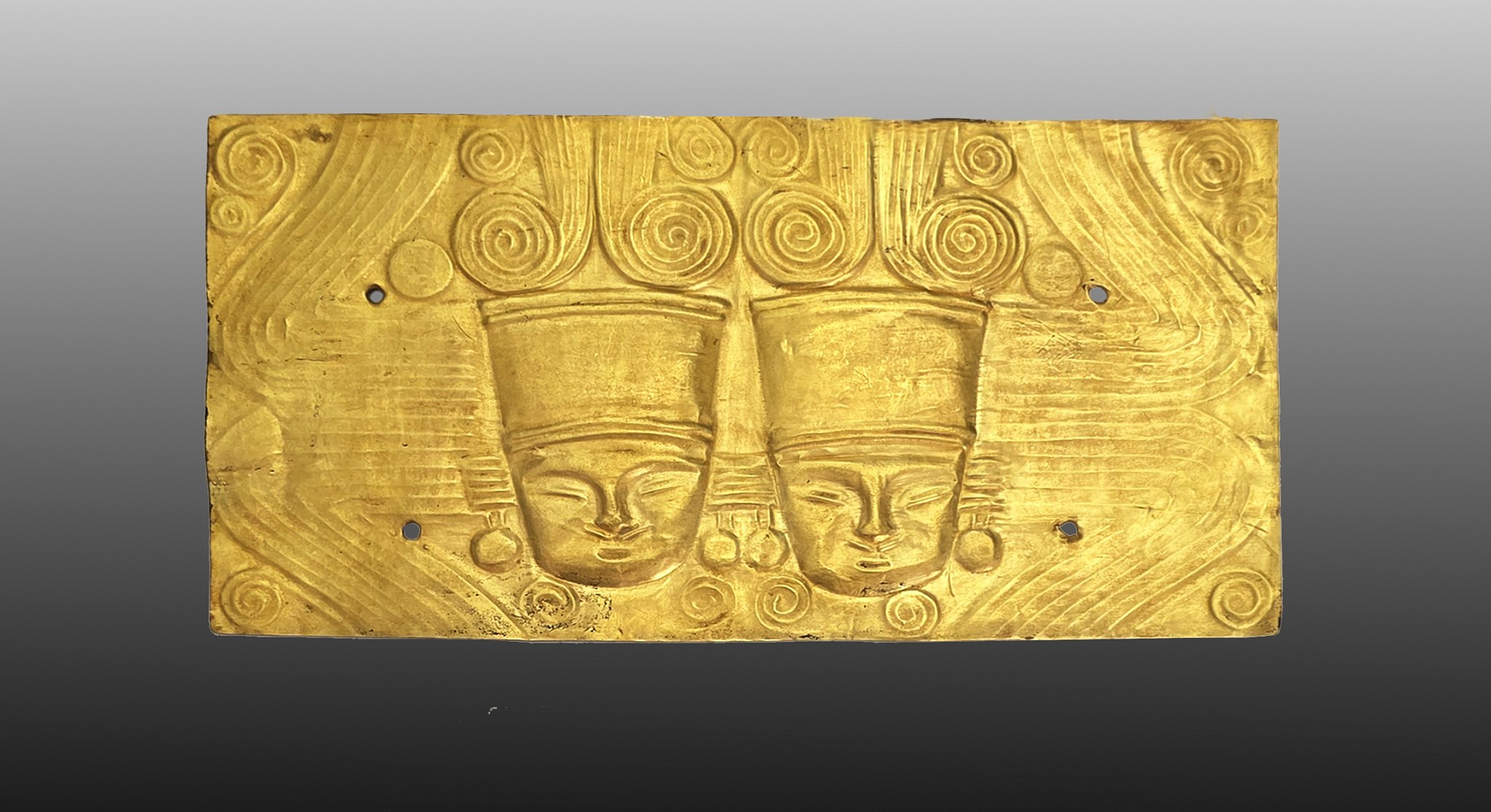
Colombia, Calima Gold Hammered and Incised Plaque with Two Royal Heads
In ancient Pre-Columbia, twin imagery was considered to represent good luck and prosperity. This incised gold plaque features twin royal figures, identifiable by their headdresses and the elaborate swirl design above their heads, indicating that they are individuals of high status.
Media: Metal
Dimensions: Height: 3 1/2" x Width: 6 1/2" Weight 28.8 grams.
$24,000
p5051






Colombia, Calima Gold Lime Spoon with a Royal Bird Holding a Double-Headed Serpent
When held upside down, this elaborately crafted bird transforms into a mask. From the Jan Mitchell collection, acquired prior to the 1970s, by descent to his sons.
Media: Metal
Dimensions: Height: 4 1/8" Weight: 22.7 grams.
$7,500
p1052






Colombia, Calima Gold Tupu (Lime Dipper) of a Deity Seated on a Serpent
The deity has an elaborate face mask and holds the tail of the serpent upon which he is seated. This is a known motif, but rarely seen with a human, as most are found with a cayman or feline as the primary figure. According to the research, only limited types of images were used for lime dippers, usually shamans or warriors. A similar example is illustrated in Calima and Malagana, by Marianne Cardale Schrimpff, page 116, plate 111.37.
Media: Metal
Dimensions: Length:5 1/4 " x Weight: 34 grams.
$8,250
M8031





Colombia, Calima Rayed Gold Headdress Ornament with an Embossed Face
Similar style headdress ornaments are in the gold Museum in Bogota. It appears that the ornament was ceremonially "killed". Ex. Jan Mitchell collection, prior to 1970, by descent to his sons. From a Texas collector, acquired prior to the 1970s.
Media: Metal
Dimensions: Height 10 1/2"
$28,500
P1001
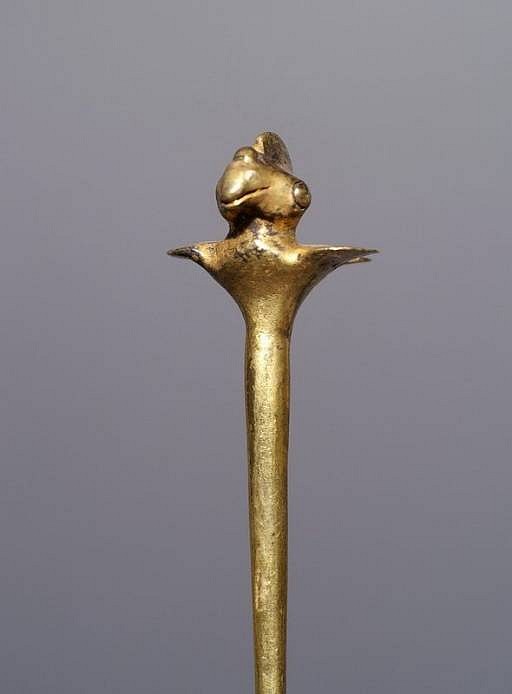




Colombia, Calima Tupu with Condor on top
Tupus were used to fasten the shawls of upper class women as well as the garments on votive offerings of small figures. The tops were often decorated with images which related to its owner, such as a Shaman, Cacique (warrior) or favorite animal. This tupu has the condor's male snood and incised feathers on the wing and tail.
Media: Metal
Dimensions: Length 9 1/8" Weight: 45grams
Price Upon Request
M8033



Colombia, Capuli Hammered Gold Pectoral Disk
This pectoral has two sets of horizontal suspension holes toward the top. The suspension holes suggest that the disc was originally part of a more elaborate stringing with multiple strands. A very similar pectoral with four suspension holes is illustrated in THE ART OF PRECOLUMBIAN GOLD: The Jan Mitchell Collection, page 202. From the estate of Jan Mitchell, acquired prior to the 1970s.
Media: Metal
Dimensions: Diameter: 3 3/4 " Weight: 44.6 grams.
$6,500
p3062
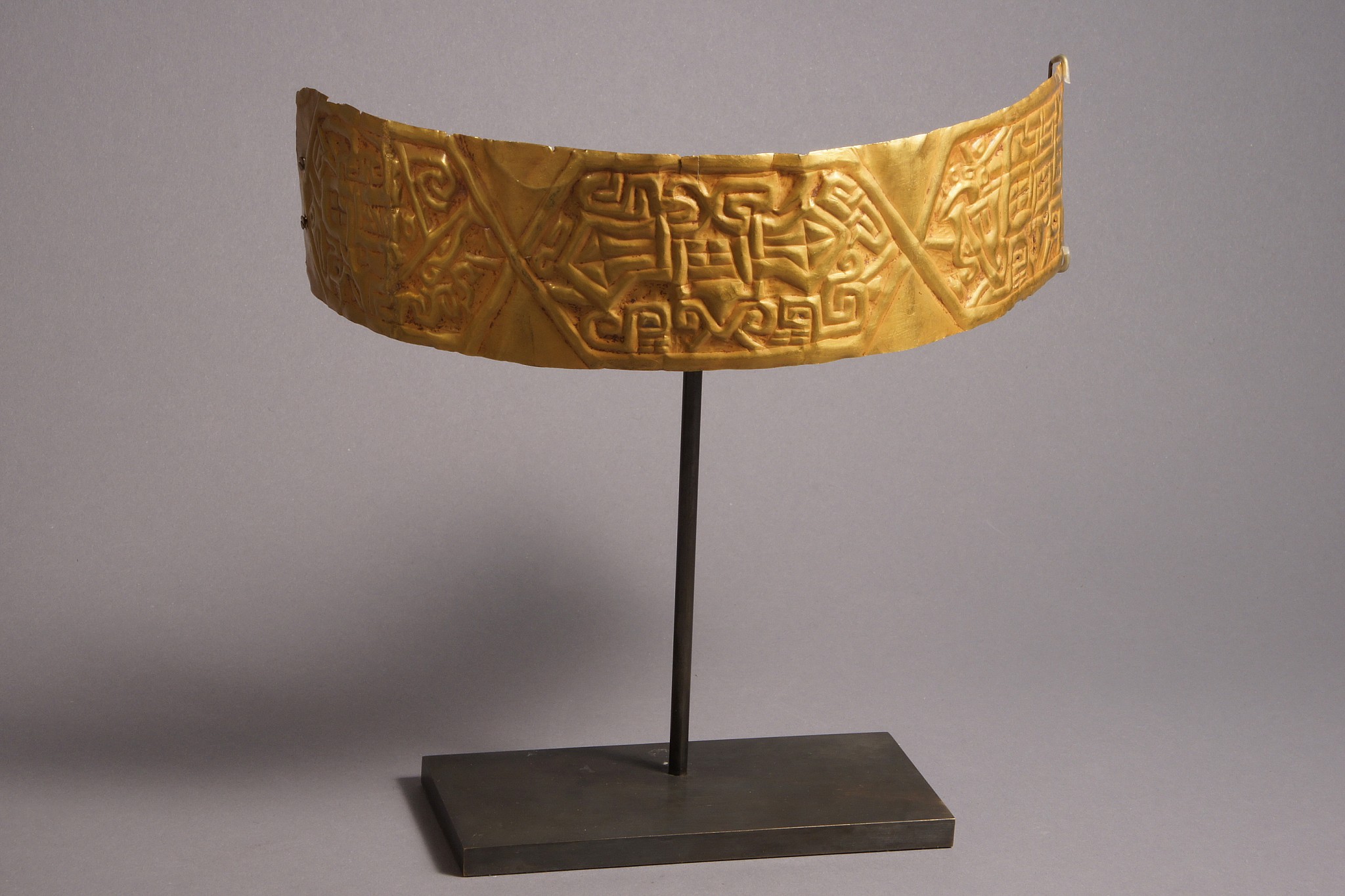



Peru, Chavin Gold Crown With Embossed Design
Chavin artists hammered gold sheets over wooden molds to make crowns and pectorals for the ruling elite. This crown was cut down and repaired in antiquity, but it originally had two profile faces on the sides and two frontal images of the feline deity so often seen in Chavin art. A cuff from the same grave lot is on display at the Houston Museum of Fine Arts with faces separated by diagonal designs. This crown is published in Jose Antonio Lavalle "Oro Del Antiguo Peru" (1992: pl. 10). Samuel K. Lothrop was the first scholar to analyze gold crowns and plaques that came from two tomb lots in Chongoyape, "Gold Artifacts of Chavin Style" (American Antiquity 1951, 3: 226 - 240). His work and other tomb finds are reviewed by Richar L. Burger in "Chavin and The Origins of Andean Civilization" (1992: 204 - 206) A number of crowns similar to this one are known to have come from these tombs, which also yielded gold cuffs, ear spools, nose pendants, chest plaques and tweezers. Examined and approved by Robert Sonin and Henri Reichlin in 1976. Ex-collection Marcel Ebnother, Switzerland.
Media: Metal
Dimensions: Length 11. 1/2" x Height 2"
Price Upon Request
M6075



Peru, Chavin Gold Pin with Simple Twisted and Hammered Diamond Design
This unusual diamond-shaped pin was made from one flat sheet that was hammered and twisted.
Media: Metal
Dimensions: Length: 5 1/8" x Weight: 3.1 grams.
$1,200
N5041
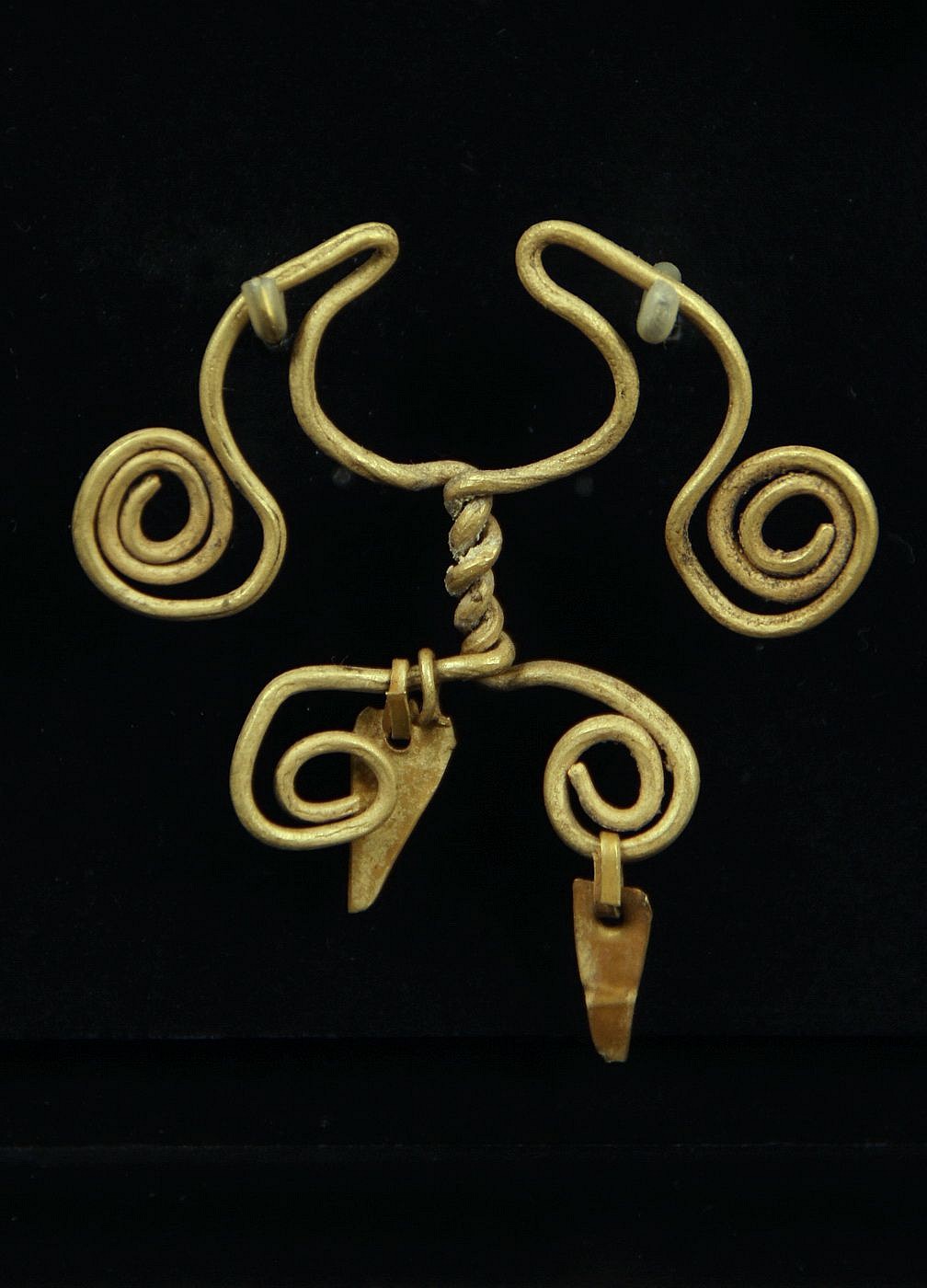
Peru, Chavin Gold Spiral Nose Ring with Two Twisted Wires and Two Dangles
This wire nose ring was made of one hammered sheet of gold, folded on itself, and cut. The ornament was hammered and coiled with the original suspended dangles.
Media: Metal
Dimensions: Height:1 1/4" Weight: 4.8 grams
$2,100
94222
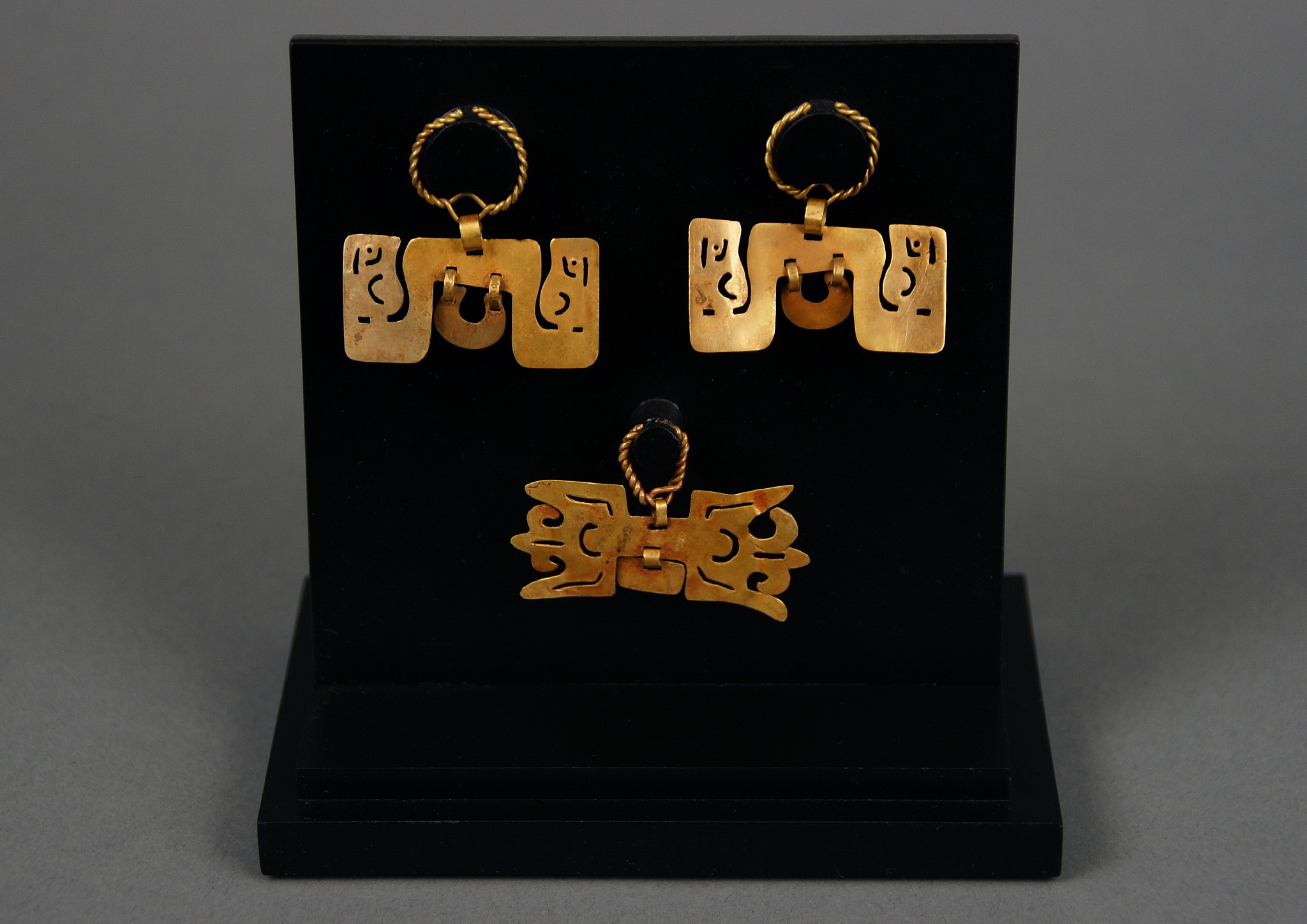




Peru, Chavin Pair of Gold Ear Ornaments and a Gold Nose Ornament with double chevron
The pair of gold ornaments, each with a double headed serpent with cut-out facial details, suspended by a twisted wire loop, and a suspension plaque dangleA gold nose ornament with cutout design and a central suspension plaque. The single nose ornament has a cut-out design sign in an abstract avian face or that of opposing chevrons, suspended by a twisted gold wire loop. pl. 15.
Media: Metal
Dimensions: Widths 1 1/2 inches each; Width 1 3/4 inches
Price Upon Request
94157
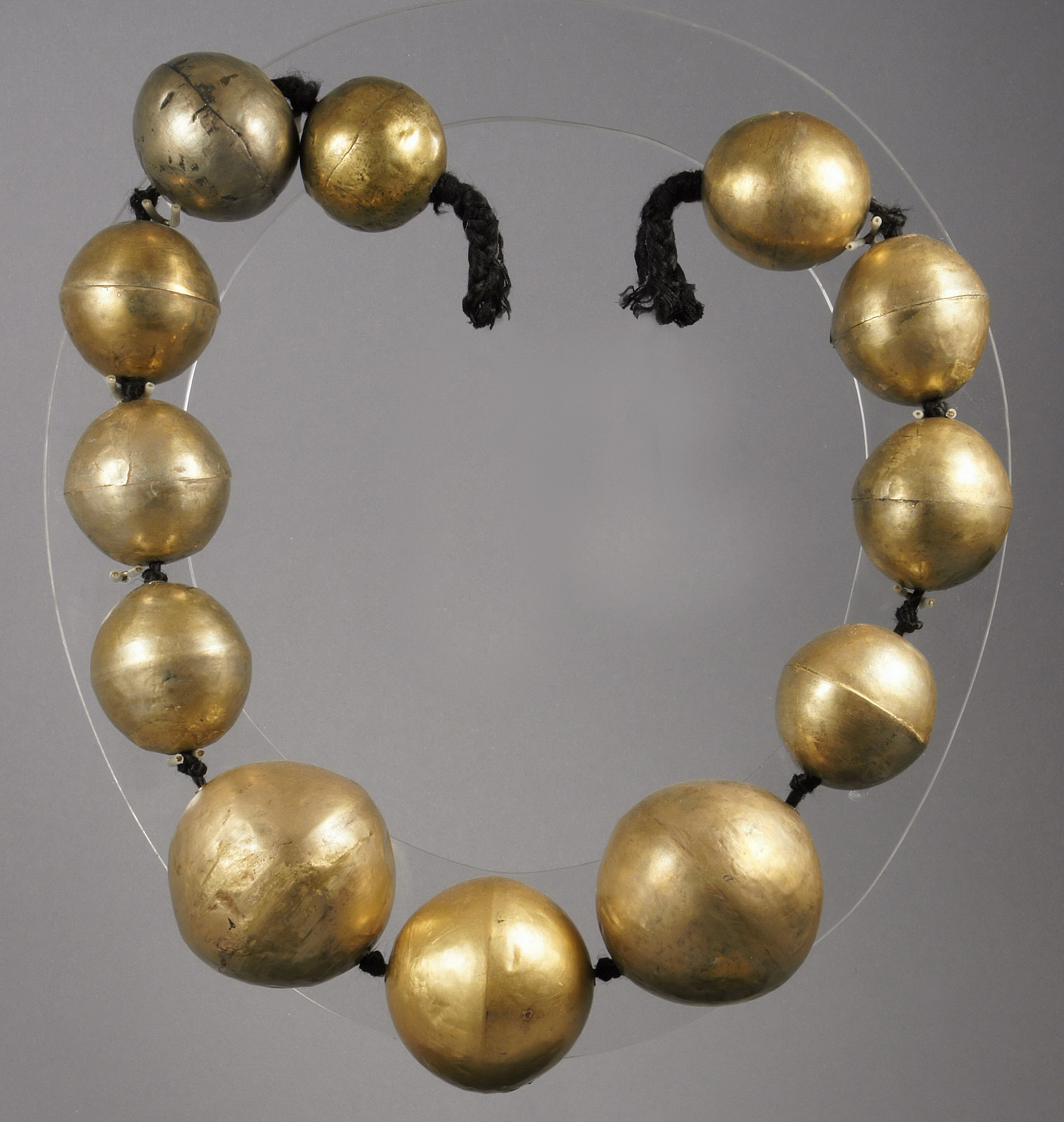

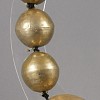
Peru, Chimú Gold 29" Necklace of Large Hollow Beads
The Chimú inherited a taste for hollow gold bead necklaces from their Moche predecessors. In both cultures, each bead was cast and hammered in two halves that were then joined together by soldering. In the Chimú technique, the edges of the two halves were nested together. These beads are extremely light with a greater percentage of silver than gold. They used depletion gilding to bring the gold to the surface by using of heats and salts. This allowed the Chimu to make the gold available for a large and growing ruling class. Private Florida collection prior to 1980.
Media: Metal
Dimensions: Necklace Length: 29"; largest bead 2 1/4" diameter - smallest 1 1/2"
$27,000
M7991



Peru, Chimu Gold Cuff with Three Bands of 4 Repousse Stars Each
This gold cuff would have been worn as an adornment by a high-status male warrior. It features three rows of repousse starts, with four stars in each row, and two tie holes. A cuff with a similar star design is illustrated in the catalog of the Gold Museum of Peru on page 127. Formerly in the collection of Camilla Deitz Bergeron, New York antiquaire, acquired prior to the 1980s.
Media: Metal
Dimensions: Height 4 1/2" Weight: 65.5 grams.
$9,500
N2064
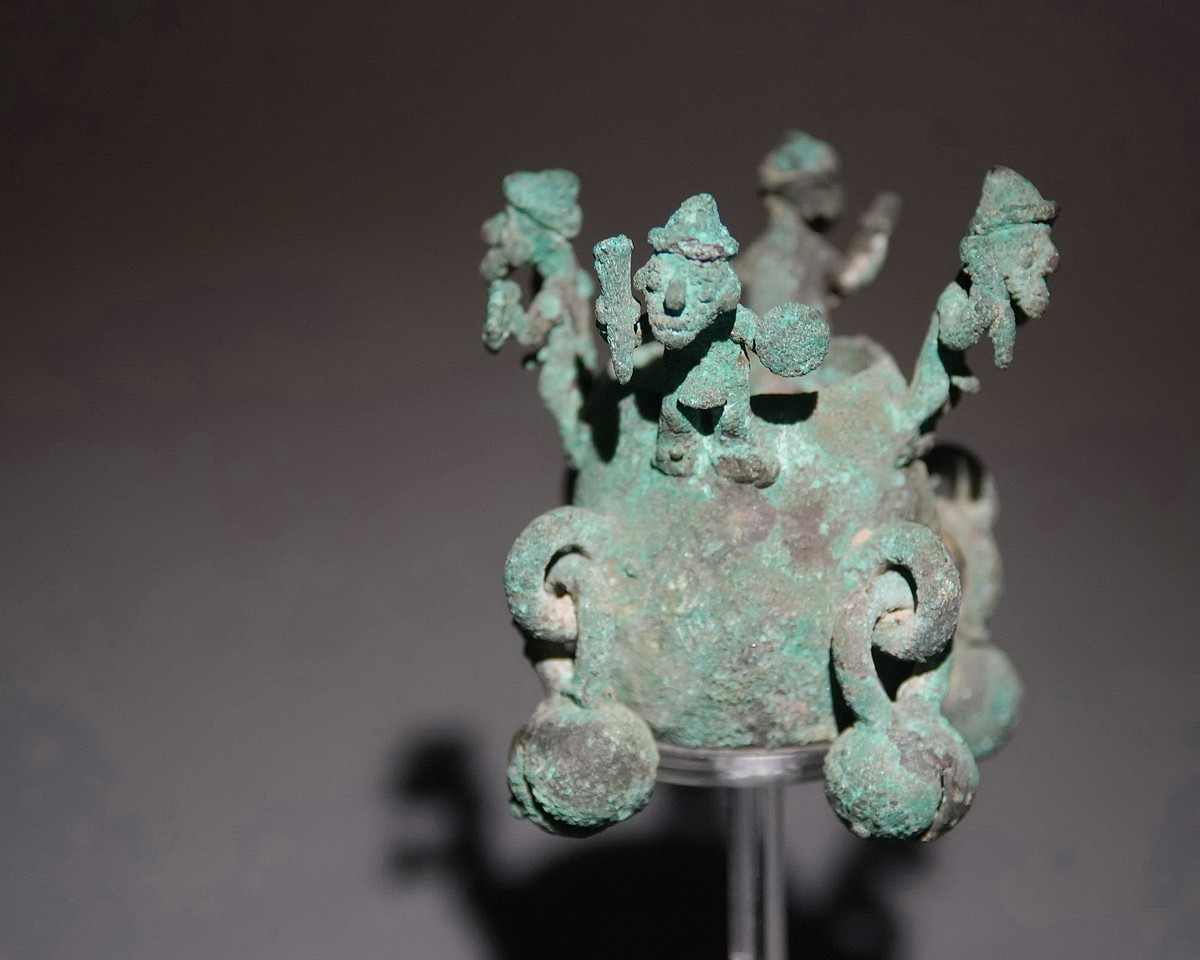




Peru, Chimu Lost Wax Cast Bronze Finial with Four Warriors
Metal objects that are cast with rings or bells that move to make a sound are known as idiophones. Each warrior wears a loincloth and holds a club in one hand and a shield in the other. Each of the loops around the shaft holds a bell, which when moved, clanks against the shaft.
Media: Metal
Dimensions: Height: 2 3/4" x Width: 3:
$5,500
P1038
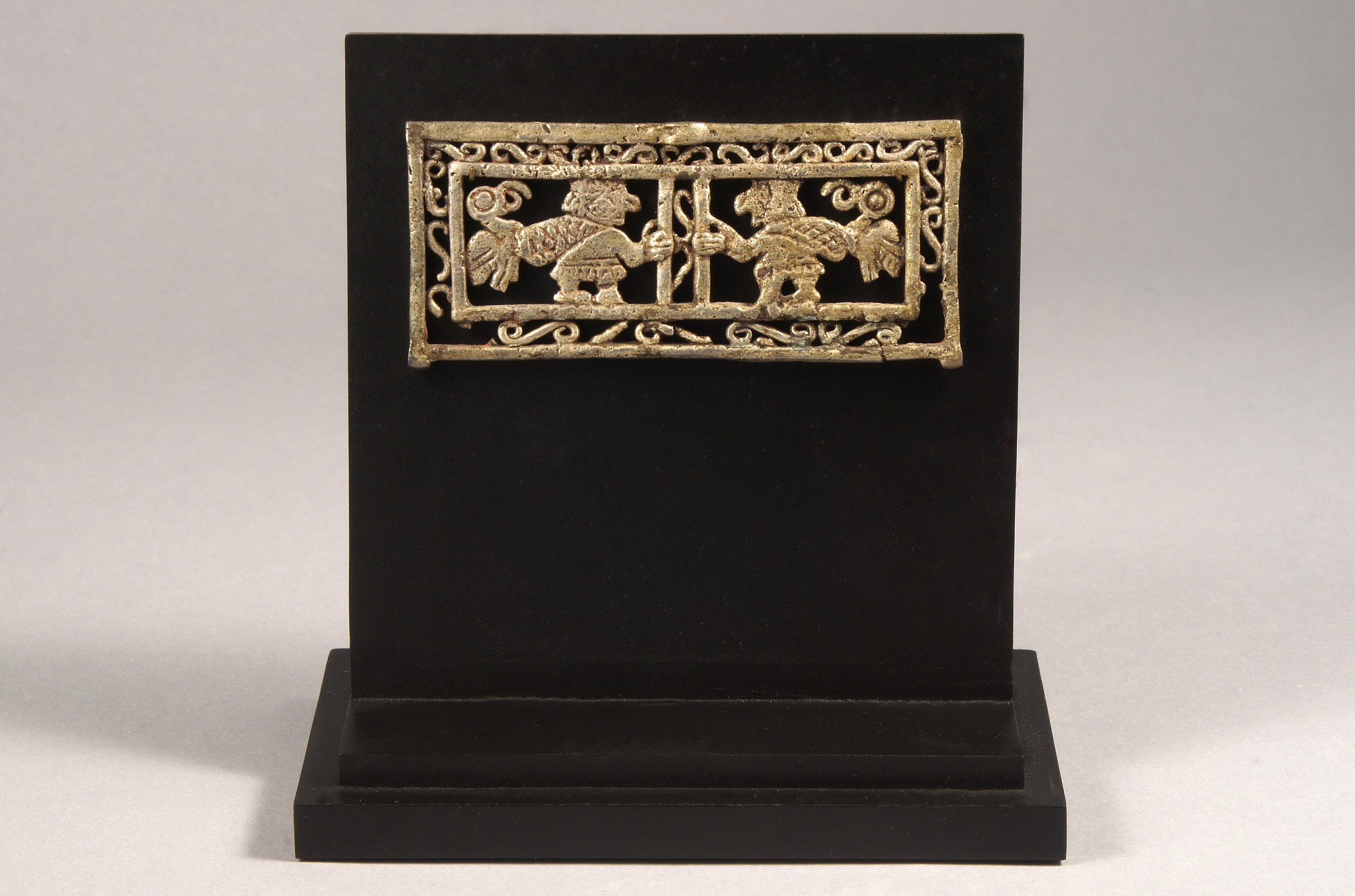




Peru, Chimu silver balance with 2 warriors
A rare Chimu silver balance beam decorated with two bag carrying individuals followed by a perched bird. This depiction could explain how the balance beams were used by exchanging feathers of different birds of equal weight. Trade across long distances of exotic materials was a key element in the ancient economy. The balance beam is made of both cast and soldered elements. It is true soldered filigree work of curls decorating the edge. The individuals and birds were cast. It is also extremely rare to find balance beams in silver, as most of them are of wood or bone. There is a single suspension hole in the top bar center and one hole for a net on each side of the lower bar.
Media: Metal
Dimensions: H: 2" W:3.5"
$4,500
98361
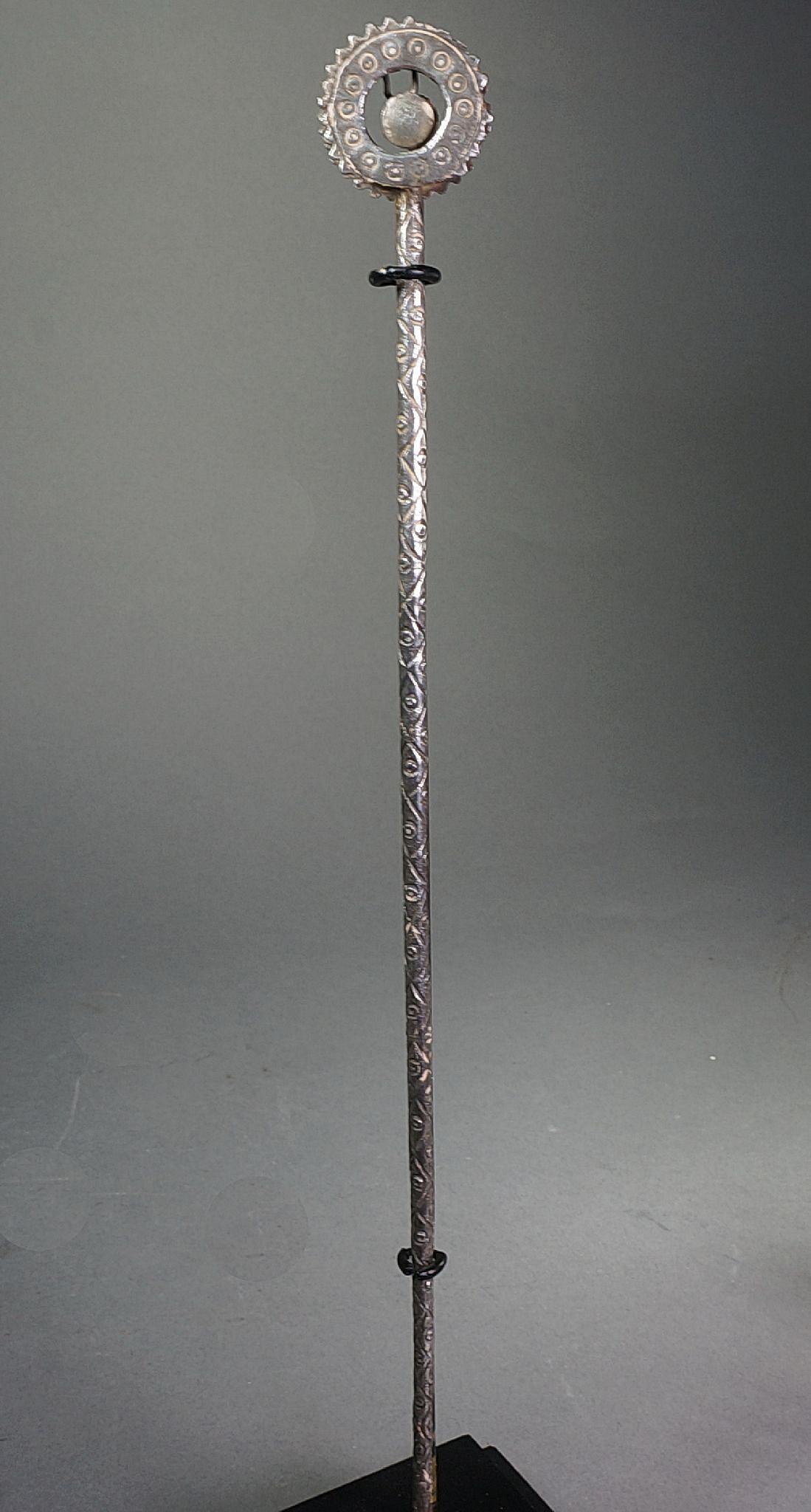




Peru, Chimu Silver Tupu with Ornate Rattle
Tupu pins were used by high status individuals to fasten their garments. The level of fine detail and craftsmanship indicates that this silver tupu would have belonged to an extremely important person. The shaft is completely incised with a repeating diamond motif. The rattle at the top is constructed with two incised discs, soldered to a curved band. Inside is a delicate suspended cylinder. This rare tupu is in good condition and has been professionally cleaned and stabilized.
Media: Metal
Dimensions: Length:10" x Weight: 25 grams
$2,650
MM615
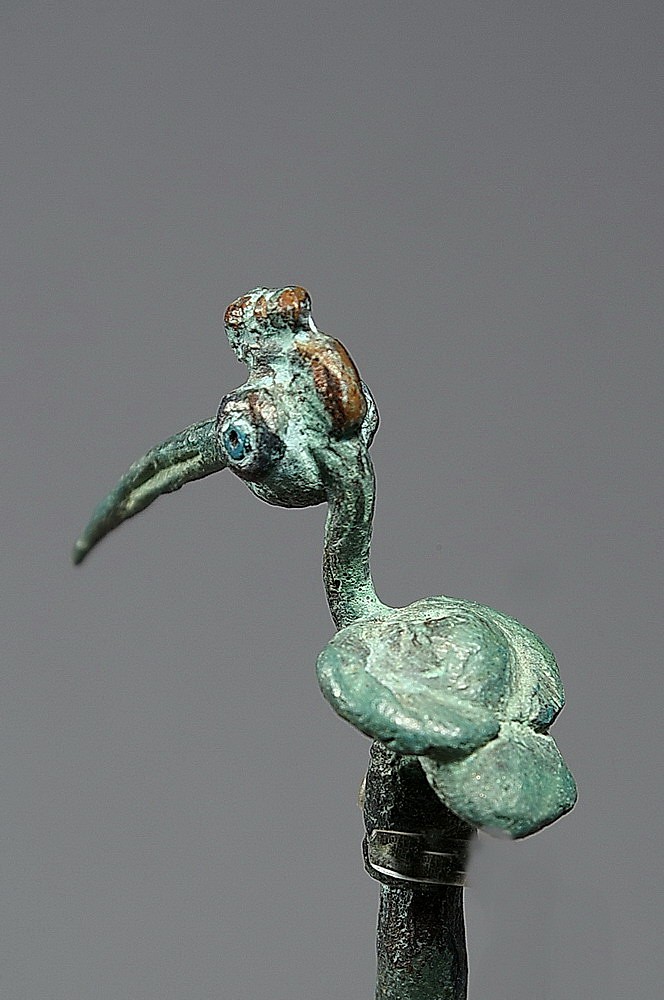



Peru, Chimu/Inca Copper Lime Spoon with Long-Billed Bird
An unusually large lime spoon decorated with a cast long-billed marine bird on top. The bird has turquoise beads for eyes. Lime spoons were used to extract powdered lime from containers for participants in coca rituals. The lime (powdered burned limestone or shell) was the catalyst that released the cocaine alkaloids from the coca leaves chewed during these ceremonies. Coca rituals were important to Andean cultures, but were restricted to elite, high-ranking lords. Birds represented souls flying to the otherworld to communicate with the supernatural. For similar examples, see Baessler (1906: pl. 13; Nordenskiold 1921: fig. 19, c; Carcedo de Mufarech 1985: fig. 89; and Schindler 2000: 202 and 203).
Media: Metal
Dimensions: Height: 4 3/4"
Condition: Good. The tip of the spoon has been restored.
Price Upon Request
95102




Colombia, Chiriqui /Diquis Gold Pendant with Framed Twin Musicians
Gold pendant with twin musicians, side by side. There are two sets of Saurian animals in profile, along the figures’ heads and knees, encircled by the typical braided goldwork frame. Illustrated in The Art of Pre-Columbian Gold, page 102, and exhibited in 1976 in the Leningrad Museum. Also published in Pre-Columbian Art of Mexico and Central America, 1968, by Hasso Von Winning, plate #189 on page 378. From the estate of Jan Mitchell, by descent to his son Oliver Mitchell, prior to 1968.
Media: Metal
Dimensions: Height: 2 7/8 x Width: 3 in. Weight: 116 grams.
$85,000
p4165
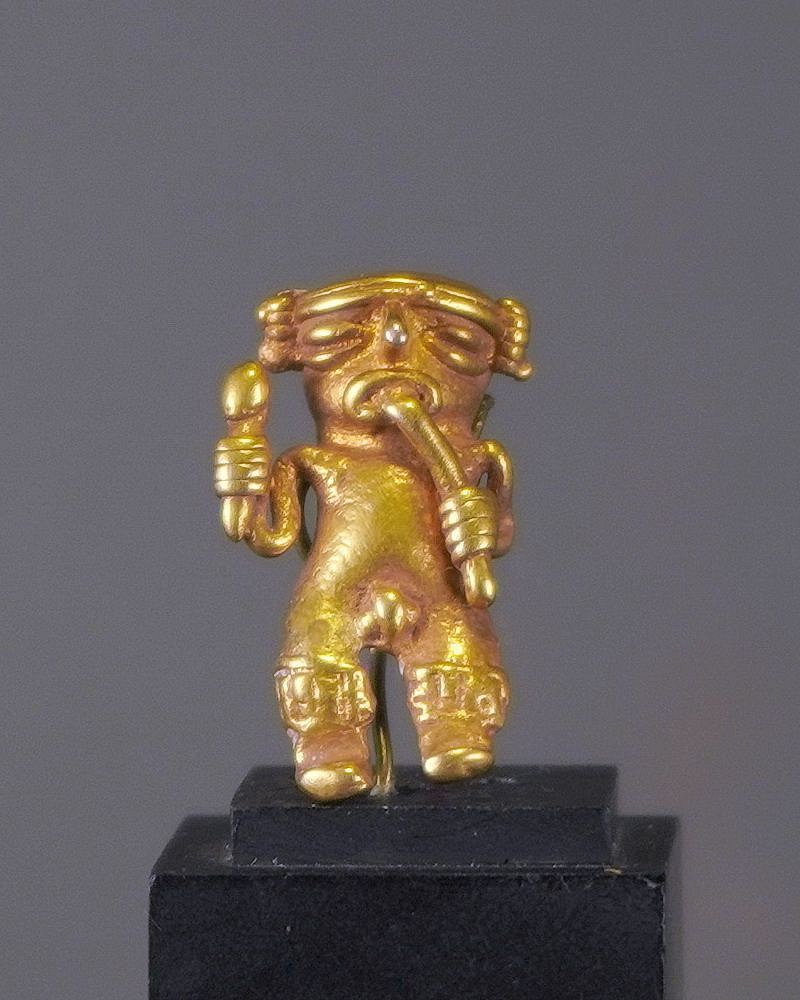




Costa Rica, Chiriqui Cast Gold Miniature Flute Player
This miniature gold shaman is seen playing a flute and holding a rattle in the left hand. Music was known to facilitate trance states and psychological healing during psychedelic shamanic rituals. A similar piece is illustrated in THE ART OF PRECOLUMBIAN GOLD - THE JAN MITCHELL COLLECTION on page 101. From the collection of Karin Ashburn by descent from her father Benno Mattel of Uruguay.
Media: Metal
Dimensions: Height: 1 1/16" ( 2.7cm) Weight: 4.9grams
$1,900
n4027C




Costa Rica, Chiriqui Cast Gold Miniature Flute Player
This miniature gold shaman is seen playing a flute and holding a rattle in the left hand. Music was known to facilitate trance states and psychological healing during psychedelic shamanic rituals. A similar piece is illustrated in THE ART OF PRECOLUMBIAN GOLD - THE JAN MITCHELL COLLECTION on page 101. From the collection of Karin Ashburn by descent from her father Benno Mattel of Uruguay.
Media: Metal
Dimensions: Height: 1 1/16" ( 2.7cm) Weight: 4.9grams., 15 kt
$1,900
n4027
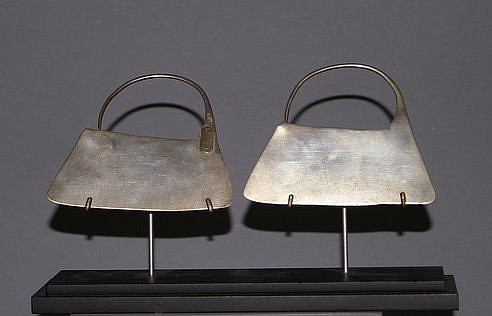





Chile, Classic Mapuche Trapezoidal Silver Ear Ornaments
This Mapuche ear ornaments are made from one continuous piece of hammered silver and feature the classic Mapuche trapezoidal shape. According to Mapuche tradition, these earrings would have been handed down to family members through multiple generations. They would likely have been repaired using primitive means by the family they belonged to.
Media: Metal
Dimensions: Width 3 3/4: x Height: 3" Weight: 1.06 oz.
$2,900
M9042





Panama, Classic Veraguas Cast Gold Frog with Serpents from its Mouth
This beautiful lost-wax cast gold frog has oval eyes and a ribbon down its back with hammered hind legs. Two elaborate serpents extend from the frog’s mouth. Gold castings are often finished with hammered extensions like flippers, arms, or serpents. There is a similar example at the Metropolitan Museum of Art from the Jan Mitchell collection. This is frog was also formerly in the Jan Mitchell collection, acquired prior to 1970, by descent to his sons.Shows signs of ancient wear. The suspension loops are quite worn.
Media: Metal
Dimensions: Length: 2 7/8" x Width: 1 3/4" Weight: 32.4 grams.
$8,500
p1045
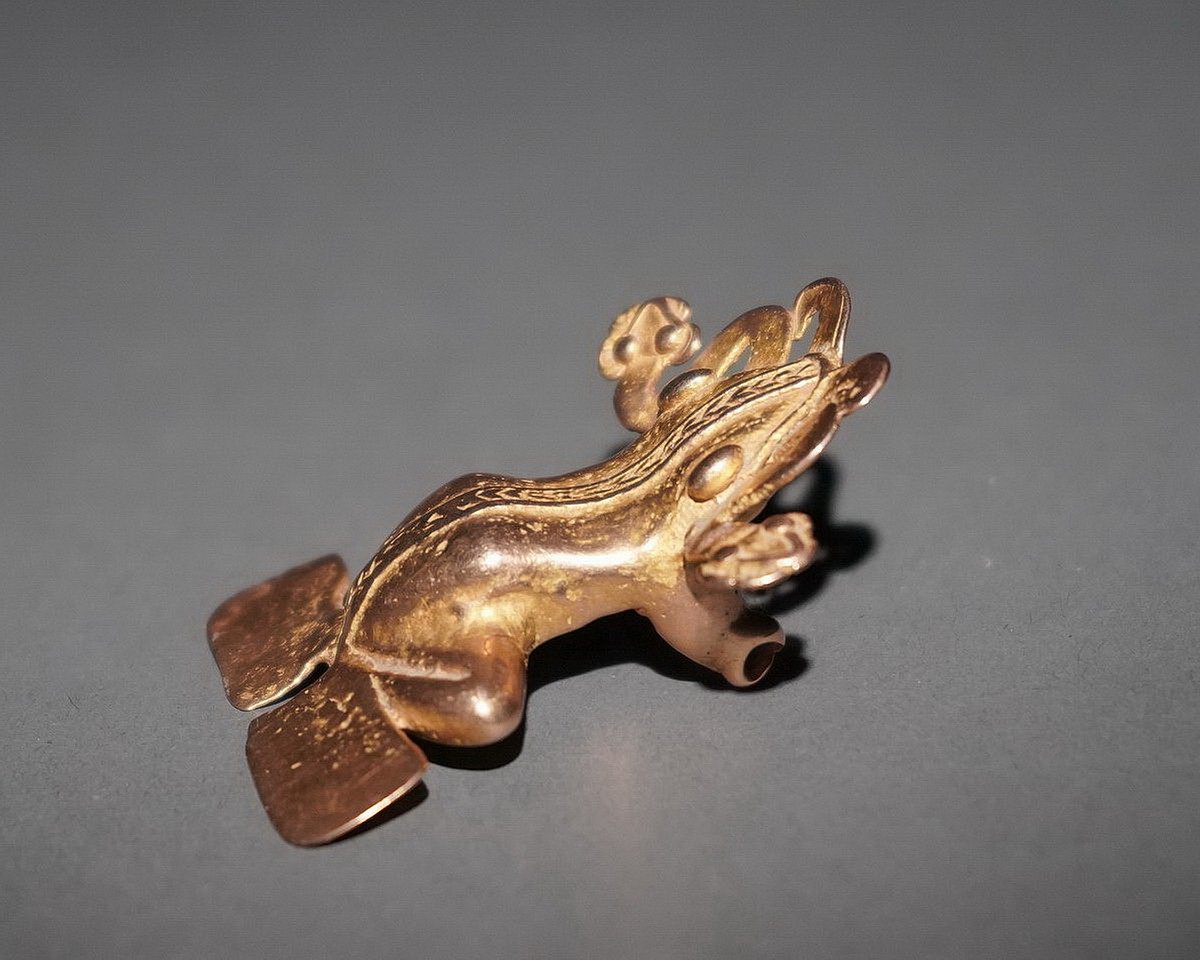





Panama, Classic Veraguuas Cast Gold Frog with Serpents
This beautiful cast gold frog has large spherical eyes and a ribbon down its back and bordering its flippers. There is a modern suspension loop hung from the original suspension arrangement. Jan Mitchell collection, prior to 1970, by descent to his sons.
Media: Metal
Dimensions: Length: 2 7/8" x Width: 1 3/4" Weight: 32.4 grams.
$6,500
p1045a
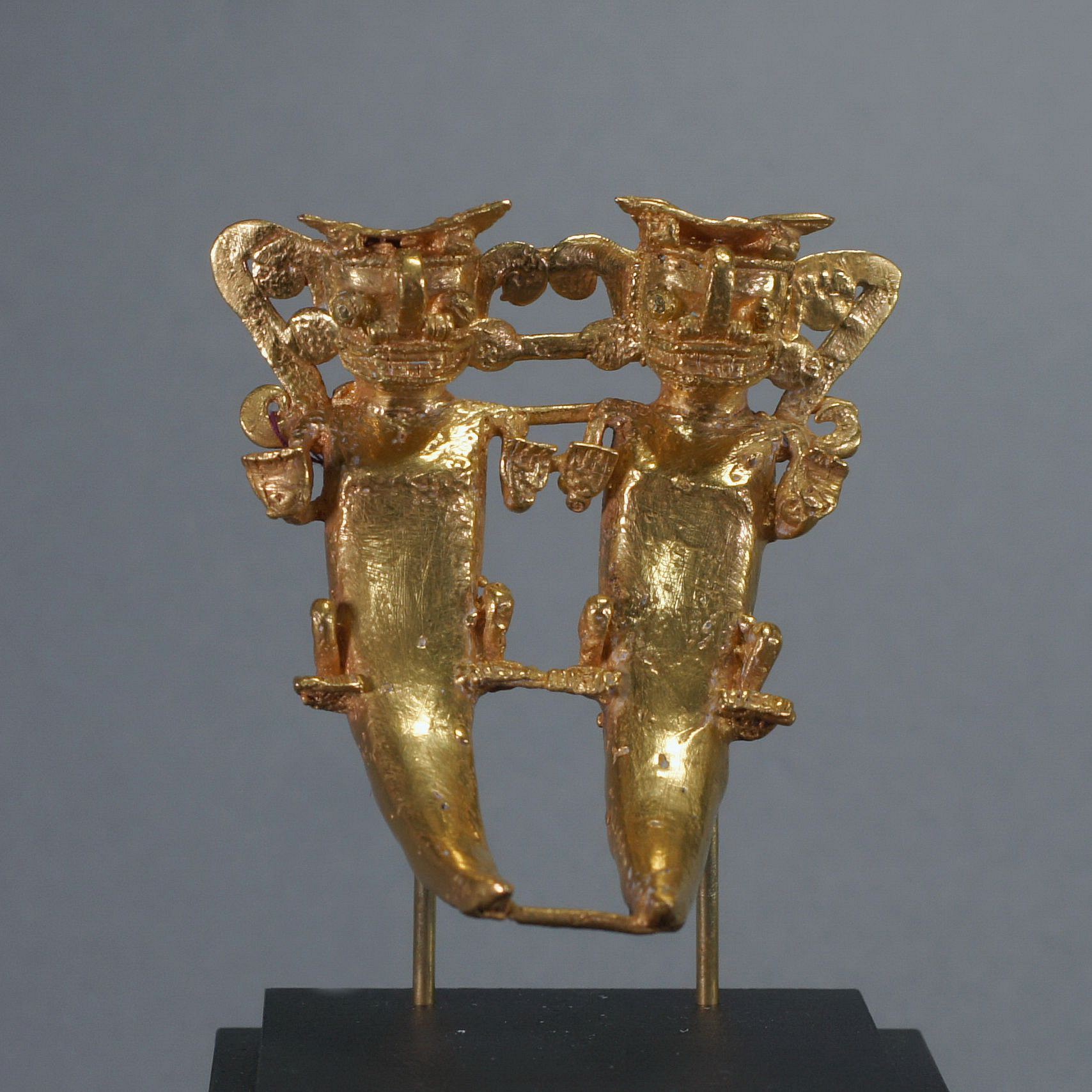
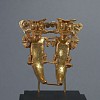



Panama, Cocle Cast Gold Pendant of Pair Anthropomorphized Bats
Lost Was cast depicting paired figures with bat faces, human hands, and a corcodilian body and tail. Duality was a known belief of the natural world: male and female, night and day, heaven and earth. Bats are nocturnal creatures and ruled the darkness. There are two cast suspension loops behind each outside shoulder. Ex. New York collector, prior to 1970.
Media: Metal
Dimensions: Width 2 3/4" x Length: 3 1/8" Weight 100.6 grams
XRF
Price Upon Request
n7027



Costa Rica, Costa Rican Gold Shaman Holding a Bell
Shamans often use music to assist in inducing a trance. In this case he uses a bell. Lost-wax cast, with a suspension loop at the back. A similar example is illustrated in The Gold of Ancient America, by Alan Wardwell, figure 92, page 111. From the Jan Mitchell collection, acquired prior to 1970, by descent to his sons.
Media: Metal
Dimensions: Height: 2" x Weight: 14.2 grams.
$3,000
p1255










Colombia, Darian Cast Gold Smiling Shaman with Headdress of Two Hemispheres with Spirals
This is a very large example of a Darien pendant with strong influences of neighboring Sinu and Quimbaya styles. The shaman has the typical Darien hemispherical headdress with filigree spirals, and a zoomorphic triangular snout that shows two rows of teeth. The projecting side ornaments are intended to represent a headdress made of feathers and are adorned with additional spiral scrolls. The legs are represented by a single metal plaque with curved sides and a vertical groove in the center – a stylistic influence from the earlier Quimbaya culture. Two similar images are illustrated in Darien Gold Pendants of Ancient Columbia and the Isthmus, by Ana Maria Falchetti -figures 30 and 31 on page 49.
Media: Metal
Dimensions: Height: 5"(12.7cm) x Width: 3 3/4"(9.5cm) Weight: 187.5grams. (6 troy oz)
•SOLD
n6003



Colombia, Darien Tumbaga Classic Mushroom Style Figural Pendant
This pendant is published in The Darien Gold Pendants of Ancient Colombia and the Isthmus, by Anna Maria Falcetti, Metropolitan Museum Journal No. 43, 2008, page 39. There is a high amount of gold in the casting. Ex-Jan Mitchell collection, prior to 1970.
Media: Metal
Dimensions: Height: 2 5/8" x Weight: 36.2 grams.
•SOLD
P1016
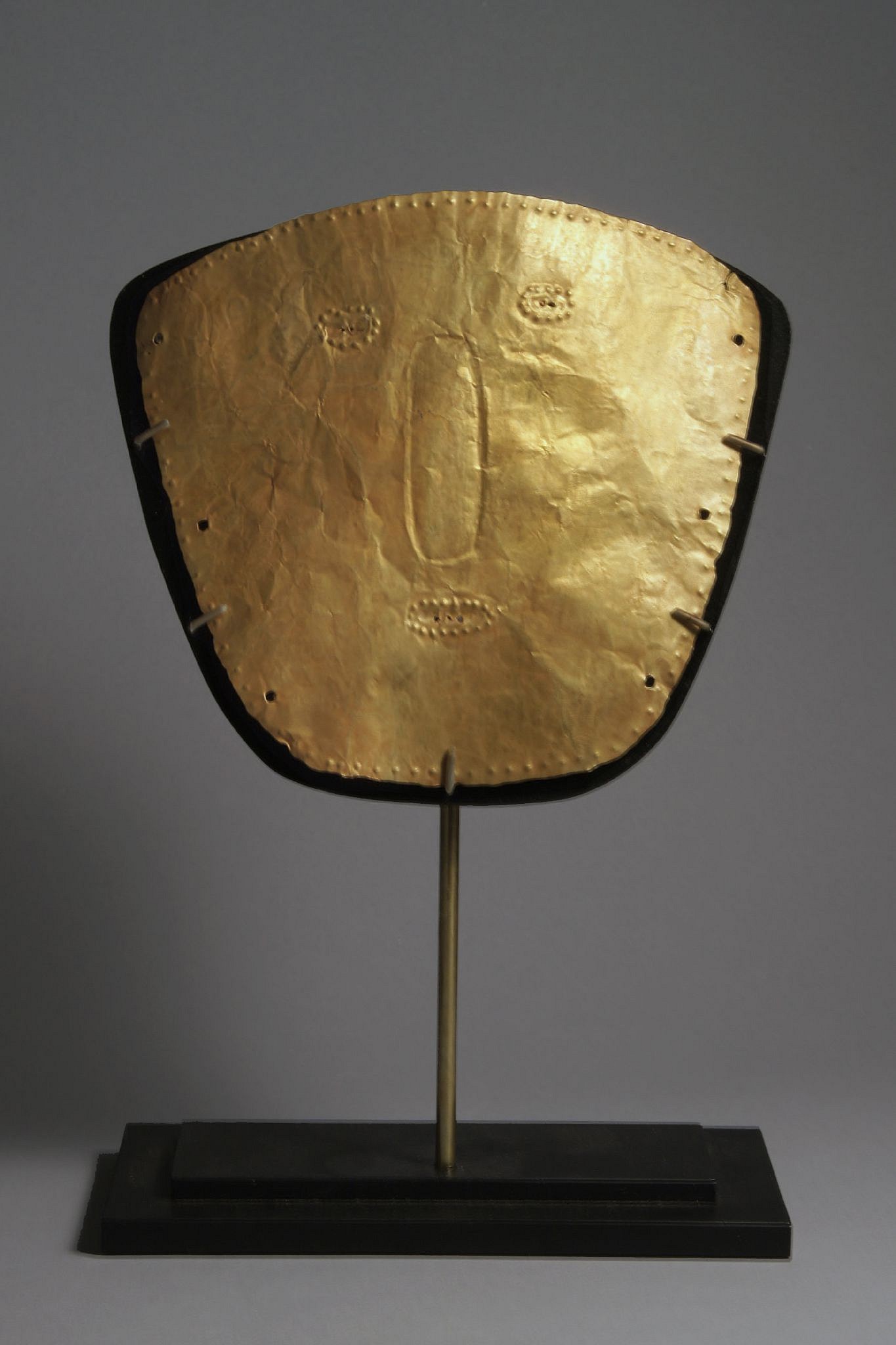

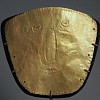

Chile, Diaguita Style Gold Mask with Repoussé Eyes, Mouth and Border
The eyes and mouth have pierced holes to attach turquoise eyes and a shell mouth. The six holes on the side of the mask were for tying the mask to the mummy. There are very few gold masks found in Chile because partly because that there was little gold available from rivers. The little-known gold that has been found in Chile was probably traded with Bolivia or even Peru. This mask is one of three that were supposedly found in Northern Chile near Arica. Very few masks from Arica are known as the area was poor and gold had to have been imported. The tradition of these simple masks goes back to the Chinchorro culture (circa 7,000 BC) of Northern Chile. I have found one gold diadem now in the American Museum of Natural History in New York which has a similar nose design. It is safe to say that this mask most closely resembles the same facial designs on the Diaguita ceramics from La Serenna - the round eyes, straight vertical nose and the horizontal mouth. The repousse design around the edge relates to the painted spots on the ceramic face. With this mask came a gold headband or turban, measuring 36" x 3/8" in width. The headband has the same repousse design on the edges. The gold content was tested at 17KT. and has been annealed and burnished to a thickness of 1/128"
Media: Metal
Dimensions: Width 6" x Height 5 1/4" Weight: 4.6 grams
XRF Au.69%, Ag.26% Cu. 4%
Price Upon Request
M7166
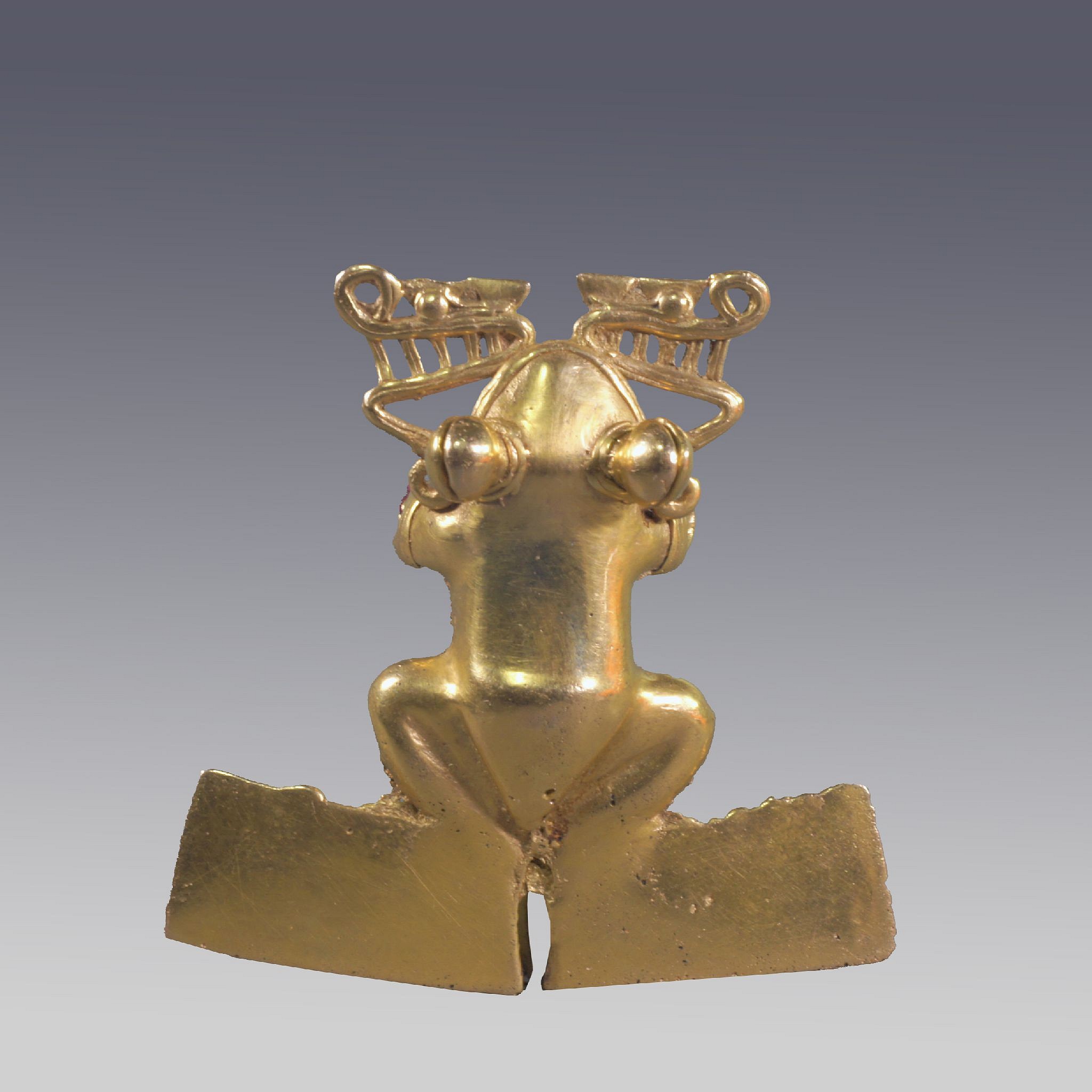
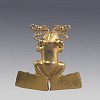


Panama, Diquis Gold Frog With Large Hind Flippers and Bulbous Eyes
The Frog has a classic body with his front legs becoming the suspension loops. From the mouth emanate two saurian heads back to back, with a mythological significance. The eyes each have a solid pellet inside to make noise when the frog is being worn. A similar example is illustrated in the Catalog, BETWEEN CONTINENTS/BETWEEN SEAS: Precolumbian Art of Costa Rica, fig. 287. A similar frog is also the Rockefeller Collection at the Metropolitan Museum of Art. Originally photographed by Justin Kerr #3081, 2001.
Media: Metal
Dimensions: Length: 3 3/4" x Width:3 1/2" Weight: 65 grams
XRF Au.68.5% Ag.03%, Cu. 31%
Price Upon Request
n4028






Panama, Diquis Lost Wax Cast Gold Eagle Pendant
This is a classic representation of a Harpy eagle, with pointed ears and large, curled claws, decorated with a neck band and elaborate bead design under each wing. Exhibited at the Metropolitan Museum of Art in 1985. The eagle was ceremonially "killed" with the wings and tail bent over. There are solder marks on the right wing, below the torso, and on both tips of the tail. From the estate of Jan Mitchell, acquired prior to 1970. Restoration to cracks to the wings and tail tips done by Pre-Columbian expert Robert Sonin. Strong enough to be worn.
Media: Metal
Dimensions: Height: 3 7/8" x Width; 4 3/4" Weight 152.7 grams.
$28,000
p1019







Panama, Diquis Lost Wax Cast Gold Frog or Toad Decorated with a Band Along His Back
The animal is in a resting, crouched position, with small hind legs and distinctive suspension loops supporting the front legs. There is a thin edge around the mouth, and the complex eyes suggest that this is from the Diquis region of Panama/Costa Rica zone. The frog is more realistic than most Diquis gold frogs, which are generally depicted with large hind legs. The cast has signs of over-casting at the rear underside. Overcasting is a complicated technique, used to repair casts which had areas of loss during the first casting. Inside, the rear still has sections of the carbon casting core. The suspension loops show wear, indicating that the frog was heavily worn on a pendant in ancient times. From the Jan Mitchell estate, collected prior to 1970.
Media: Metal
Dimensions: Length: 1 5/8" x Height: 15/16" Weight: 36.5 grams.
$7,500
P1028
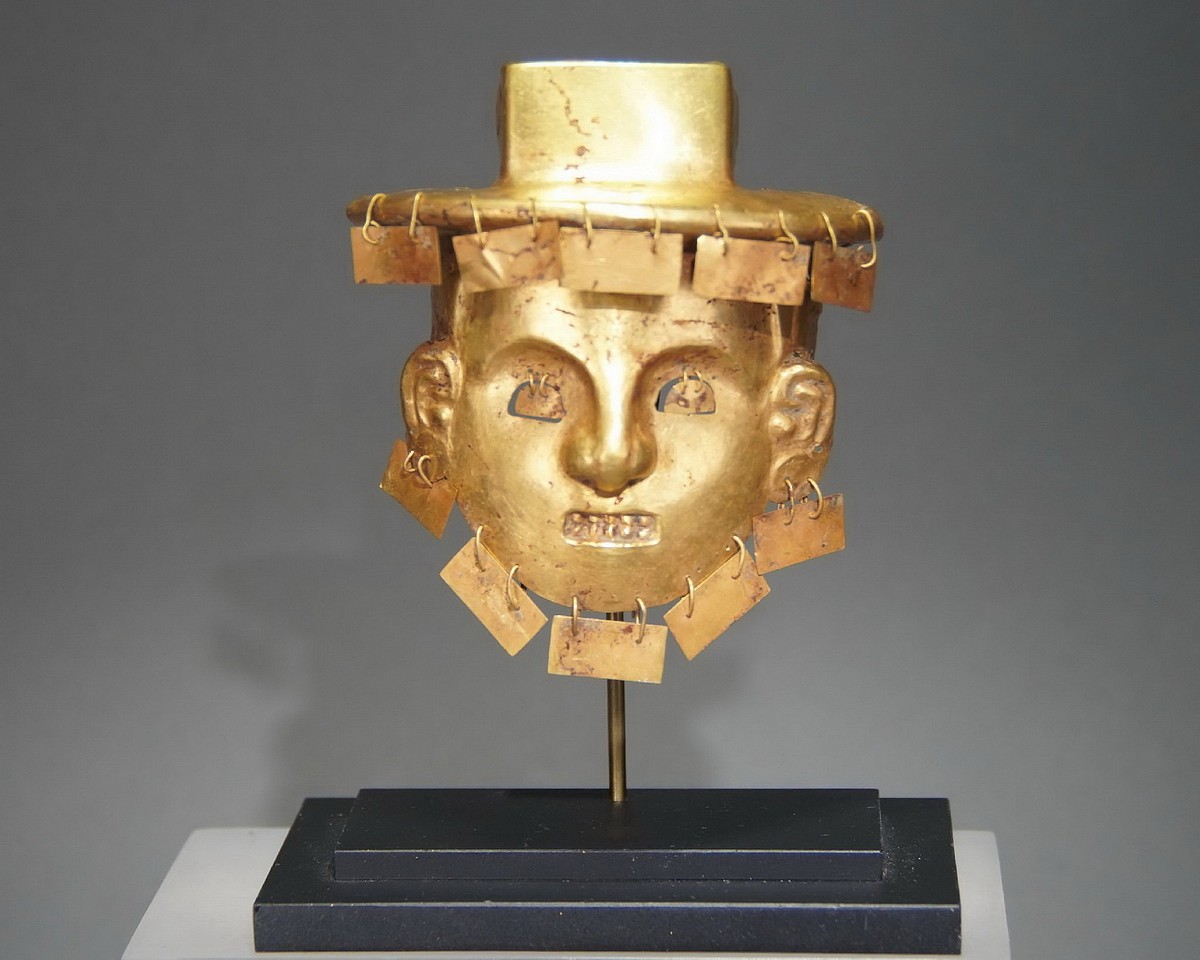





Colombia, Early Calima Gold Forged Maskette of a Deity with Dangles
This is a second type of a Calima face that appears less frequently. The features are reduced to the essentials: a small, modeled nose and brow, hemispherical eyes, and a rectangular mouth with prominent teeth. A slightly smaller gold face (9 centimeters) is illustrated in CALIMA AND MALAGANA, by Marianne Cardale Schrimpff, page 170. There are dangles for the eye, ears, and chin; the illustrated Maskette is missing the eye dangles. Ex. New York collector, prior to 1970.
Media: Metal
Dimensions: Height: 3 3/4"(9.5cm) x Weight: 39 grams.
Price Upon Request
P1005




Colombia, Early Calima Gold Lime Dipper
A fine lost wax cast lime dipper with a mythological monkey deity on the tip. The monkey wears a helmet, ear spools, and an elaborate headdress which falls down the back of his body. Lime dippers were used to mix lime with crushed leaves from the Erythroxylum coca plant (from which cocaine is derived) to create a drug compound that functioned as a psychoactive stimulant used in ritual ceremonies. According to the research, only limited types of imagery was used for lime dippers, usually shamans or warriors. See Calima and Malagana, by Marianne Cardale Schrimpff for further reading. A similar but not exact motif is also illustrated in Orfebreria Prehispanica de Colombia on page 84, plate # 5232.
Media: Metal
Dimensions: Length: 8 1/2" Weight: 25 grams.
$9,500
97146





Colombia, Early Calima Pair of Gold Hour-Glass Shaped Ear Spools
These spools are made from high karat gold sheets formed on balsa wood cores. The side seams were nailed shut, and the circular ends were crimped to the sides. These ends of the spools have embossed designs radiating around the central shaft. This style of earspool was worn in the ancient Americas by hanging from the ear lobe, suspended by a cord through the shaft. These were clearly intended to be a pair, weighing only a 1/2-gram difference. A very similar pair is illustrated in THE ART OF PRECOLUMBIAN GOLD: The Jan Mitchell Collection, page 194. Ex-collection Jan Mitchell, acquired prior to the 1980s.There are dents in the spool, and separated crimped edges.
Media: Metal
Dimensions: Height:2 1/4 " x Diameter: 2 " Gram Weight: 12.5 & 13 grams. each (total 25 grams.)
$8,500
p3066
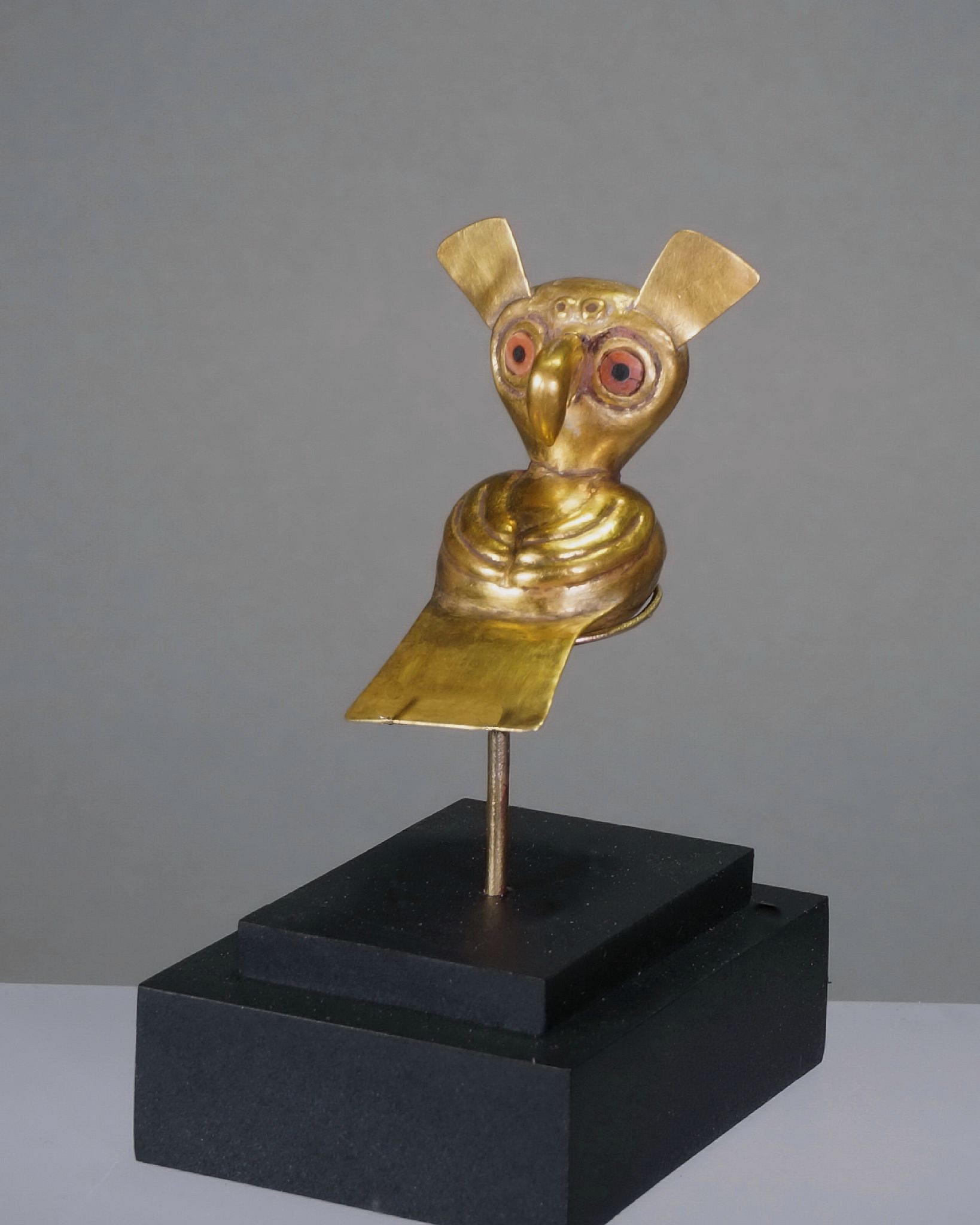



Peru, Early Moche Gold Owl Ornament or Necklace Element
This ornament portrays a stylized horned owl. The owl was revered by the ancient people for its special characteristics, such as silent flight, strong talons, and its ability to rotate its head 180 degrees. This gold owl has two suspension holes to the lower rear, which would have allowed it to hang looking downward. It is constructed from flat pieces of sheet gold that were hammered and beaten into repoussé parts, and then soldered together. Such three-dimensional forms were characteristic of the Transitional phase of gold work on the North Coast after the collapse of the ChavÃn culture. The eyes are made from Spondylus beads.
Media: Metal
Dimensions: Height: 1 1/4" X 1 1/4"/ Weight: 10 grams
Price Upon Request
M7015
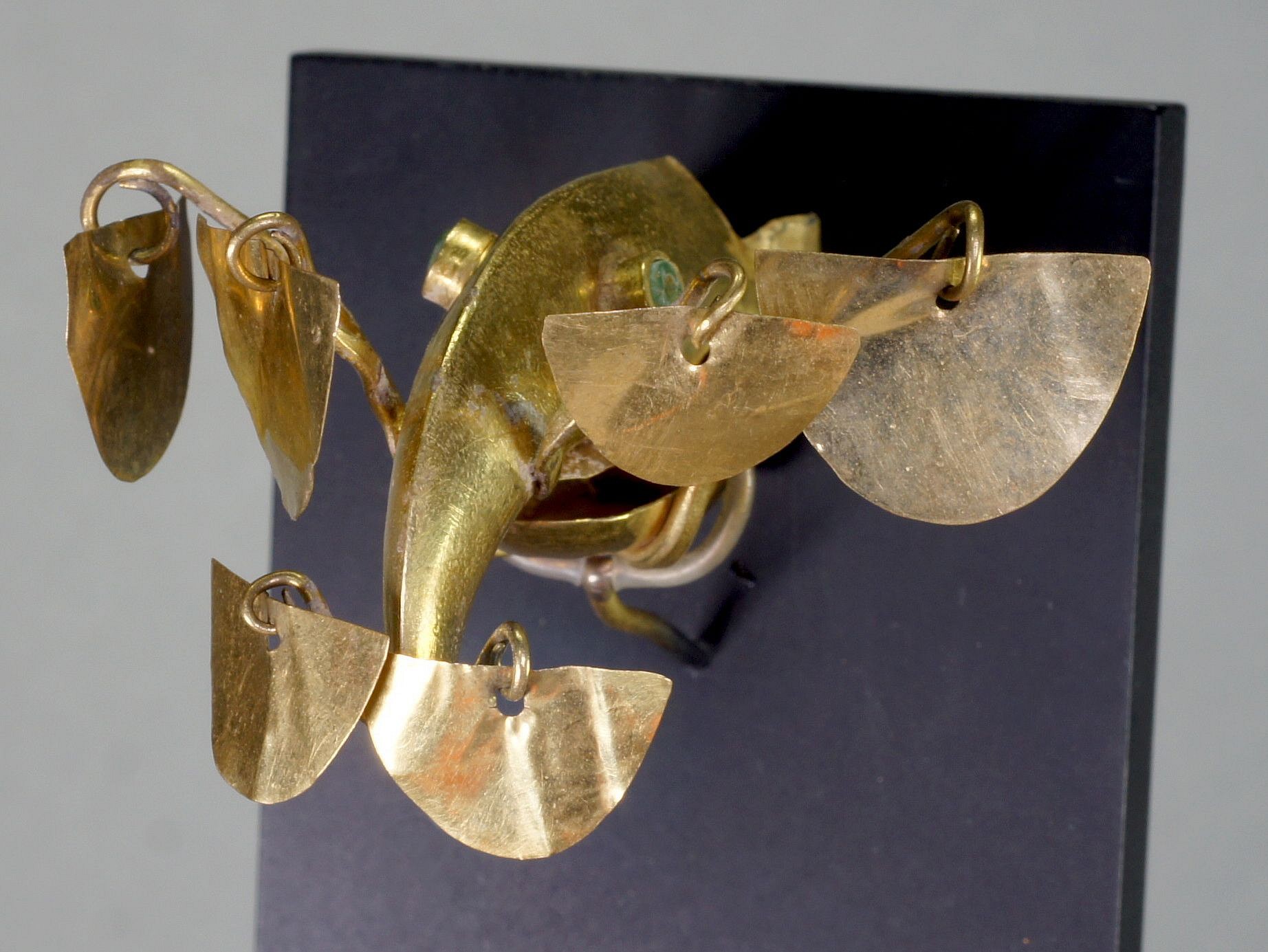



Peru, Early Moche/Vicus Head of a Tucan with Dangles
This object is quite rare and is from Northern Peru, by the Maranon river valley where other Vicus style objects have come from. It is fashioned from a heavy sheet, bent, soldered, and has dangles. It would have fit front and center onto a headdress, attached using the tabs at the back. The rods that hold the dangles are soldered, along with the bottom of the beak. The eyes are soldered rings with turquoise inlays. A similar object is illustrated in the GOLD OF PERU, Mujica Gaillo collection.
Media: Metal
Dimensions: Length 3 3/4" Weight 32.8 grams
$8,500
91055
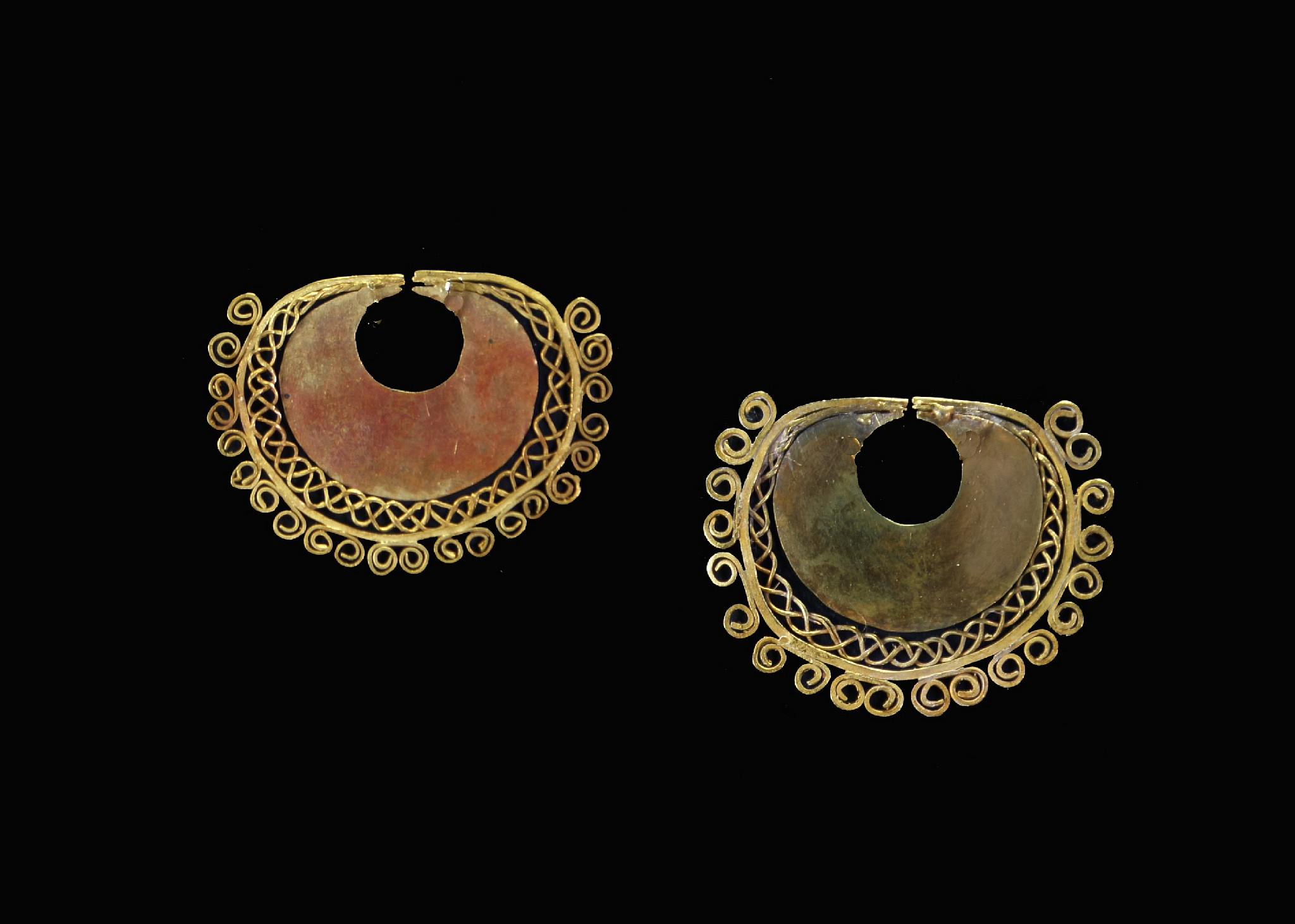
Peru, Early Nasca Gold Pair of Earrings with Filigree Decoration
A matched set of Nasca gold earrings with true filigree work and original archaeological patina. The wire is skillfully soldered to the central disc.
Media: Metal
Dimensions: Width 1 3/8" Weight: 3.8 grams
Price Upon Request
87044
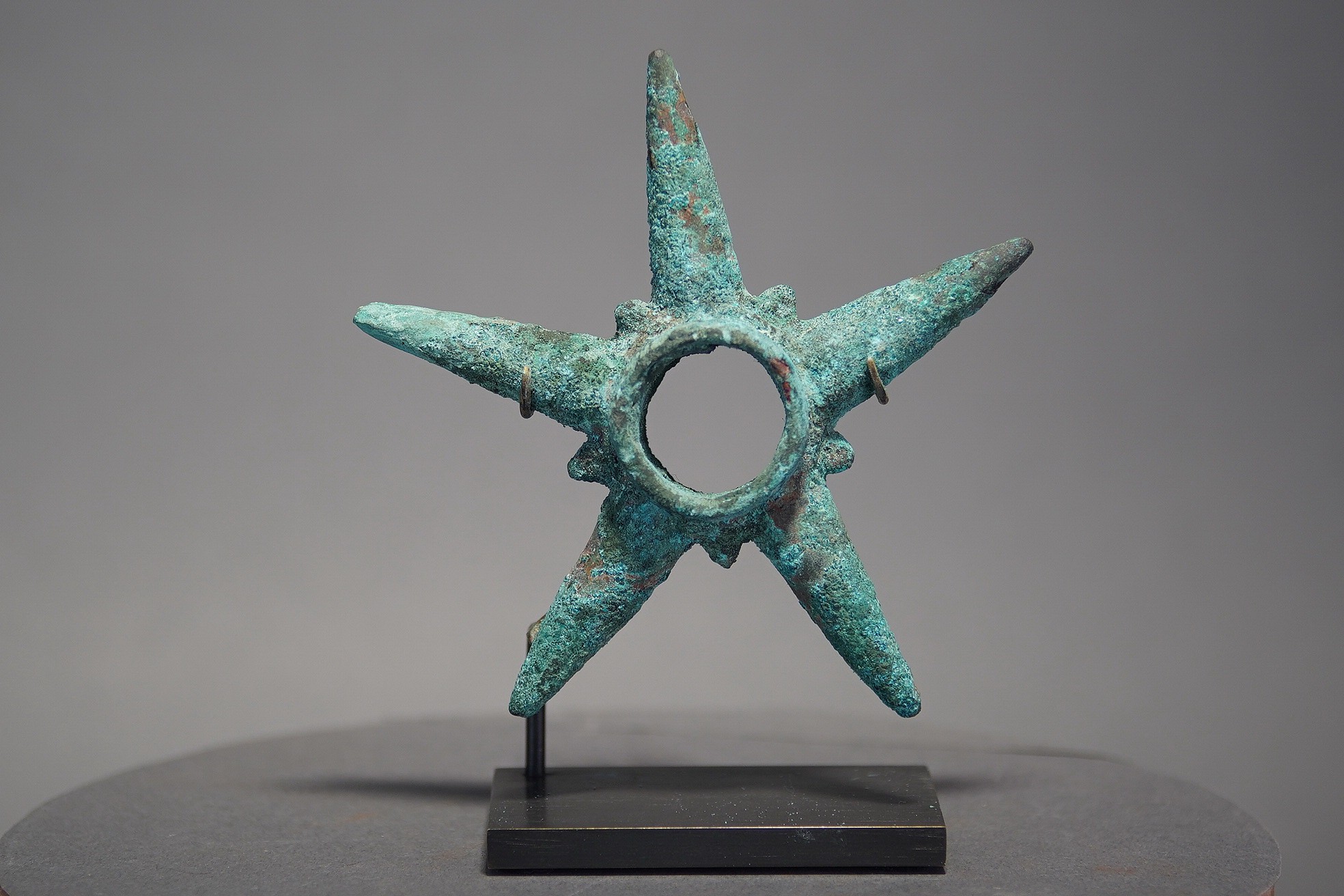



Peru, Inca Bronze Star Mace
This mace was well cast with a lost wax method. The Andean cultures utilized clobbering technology for their weapons, as opposed to swords and knives used in battle by their ancient European counterparts. The star motif was an Inca design and quite effective as a weapon. This mace was from the North Coast of Peru where they had arsenical bronze as opposed to Tin bronze found in the Southern highlands of Peru and Bolivia. Similar 5-pointed bronze maces are illustrated in Copper of Ancient Peru pg 425. Original patina, and intact in most places. Mounted on a custom-made base.
Media: Metal
Dimensions: Height: 4 1/2" x Width: 4 1/2"
$1,350
96120
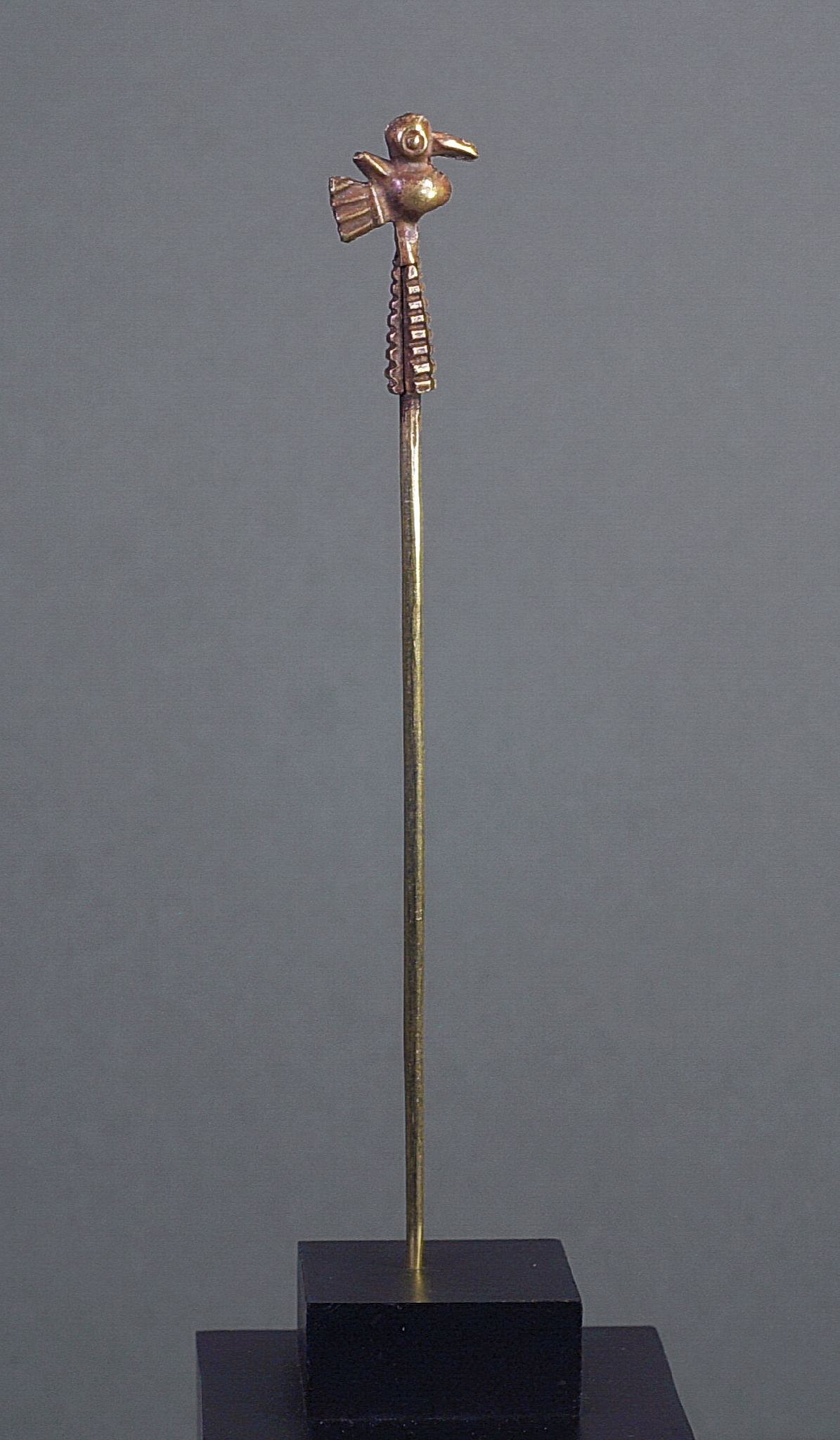





Peru, Inca Gold Fastening Pin Topped with Bird Perched on Corn Cob
Gold works of art from the Inca period is rare, as most Inca gold was confiscated and melted down by the Conquistadores during colonization. This apparently simple cast pin is quite complicated in its manufacture. The pin and the corn cob were cast, whereas the bird is made of a separate stamped sheet - designed head-to-head, bent, and soldered to itself. The bird was then fitted over the top to create the appearance of a single cast object. A similar piece appears in Kunst Und Kultur von Peru (Art and Culture of Peru) by Max Schmidt, page 396. From a private Florida collection, acquired prior to 1980.
Media: Metal
Dimensions: Length: 5" Weight: 4.7 grams.
$1,950
MM625
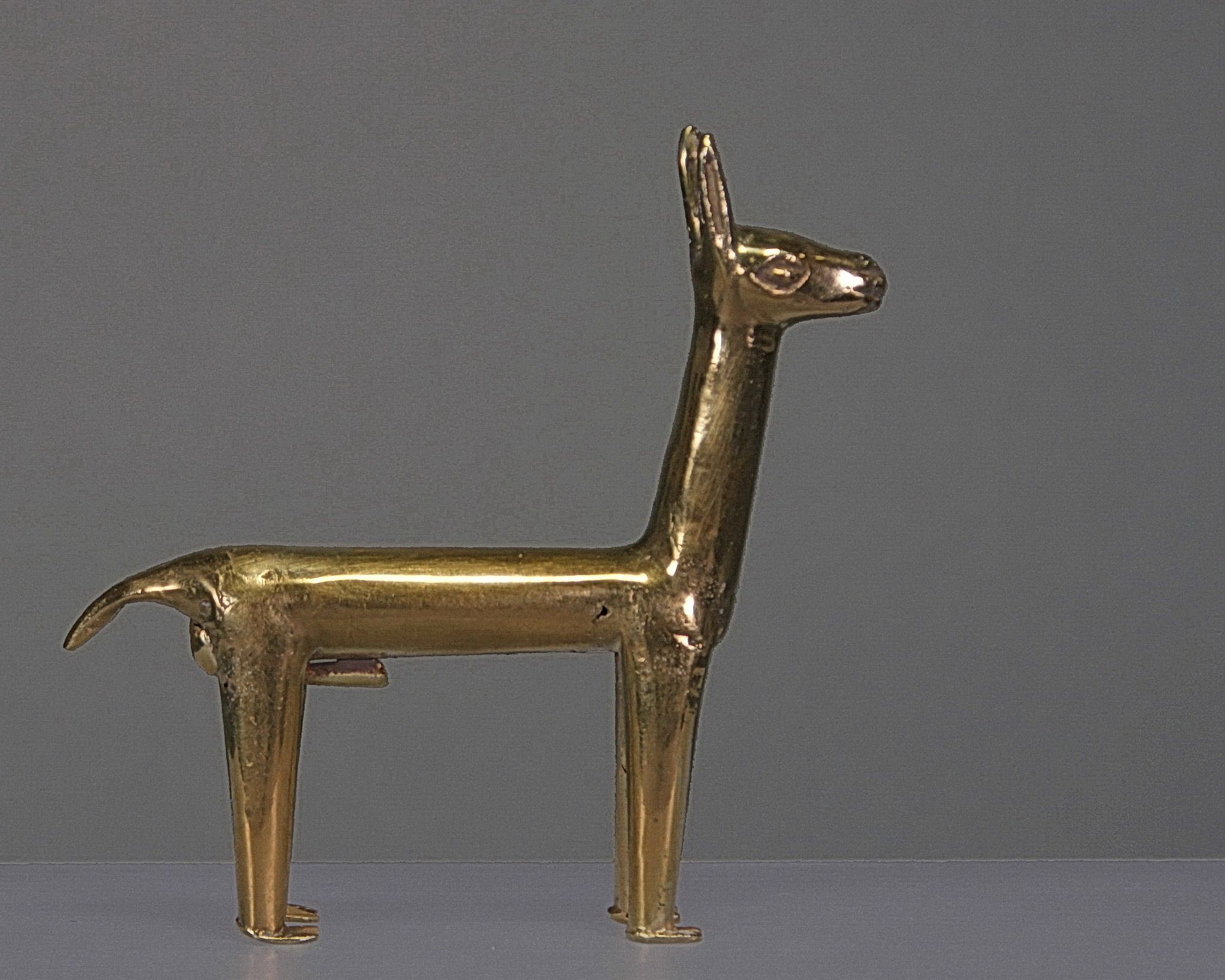




Peru, Inca Gold Hollow Llama
These Llamas, along with other miniatures in gold, silver and spondylus were found at high altitude sacrificial burials sites, used in a ceremony known as the Capac Hucha ceremony to praise the Inca. A similar llama is illustrated in ANCIENT AMERICANS, Art From Sacred Landscapes p. 362. This hollow llama was assembled from hammered gold sheets which were soldered together. One seam can be easily seen along the underside. Ex. New York collector, prior to 1970.
Media: Metal
Dimensions: Height: 2.5" Weight: grams 9.6
XRF: Au. 66.4%, Ag. 24.6% , Cu8.8%
Price Upon Request
n7053
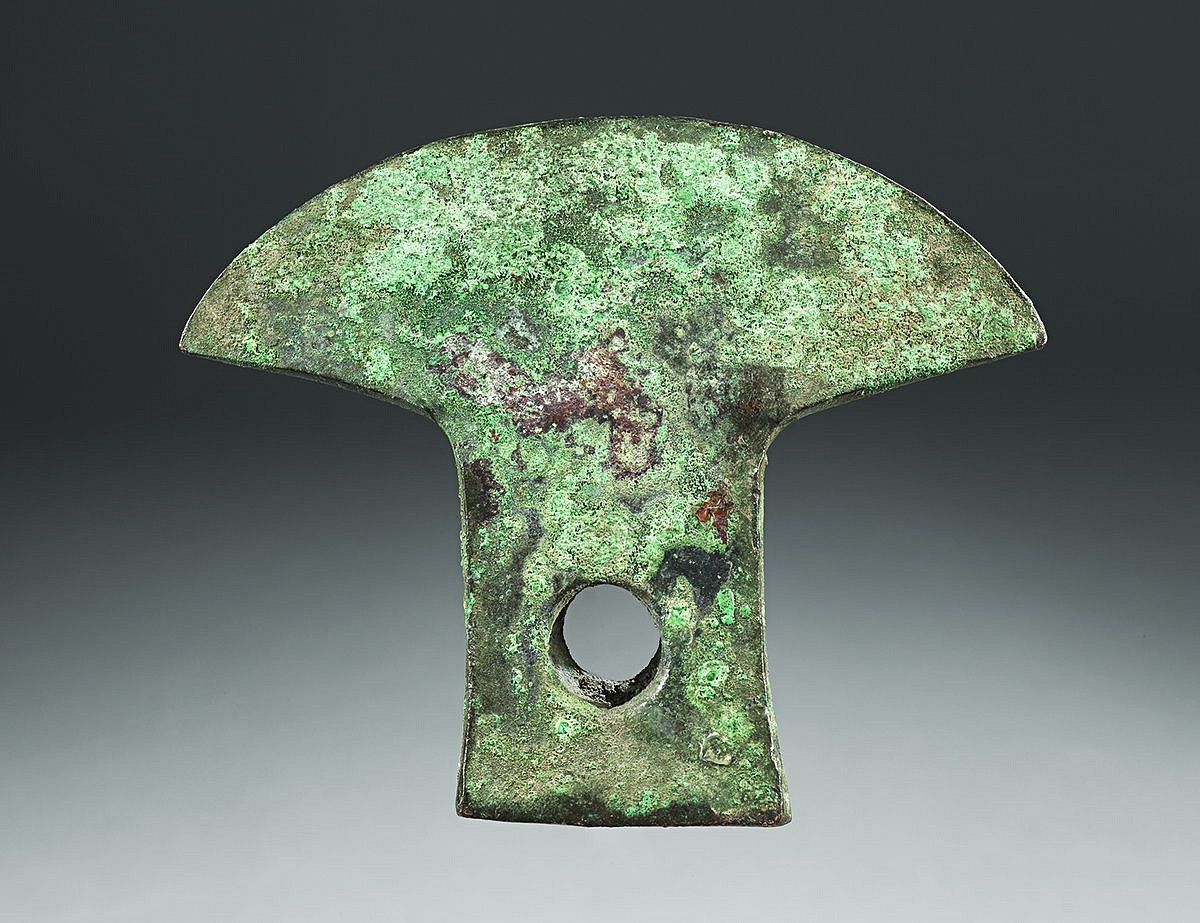


Peru, Inca Large Bronze Axe with Curved Blade
This blade exhibits classic Inca style, which employed crisp, clean, artistic lines, even for simple tools. It has a cast hole for attachment to the side of a shaft which it would have been lashed to. These axes were forged from tin bronze, the official metal of the Inca realm, in a process called slush casting. Molten bronze was poured into open molds. For more examples of lunate axes see Carcedo de Mufarech (1999: figs. 164 and 165).
Technical Features
The blade was annealed after casting to sharpen the cutting edge.
Media: Metal
Dimensions: Height 5" x Width: 5.75
XRF Data
Base: Ag 0.100 ,As 1.530 Cd 0.01, Cu 96.270, Mn 0.020, Ni 0.010, Pb 0.010, Sb 0.110, Se 0.100, Zn 0.01.
$1,200
MM228B
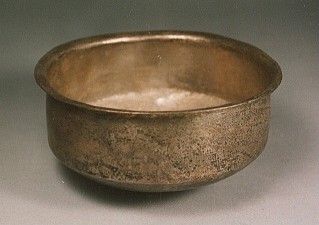
Peru, Inca Silver Bowl
An unusually high walled dish with flared edges, hammered from a single ingot of silver. It was repeatedly annealed and hammered to create a well-proportioned vessel.
Media: Metal
Dimensions: Diameter of bowl: 5 1/4 in., Height of flask:
$1,200
89400
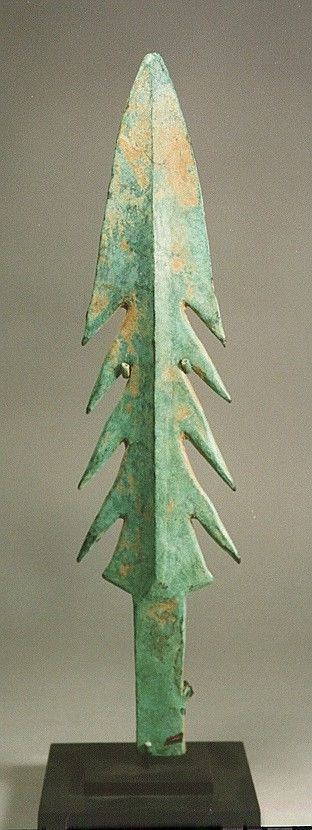


India, India- Gangetic Bronze Harpoon Point
A classic example of a Gangetic bronze harpoon point, which has been cast and chased with three additional sets of barbs. Ex Belgium collection prior to 1996.
Media: Metal
Dimensions: Height 11"
$2,750
94200a







Colombia, Large Cast Gold Sinu Pendant with Two Royal Faces
This unique pendant features classic Quimbaya iconography. The design depicts twin faces side by side, wearing crowns and earring ornaments, with large spirals framing the twin faces on both sides. Twins were considered lucky in Pre-Columbian cultures. On the back are a pair of vertical suspension tubes. This ornament was found in the Uruba region on the Panamian border, an area of varied trade with neighboring cultures, especially the Sinu, Darien, and Quimbaya. Formally in the collection of a private Texas collector, prior to 1970. The top of upper right plumb was broken and soldered back together. Acquired from a Texas collector.
Media: Metal
Dimensions: Height: 4 1/4" x Width: 8 5/8" Weight: 282 grams.
•SOLD
N6004








Colombia, Large Darien/Uruba Cast Gold Shaman
The Darien style is identified by the mushroom-shaped domes depicted atop the heads of shamanic figures. This male shaman is wearing a lunate nose ornament and has facial markings which may represent tattoos. He holds a bird in each hand, which could represent spiritual projection or physic flight. The spiral iconography is associated with the otherworld. The Uruba region borders Panama and was a major trading center with exposure to the stylistic traditions of surrounding cultures.
Media: Metal
Dimensions: Height: 6" x Width: 3 7/8" Weight: 199 grams.
•SOLD
N8010b
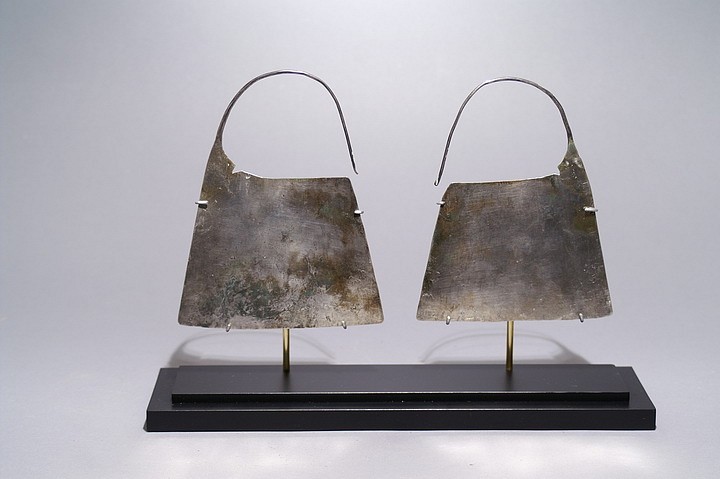


Chile, Large Mapuche Classic pair of Trapizoidal Shaped Ear Ornaments
Made out of one piece of hammered silver and are handed down in the family. Often The Mapuche word for this design of ear ornaments is "Upul" and are 19th century. They both have a repair with primitive mean indicating that they have had a lot of use over many years. Very large pairs hardly survived.
Media: Metal
Dimensions: Width 6"
$9,500
M9043
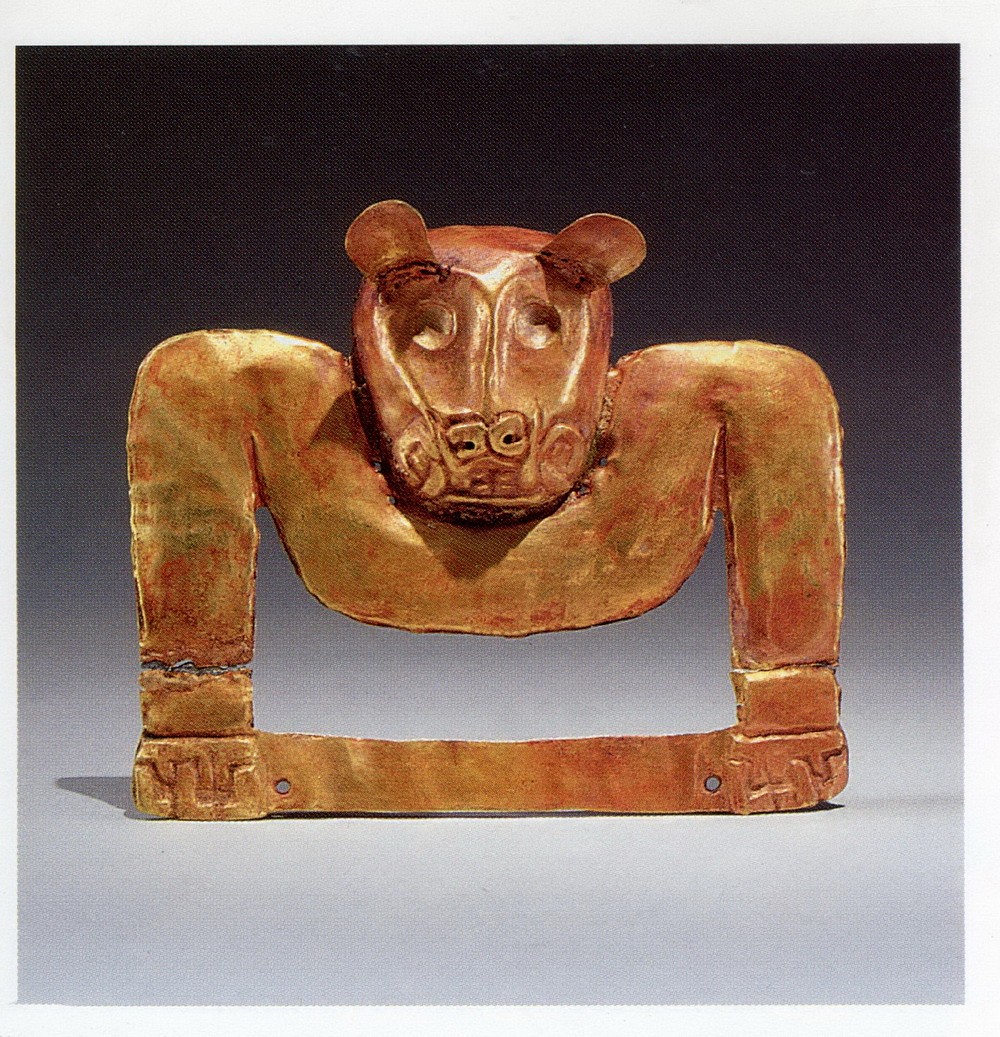



Peru, Late Chavin Hammered and Soldered Gold pendant with a Feline Head
This is a rare Chavin gold work that has been soldered - the ears to the head and the head to the body. There are two sets of suspension holes on each side of the mouth. There are two more suspension holes for danglers by each paw. There is repousse depicting the mouth and nose and on each paw. Estate of Bill Simmons, acquired at Sotheby's Sale # 7996, May 2004, lot 107.
Media: Metal
Dimensions: Height: 7cm x Width: 8.3cm Wt. 24.3 grams.
XRF Au 85%, Ag 13.3%, Cu 1.08%.
Price Upon Request
n8011
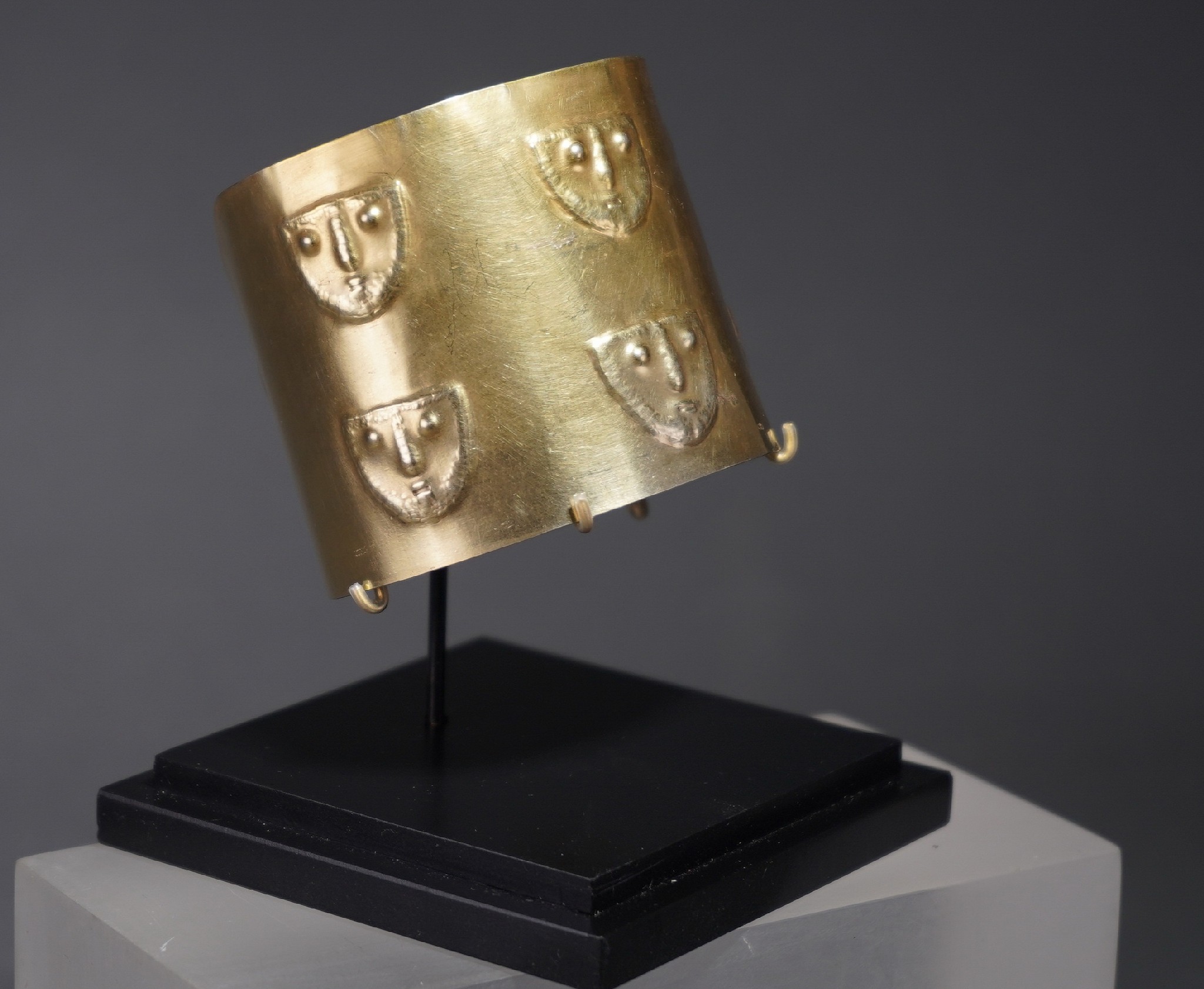





Peru, Late Nasca Gold Cuff with Embossed Faces
A hammered and repousse gold cuff decorated with two rows of faces, probably representing masks. I have not seen many cuffs embossed, as most Late Nasca art consists of simple wrought gold, occasionally with a geometric pattern. These embossed masks are quite rare. There are two tie holes on each edge of the cuff. Similar Nasca gold cuffs are illustrated in the THE GOLD OF PERU, MUJICA GAILLO COLLECTION. Ex-Collection Jean Eugene Lions, St. Tropez, since 1970.
Media: Metal
Dimensions: Height 2 1/4' Weight 40 grams
Alloy: Au.32.7, Ag. 55.3 & Cu.11.6 = 99.6%
$6,750
M5078
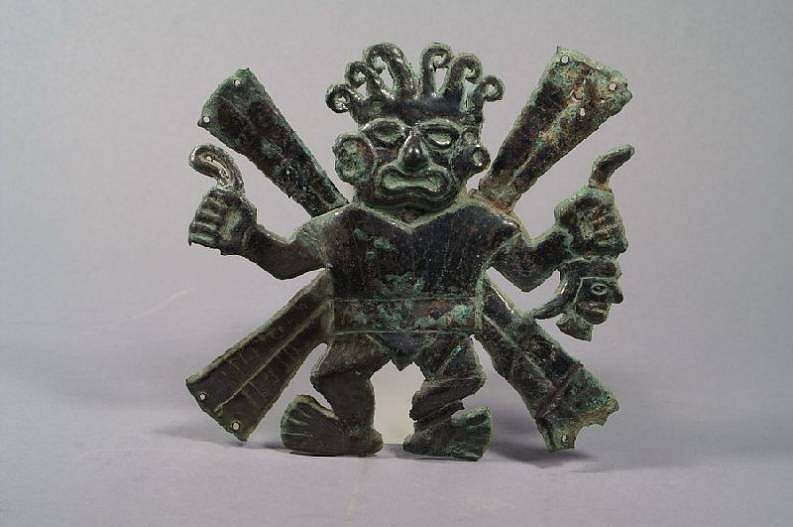



Peru, Loma Negra Copper Applique of the Decapitator
Appliques of this supernatural were sewn in series on woven textiles such as tunics and banners. The figure is known as the Decapitator, who has a distinctive mouth and often fangs, and whose right hand holds a tumi knife (blade lost) and a trophy head in the left. There are two holes in each diagonal of the ornament for attachment to a garment. A similar example is on display at the Metropolitan Museum of Art (New York, NY); more are illustrated in Lapiner (1976: figs. 350 and 382) and Carcedo de Mufarech (1999: 364). Loma Negra was a royal cemetery discovered about 1968 near the modern day city of Piura on the far north coast of Peru. From the tombs came exquisite Moche works in metal, mostly copper, with silver and gold objects as well, in sets of different sizes. The Decapitator is also called Ai Apec, the god who took off the heads of captives with his crescent bladed tumi knife. In another guise, he is Wrinkle Face, an aged deity with the same open mouth and fangs. The plaques seem to have been specific to the Loma Negra region, although the theme of the Decapitator dates back to the Chav�n period (Bawden 1999: 150-151). Scholarly research indicates that the overall form of the Decapitator on Loma Negra plaques was based on the body of an outstretched spider.
Media: Metal
Dimensions: Height: 5 1/2" x Width: 6"
Price Upon Request
98249
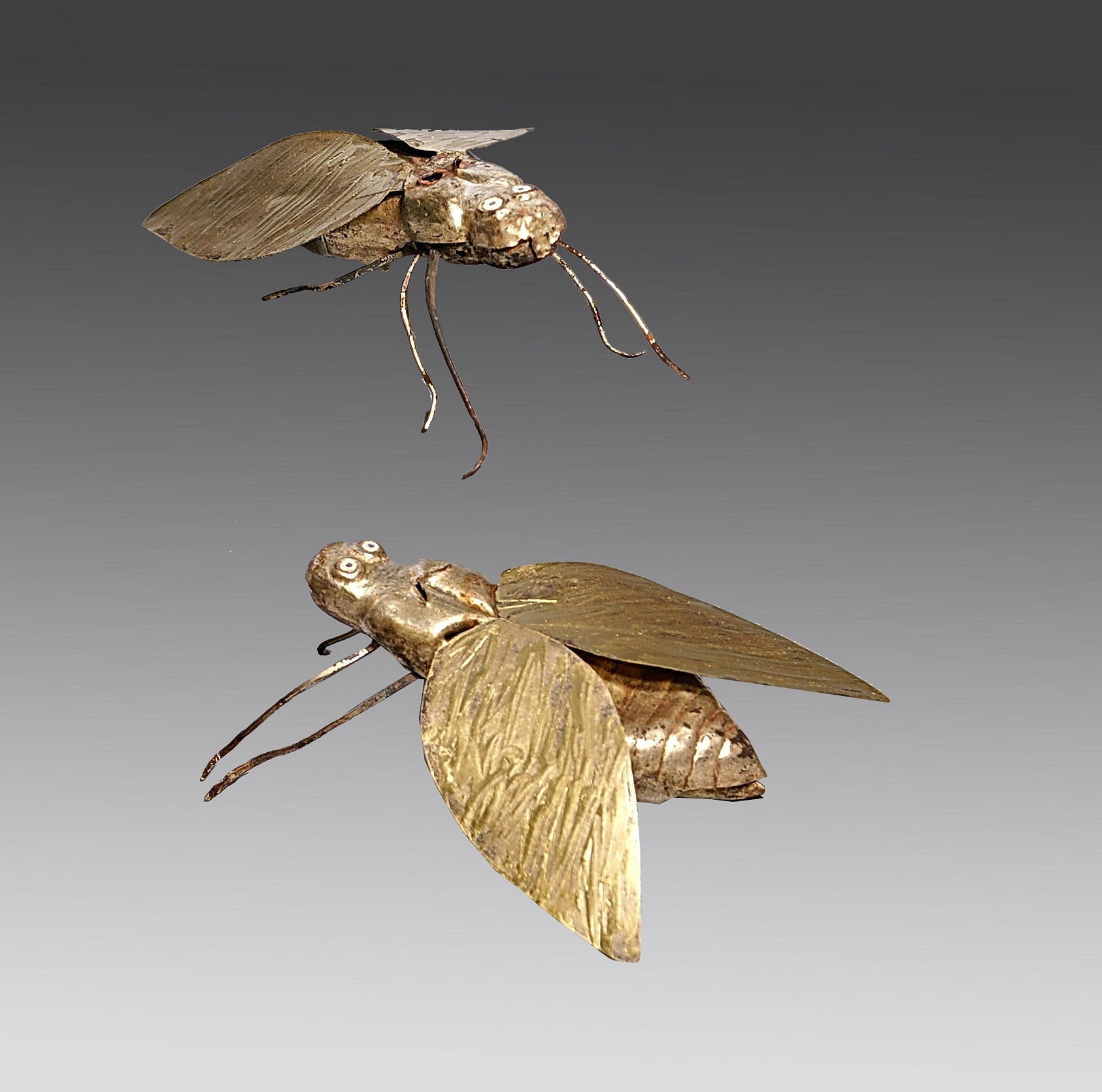




Peru, Loma Negra Gilt Copper Pair of Hoverflies
The flies are examples of a highly skilled gilding technique over copper. The construction is of tab and hammered and shaped parts to create a three-dimensional body. This was preferred in Peru over lost wax casting. Loma Negra Royal tombs were found in Northern Peru in the 1960's. The largest holdings of this material are in the Metropolitan Museum of Art. Other examples of critters are illustrated in PRE-COLUMBIAN ART of South America by Alan Lapiner, fig 376. There is a Loma Negra fly in the Met Museum ref 1981.459.28 in poor condition. Hoverflies are among the largest flies and have colorful bodies and are harmless. They often imitate bees or wasps as a survival technique to appear dangerous to their predators. The Peruvian favored animals that metamorphose, (eggs, large, maggots to flies) as proof that humans can transcend into spirits. Since hoverflies have colorful yellow and black bodies they connect with gold of the sun. These flies are considered large for Loma Negra creatures and have no apparent function.
Media: Metal
Dimensions: Length 4 1/2" x Width with wings 4" Height :1 1/2"
$15,000
M9067




Peru, Loma Negra Gold Crescent-Shaped Headdress Frontis Piece
The headdress ornament has two sets of attachment points which would have been used to attach it to an elaborate headdress for an important personage. The Loma Negra archaeological site was discovered in the early 1960s and was later understood to be an early royal Moche tomb complex. Acquired by descent from Jan Mitchell to his sons, prior to the 1980s.
Media: Metal
Dimensions: Height: 7 1/8 " x Width: 9 " Gram Weight: 50.8
$7,500
p3064
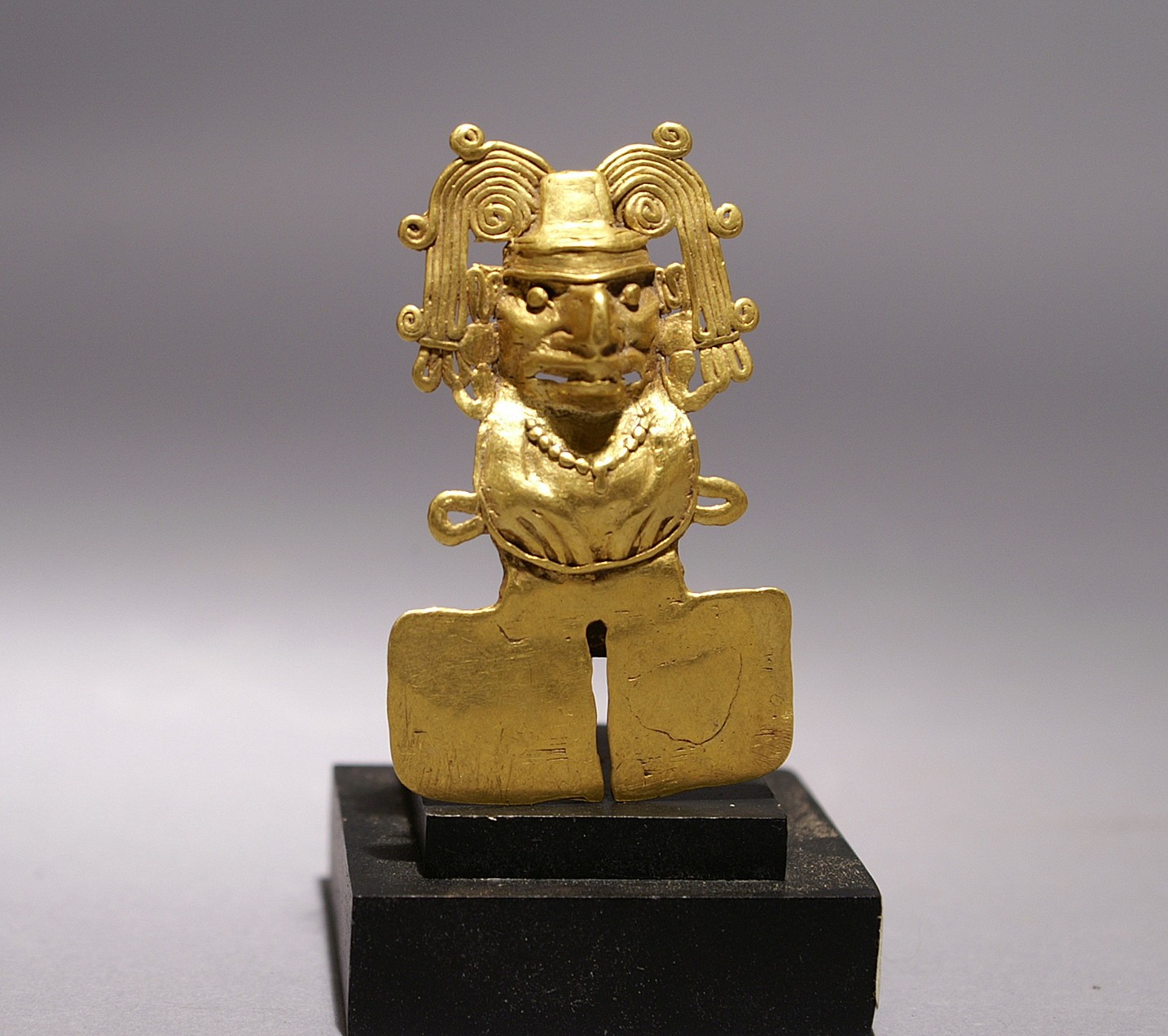


Mexico, Mixtec Gold Figural Pendant of Xochipilli with ornate headdress.
Superbly cast pendendt of Xochipilli, the price of flowers in the lost wax tradition. This is a particularly fine but small example of exqusit detail.
Media: Metal
Dimensions: Height 2 1/4"
Price Upon Request
99307
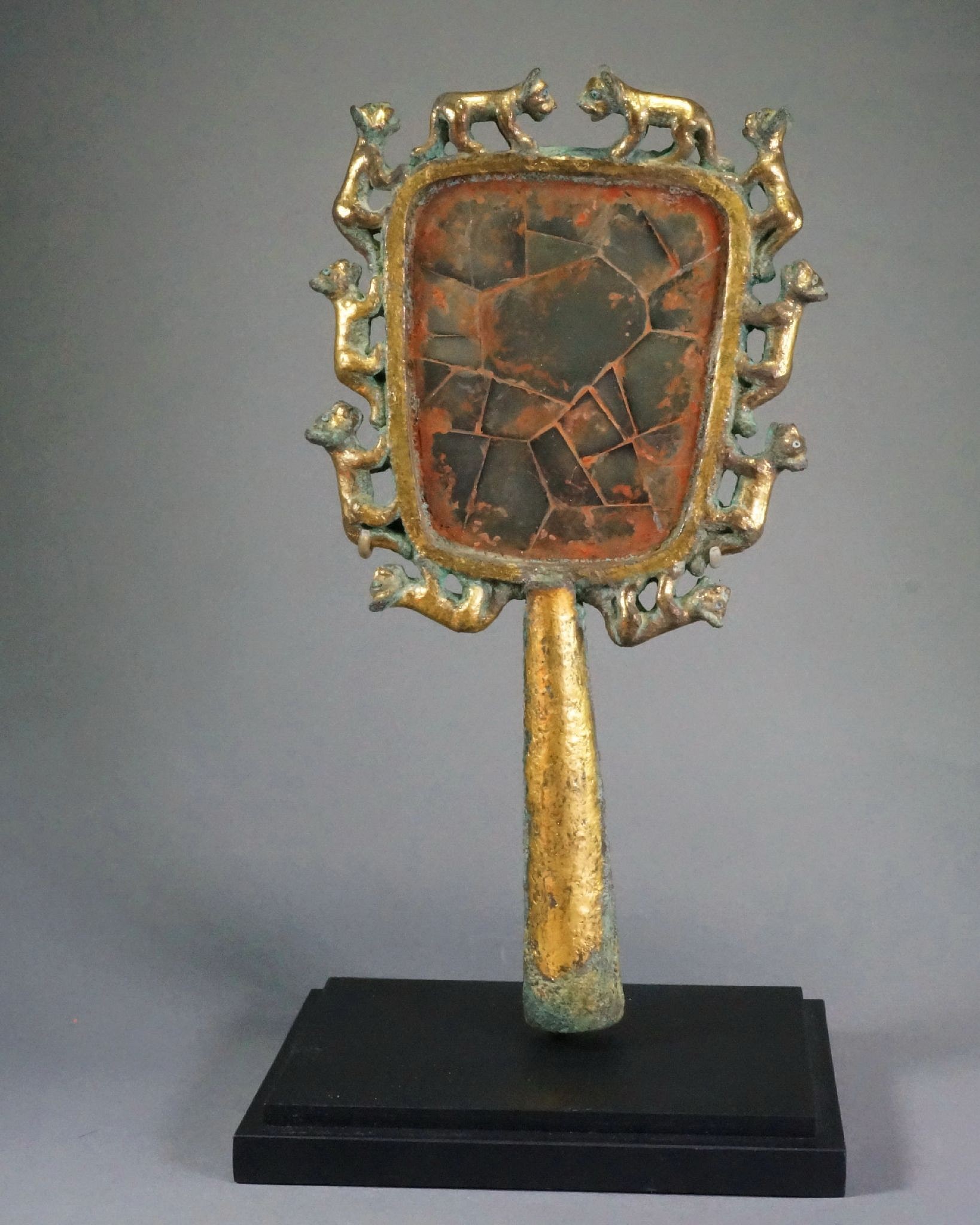




Peru, Moche Cast Copper Gilt Handled Mirror Surrounded by Ten Pumas
Hand-held mirrors are rare from any Peruvian cultures, and those few that are known are carved from wood, except one other gilt copper one that is in the Metropolitan Museum of Art. Mirrors were important objects for high status individuals and symbolized the power of the sun. Both mirrors were found at the Loma Negra site of far North Peru, excavated in the 1960’s, and were made by the same workshop. The mirrors have different themes: the Met’s with birds, and this one with felines.
Both mirrors were constructed in the same manner - cast frames are mechanically attached to the handle with a separate sheet of copper backing to hold pyrite mirror fragments in place. The Met’s mirror has lost most of its original gilding. This mirror has more of the original gilt surface intact and has a reconstructed mirror of ancient pyrite, whereas the Met’s mirror was restored with wax and coated with silver foil. The felines surrounding the frame were individually modeled and cast as one with the frame, an extremely difficult technical accomplishment. Each puma has carved turquoise eyes. The few other known mirrors with handles which have been found were carved from wood. There are no other known mirrors with metal frames according to Dr. Christopher Donnan formerly at UCLA and the world expert on Moche Art.
To read an essay about this mirror, click here.
Media: Metal
Dimensions: Height: 9 1/4"(23.5cm) x Width: 5"(12.6cm)
Price Upon Request
n7005
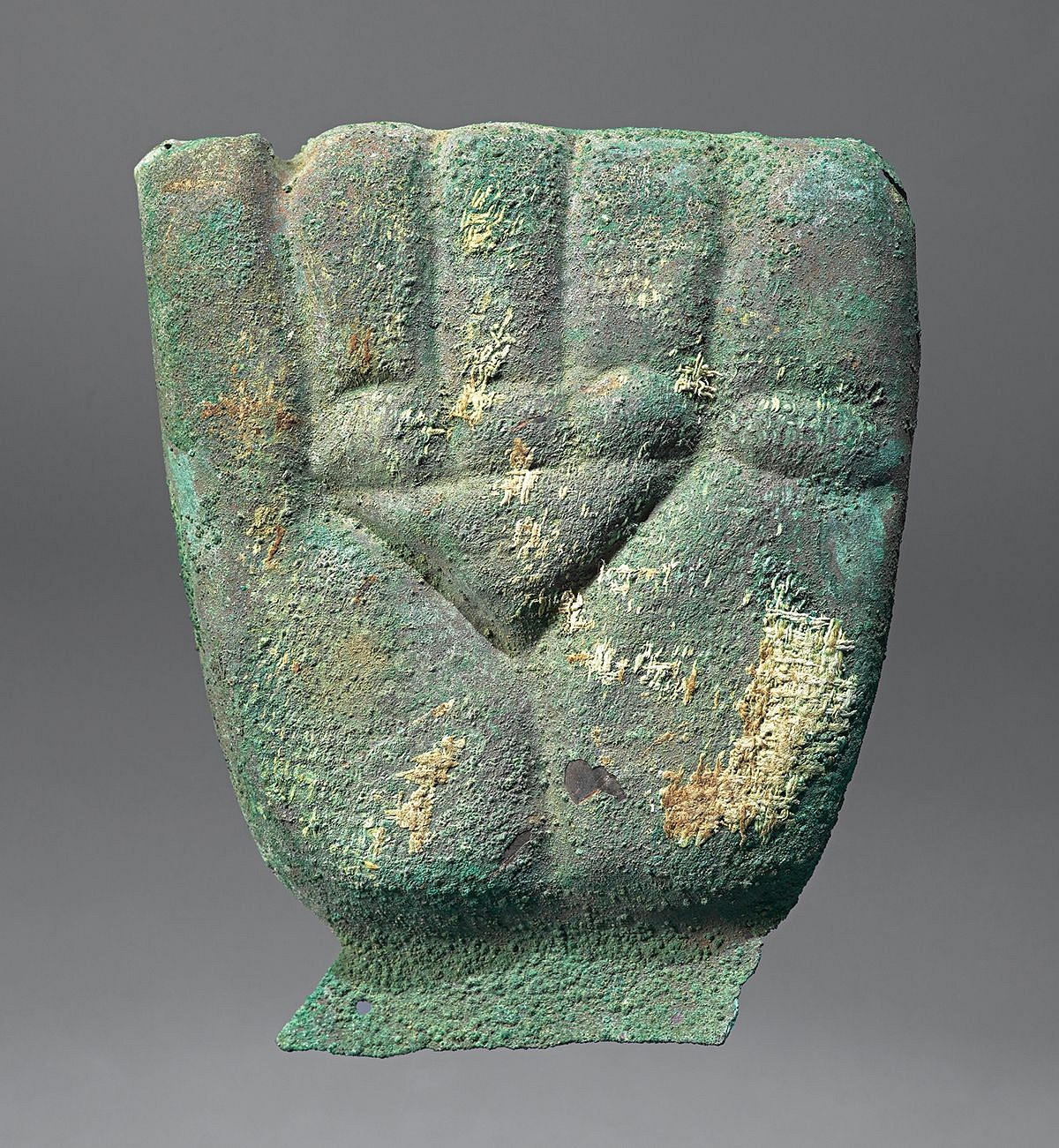
Peru, Moche Copper Hand
This hand was hammered and raised over a wooden model. It is a clenched fist with fingernails to the palm. The right hand belonged to a set of separate pieces, including face mask, torso, feet and hands that were sewn onto a cloth banner and placed over the deceased, such as found in a tomb at Sipán (Alva and Donnan 1993: 65-66). The authors also illustrate a Moche vessel with two figures holding banners. A similar set of face mask, feet and hands is illustrated in Carcedo de Mufarech (1999: fig. 39).
Media: Metal
Dimensions: Height: 12.5 cm; Width: 9.7 cm
$1,500
97107 B
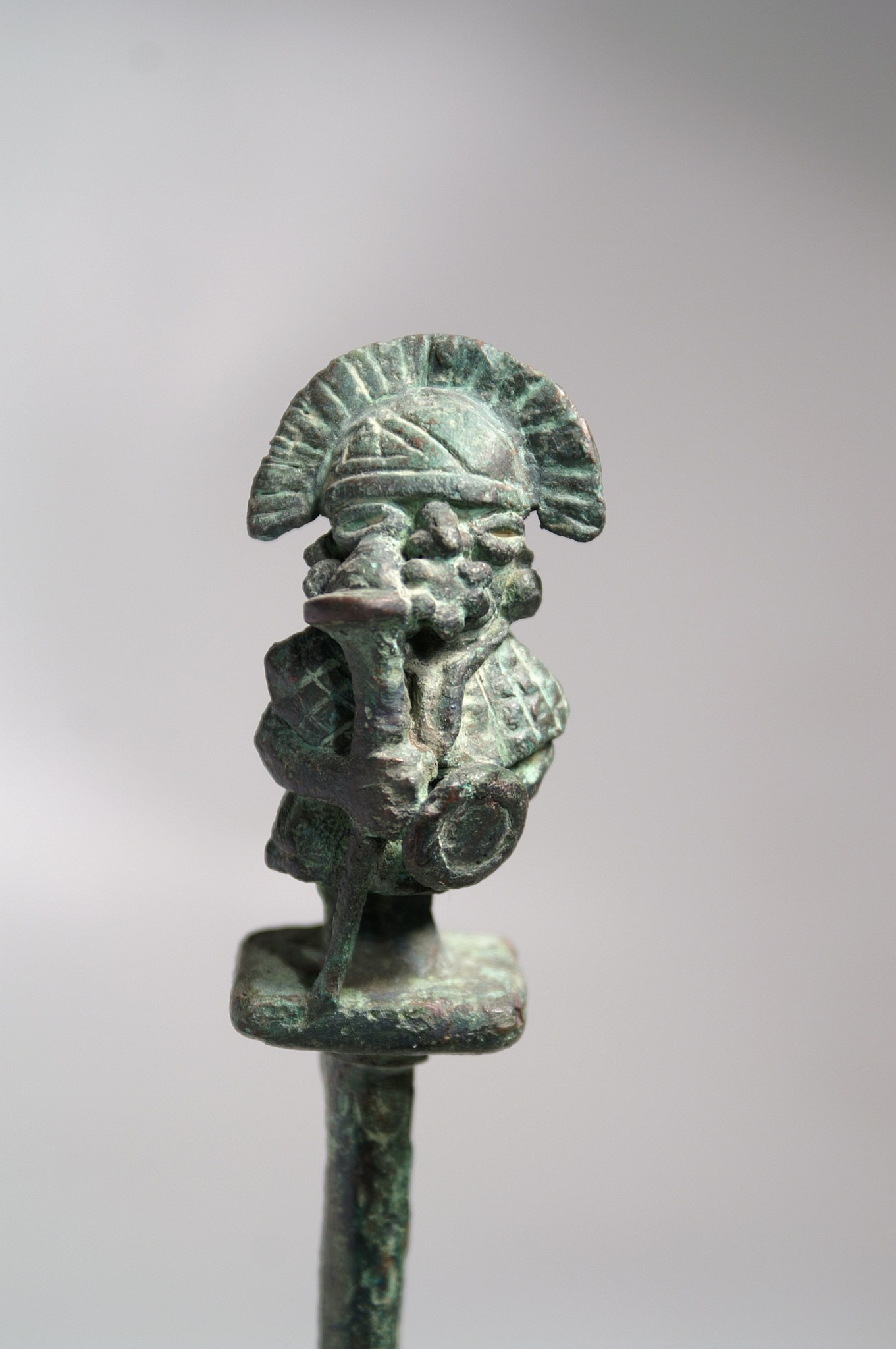







Peru, Moche Copper Spatula of a Warrior-lord with staff and shield
A warrior lord is spledidly dressed in full regalia wearing a helmet with feather crescent headdress, woven tunic, semi-circular nose ring and ear ornaments. He holds the standard long war club and round shield, such as appear in scenes of battle on fineline painted vessels. A small feline is splayed across the figure's back, wearing a necklace or belt of small owl heads. This work was cast in one piece in the lost-wax process. Spatulas were symbols of power for the high status Moche and were used in coca rituals to communicate with the ancestors and spirits of the otherworld. There is a suspension loop under the upper platform to be hung from a belt or the neck.
Media: Metal
Dimensions: Height 8 1/2"
$5,500
98343
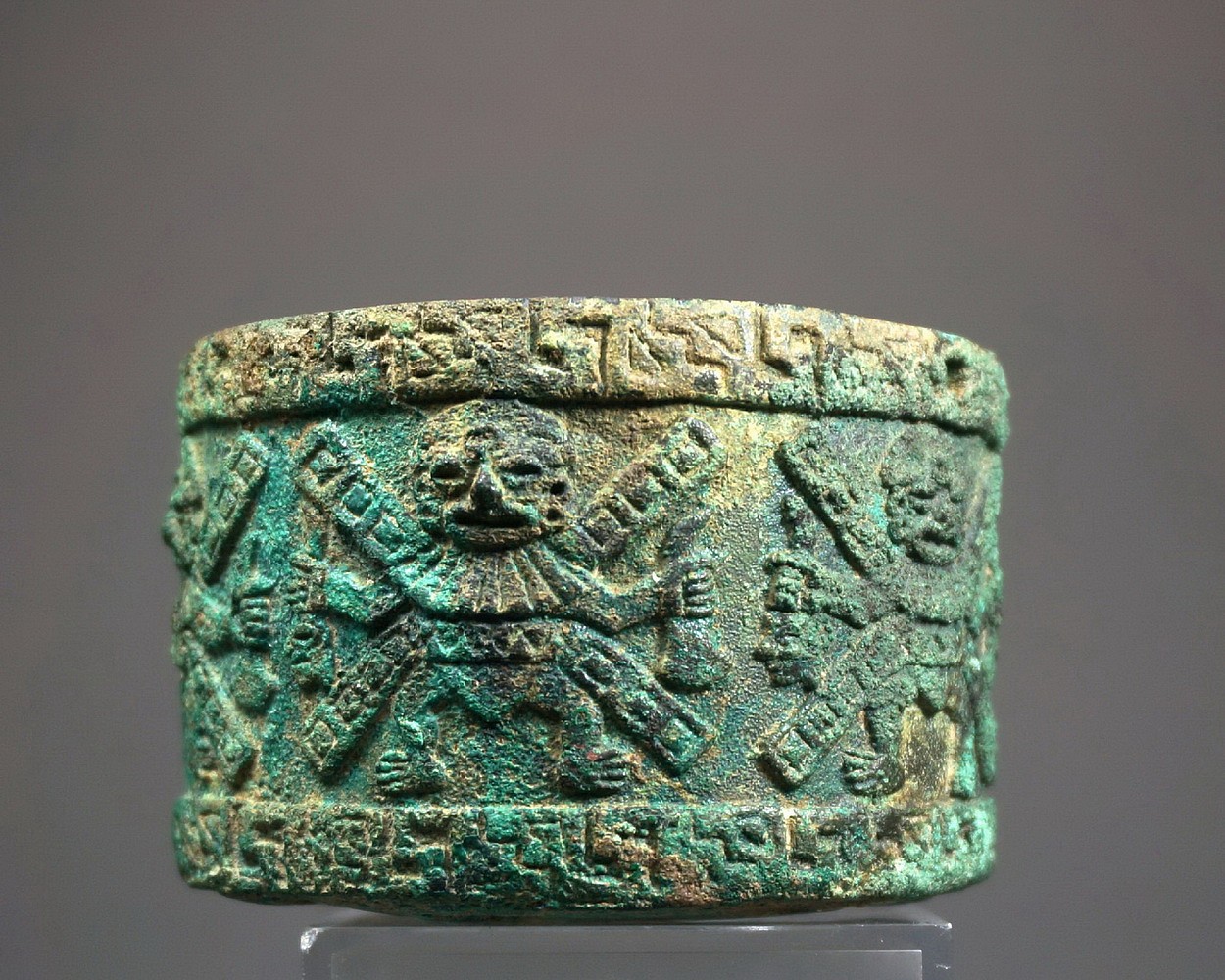









Peru, Moche Cylindrical Container with 6 Decapitators in High Relief
The container has a cover with an incised drawing of a weapons bundle. It’s a very rare object and is constructed with a complicated double wall technique. The outer wall was embossed by hammering the thin copper sheet against a wooden form carved with the figures. The inner wall is a plane sheet and annealed to the outer sheet and hammered around a form in the shape of bottom disc.
Media: Metal
Dimensions: Height: 2 1/4" x Diamerter: 3" Circumfrence: : 10"
$12,000
n4013







Peru, Moche Gold Bead in the Form of a Tree Snail
The emergence of snails signals the start of the rainy season, indicating prosperity and abundance. The tree snail, Strophoceheilus, is featured in fineline drawings on the sides of Moche ceramic vessels depicting "snail hunters" in the foothills of the Andes. This bead is made in two parts, with the bottom expertly soldered to the spiral cone-shaped shell. The snail's foot is exposed inside the shell. The shell also functions as a bell, with two copper beads inside that rattle when worn. Originally from a larger necklace of snail beads, each with two sets of suspension holes on the bottom. Illustrated in Oro del Antiguo Peru, lam.183. Ex. collection Benno Mattel, by descent to his daughter Karin Ashburn.
Media: Metal
Dimensions: Height: 2" x Width: 2 1/2" Weight: 36.4 gm.
$27,500
n8018
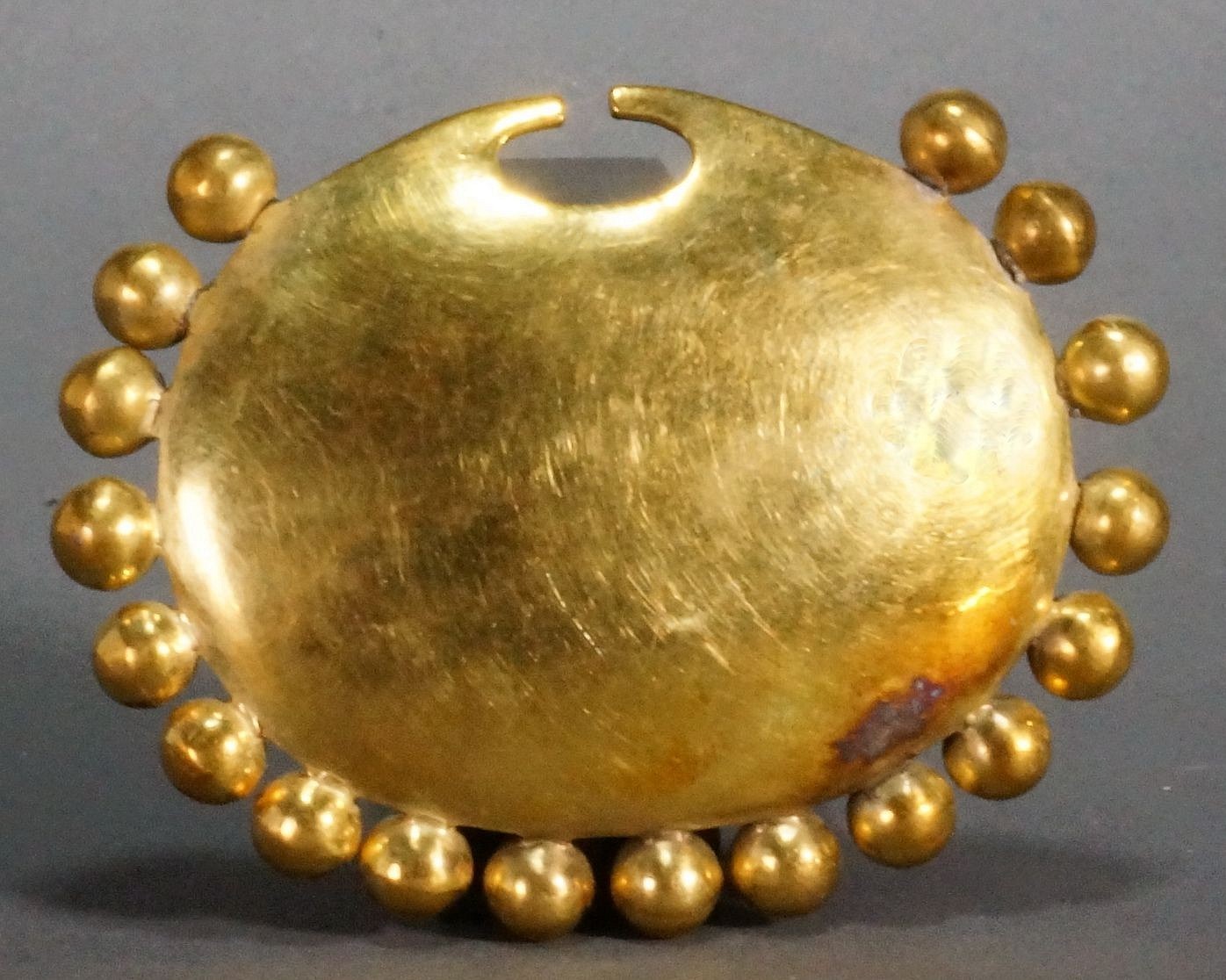



Peru, Moche Gold Nose Ornament Surrounded with 18 Spheres
Each of the spheres are individually soldered to the base. Illustrated in Oro del Antiguo Peru, plate 134. From a Texas collector, acquired prior to the 1970s.
Media: Metal
Dimensions: Height: 2 1/4" x Width: 2 3/4" Weight: 27.3 grams.
$18,000
n8020




Peru, Moche Gold Nose Ornament with Hummingbird in a Tree
This delicately crafted hummingbird figure features inlaid turquoise eyes and geometric danglers. This is an excellent example of Moche soldering and filigree workmanship
Media: Metal
Dimensions: Width: 1 1/2" x Depth: 1 1/2" Weight; 8 grams.
•SOLD
90166



Peru, Moche Gold Pincer with Embossed Large-Eared Bat Face
Pincers have been found from as early as the Vicus period (pre-Moche), circa 300 BC and were thought to be used to pluck facial hair. Few are known from the Moche period and most of the pincers that have been found were from the Chimu and Inca periods. This pincer has an embossed face of a bat with fanged teeth. The bottom of the pincher features a beautiful, flared design, representing a Moche back-flap. It was made from one single hammered sheet of high carat gold and then embossed twice on a carved wood form, then bent at the middle to create an identical front and back. There is a suspension hole in the middle. Ex. collection Magret Brenner, Zurich.
Media: Metal
Dimensions: Height: 2 1/4" x Width: 1 1/4" Weight: 16.5 grams.
$9,750
n7012
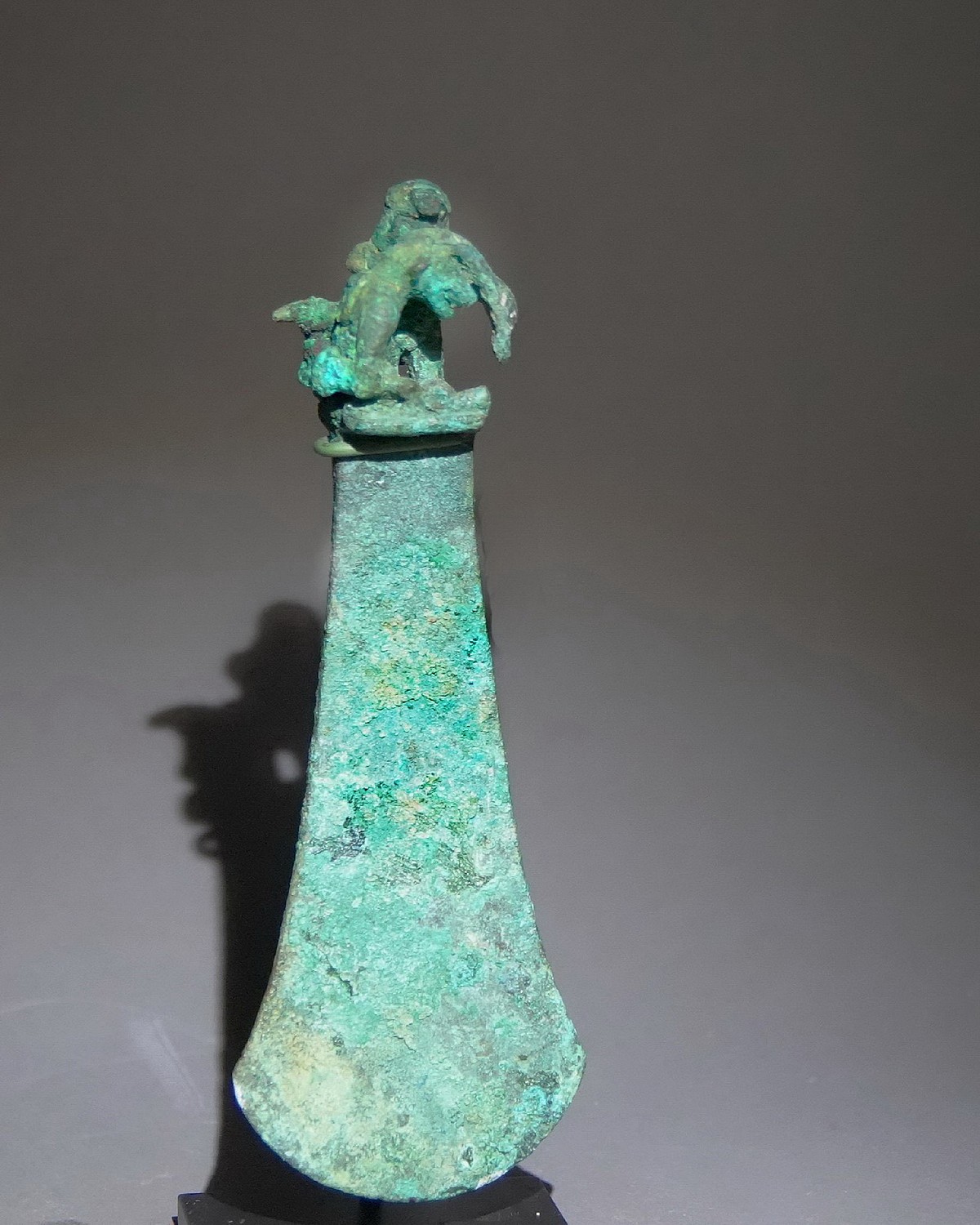





Peru, Moche Lost Wax Cast Bronze Tumi of a Warrior Capturing a Feline Deity
This classic tumi was lost wax cast using a single mold. There are two figures: a warrior and his victim, whom he holds by the hair. The victim, a feline deity, holds a tumi in one hand and a trophy head in the other.
Media: Metal
Dimensions: Height: 7 1/4" x Width: 2 1/2"
$6,000
P1037
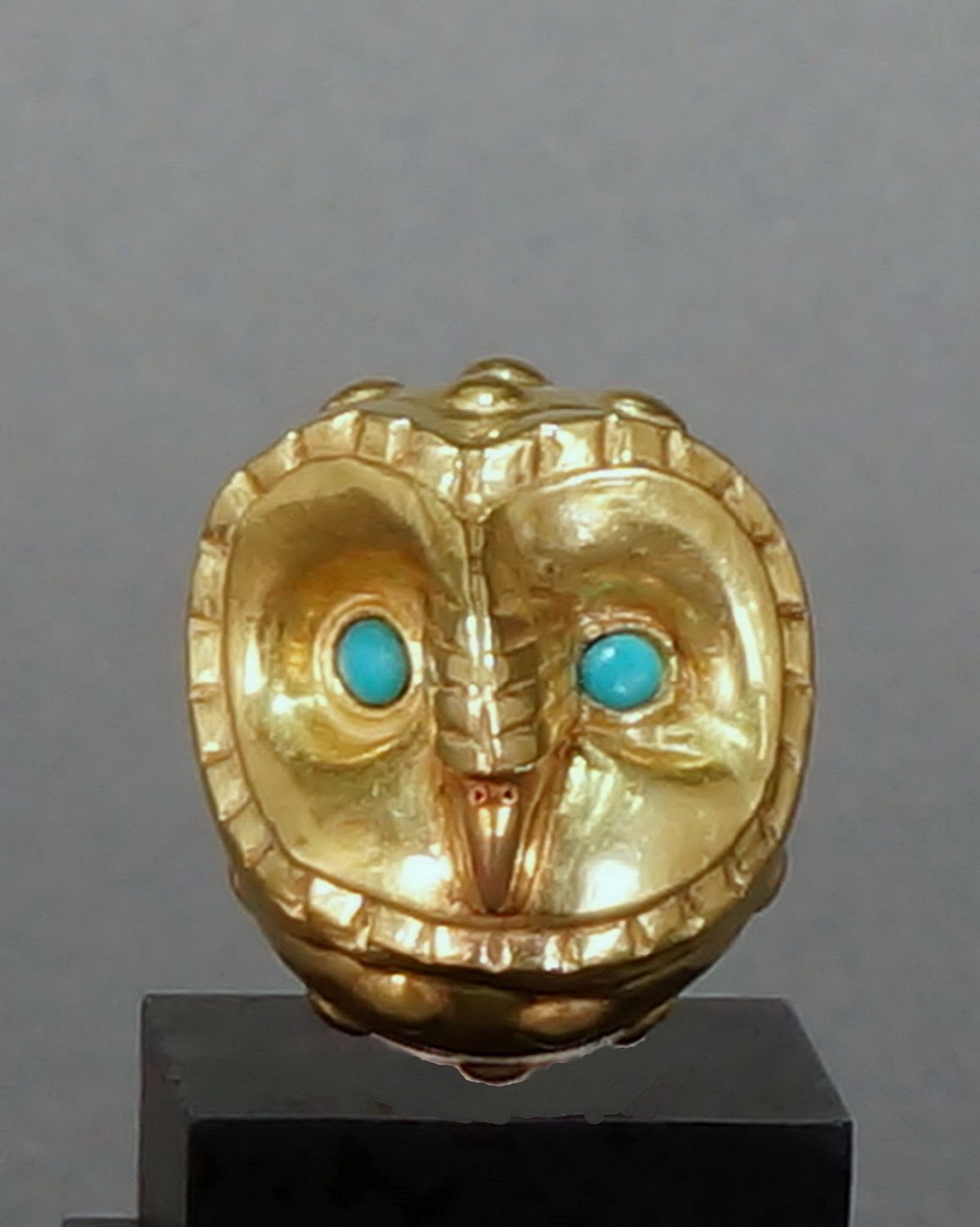





Peru, Moche Small Gold Male Condor Bead with Turquoise Eyes
This gold bead is identifiable as a male eagle by the caruncle on the beak. The beak itself is crated in a slightly reddish colored gold. It is made in two parts, expertly soldered. There are four suspension holes that allow for the bead to be hung upright. Ex Collection Benno Mattel, prior to 1970, by decent to his daughter Karin Ashburn.
Media: Metal
Dimensions: Height: 3.3cm x Depth: 3.2cm x Weight:10.2 grams
$5,000
n8021






Colombia, Muisca Cast Gold Erotic Male and Female
The female has her legs wrapped around a standing male as he holds her waist, creating the impression that the figures are engaged in sex. This sculpture has an ancient solid carbon core, which is still intact.From the Jan Mitchell collection, acquired prior to the 1970s, by descent to his sons.
Media: Metal
Dimensions: Height: 3 3/8" x Width: 1" Weight: 30 grams.
•SOLD
p1049
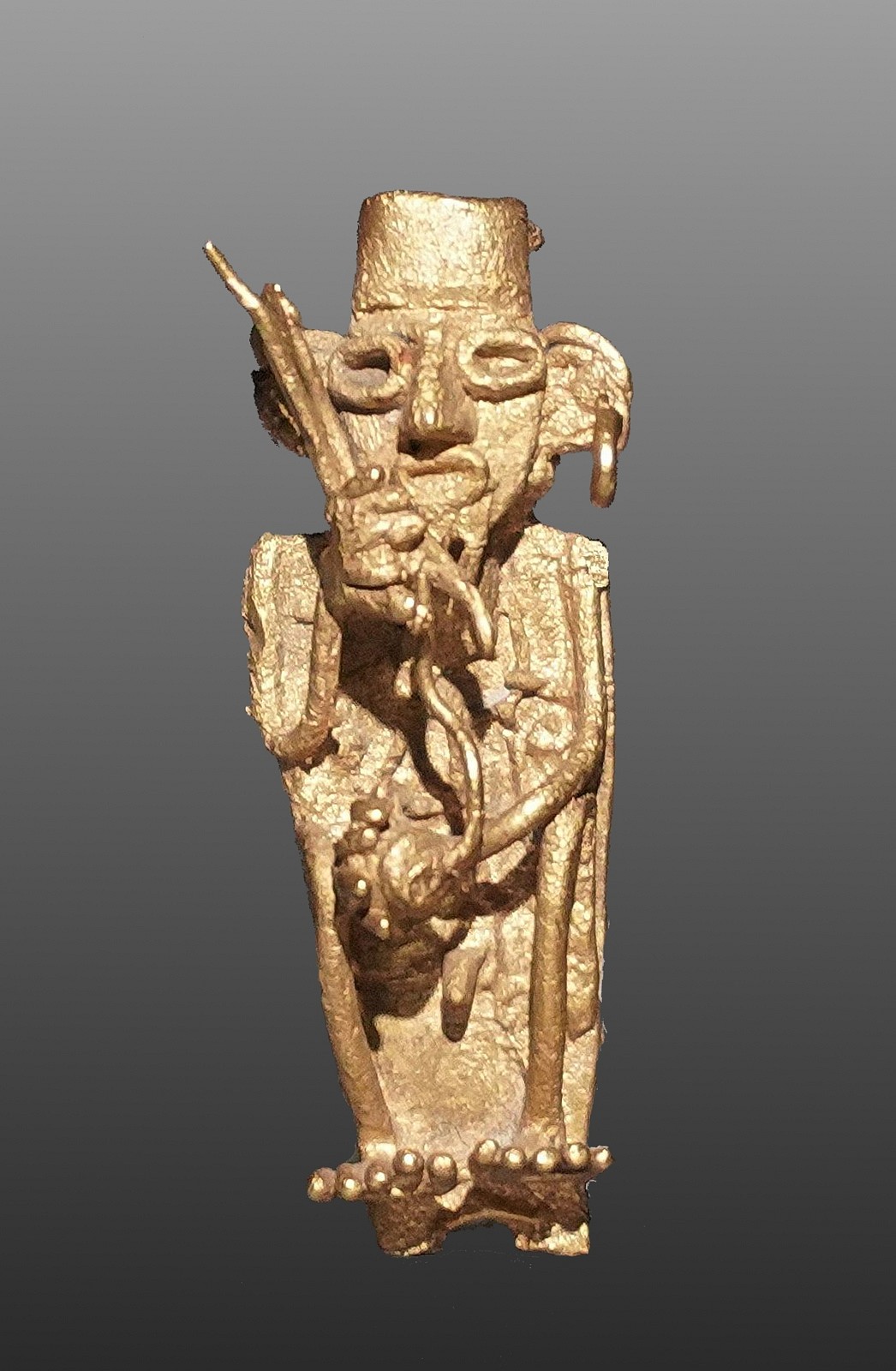




Colombia, Muisca Cast Gold Seated Warrior
This cast gold warrior holds a spear and spear thrower in one hand, and a slingshot in the other. He is wearing a hat, a necklace, and one remaining ear hoop. Contains an intact carbon core. From the Jan Mitchell collection, acquired prior to 1970, by descent to his sons.
Media: Metal
Dimensions: Height: 1 5/8" Weight: 22.1 grams.
•SOLD
p1051




Ecuador, Narino Gold Annealed Nose Ornament with Four Diamonds within a Square
This nose ornament is one of the largest examples from a cache of gold artifacts found in a tomb in the 1950s in Ecuador. The ornament uses an optical illusion to create the appearance of diamond-shaped cutouts, which are made of multiple quadrangle cut-outs. There are suspension holes for dangles above each square. This ornament is an excellent example of depletion gilding, a technique which brings the gold in the metal alloy to the surface through repeatedly heating the metal and rinsing it with acid. Similar examples are illustrated in MASTERWORKS OF PRE-COLUMBIAN GOLD: The Glassell Collections of The Museum of Fine Arts, Houston, p.151, and in The Art of Pre-Columbian Gold: The Jan Mitchell Collection, p.59. Similar examples are also published in The Gold of Eldorado by Warwick Bray, on p. 218. Ex-Jan Mitchell collection, acquired prior to the 1980s, by descent to his son David Mitchell.
Media: Metal
Dimensions: Height: 2.75" x Width 7.9" Weight: 41.5 grams.
$16,000
n7050

Colombia, Narino Gold Disc Shaped Mirror with Single Suspension Hole
A similar disc is illustrated in The Art of Pre-Columbian Gold: The Jan Mitchell Collection. This disc is also from the Jan Mitchell collection, acquired prior to 1980.
Media: Metal
Dimensions: Diameter: 5 " Gram Weight: 56.9 grams.
$8,500
p3063
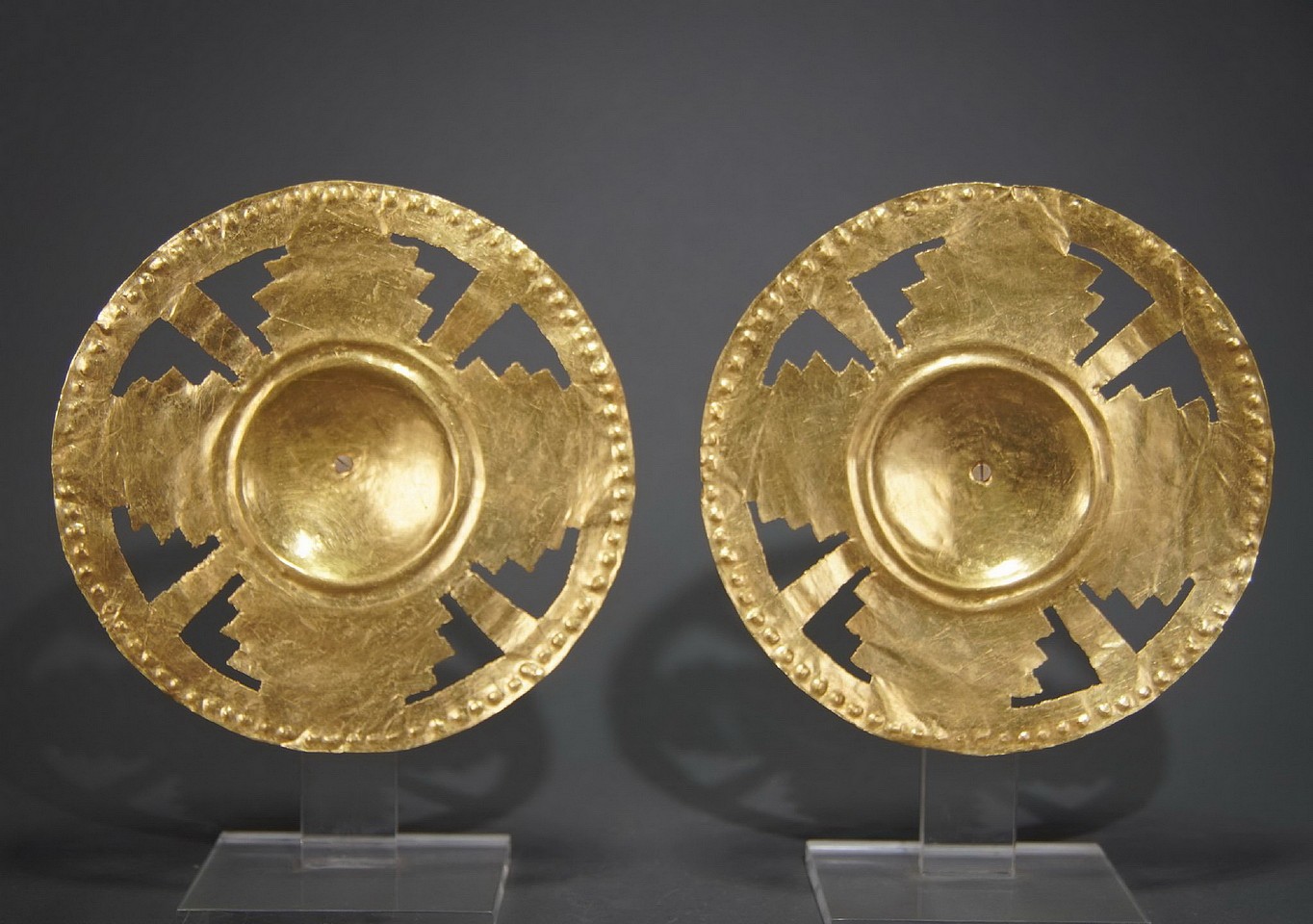



Colombia, Pair of Sinu Gold Ear Ornaments with Cutout Step Design
Around the outer rim is an embossed design. Each ornament is almost the same size and weight. Ex-Jan Mitchell collection, prior to 1970.
Media: Metal
Dimensions: Diameter 5" each. Weight: 40.7grams & 40.4 grams.
Price Upon Request
P1004








Colombia, Pair of Sinu Gold Fan-Shaped Ear Ornaments (SOLD)
These beautiful lost-wax cast "False Filigree" style pendants each feature six sections of latticework separated by simple bands. The false filigree technique was favored by the Sinu goldsmiths. The larger the ornament, the higher the status of the wearer. These ear ornaments are illustrated in the Met Museum's Catalog, THE ART OF PRECOLUMBIAN GOLD: The Jan Mitchell Collection, pg. 164. Estate of Jan Mitchell, prior to 1970.
Media: Metal
Dimensions: Height: 2 1/2" x Width: 4 3/8" Weight: 67.5 grams.
$27,000
p1022
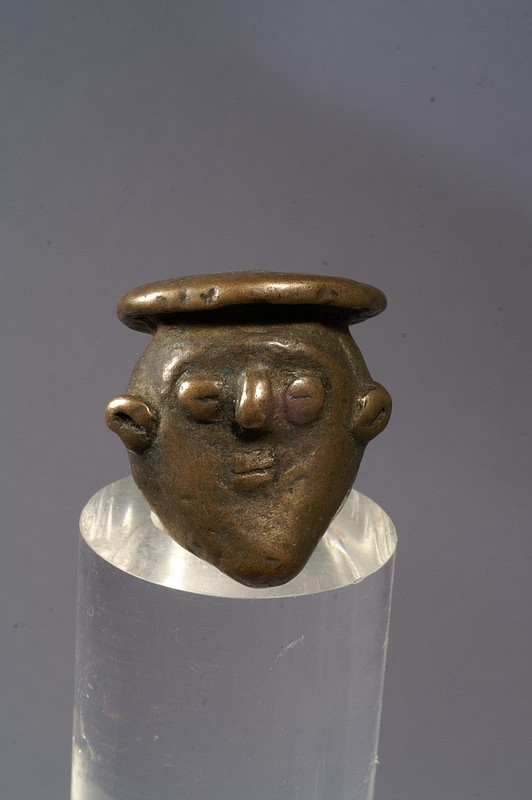



Bolivia, Pre-lnka Broze Bola for Throwing Weapon
Figurative bolas are rare, originating near Lake Titicaca, which straddles the border between modern Peru and Bolivia. These ornate weighted bronze heads high prestige versions of utilitarian bolas, which were used as counterweights at the end of length of rope or rawhide to form a hunting weapon or lasso. Referred to ayllas in the Quechua language or boleadoras in Spanish, these weapons were used to capture game such as llamas and guanacos by entangling their legs and knocking them down to the ground. Each weight is cast with an opening at the top for inserting and knotting cord. This bola features a stylized but characterful face portrays a highland dignitary sporting distinctive headgear, a marker of ethnic identity across the Andean world. Arthur Posnansky discusses related styles of bronze cudgels and boleadaras in his 1986 text, Tihuanacu: The Cradle of American Man. vol. 3/4, pages 84 and 88.
Media: Metal
Dimensions: Height: 1 3/4"
$2,200
M7005A











Colombia, Quimbaya Cast Gold Pendant Depicting a Seated Queen in a Trance
This seated queen is elaborately dressed, to include a crown with 19 birds facing downwards, a U-shaped nose ornament, two sets of spiral-shaped ear ornaments, and a five-strand necklace. Her face is delicately sculptured with her eyes closed as if she were in a trance, and she holds a popuro in each hand. This is fine example of an early cast gold piece of good size. Similar pendants in museum collections include: the Museo del Oro in Bogota, the Museo de las Americas in Madrid, the Glassell Collection at the Houston Museum of Fine Arts, and the Dora Janssen Collection in Antwerp. Private Texas collection, prior to the 1970s.
Media: Metal
Dimensions: Height: 7" x Width: 2 1/4" Weight: 91.8 grams.
•SOLD
N6009
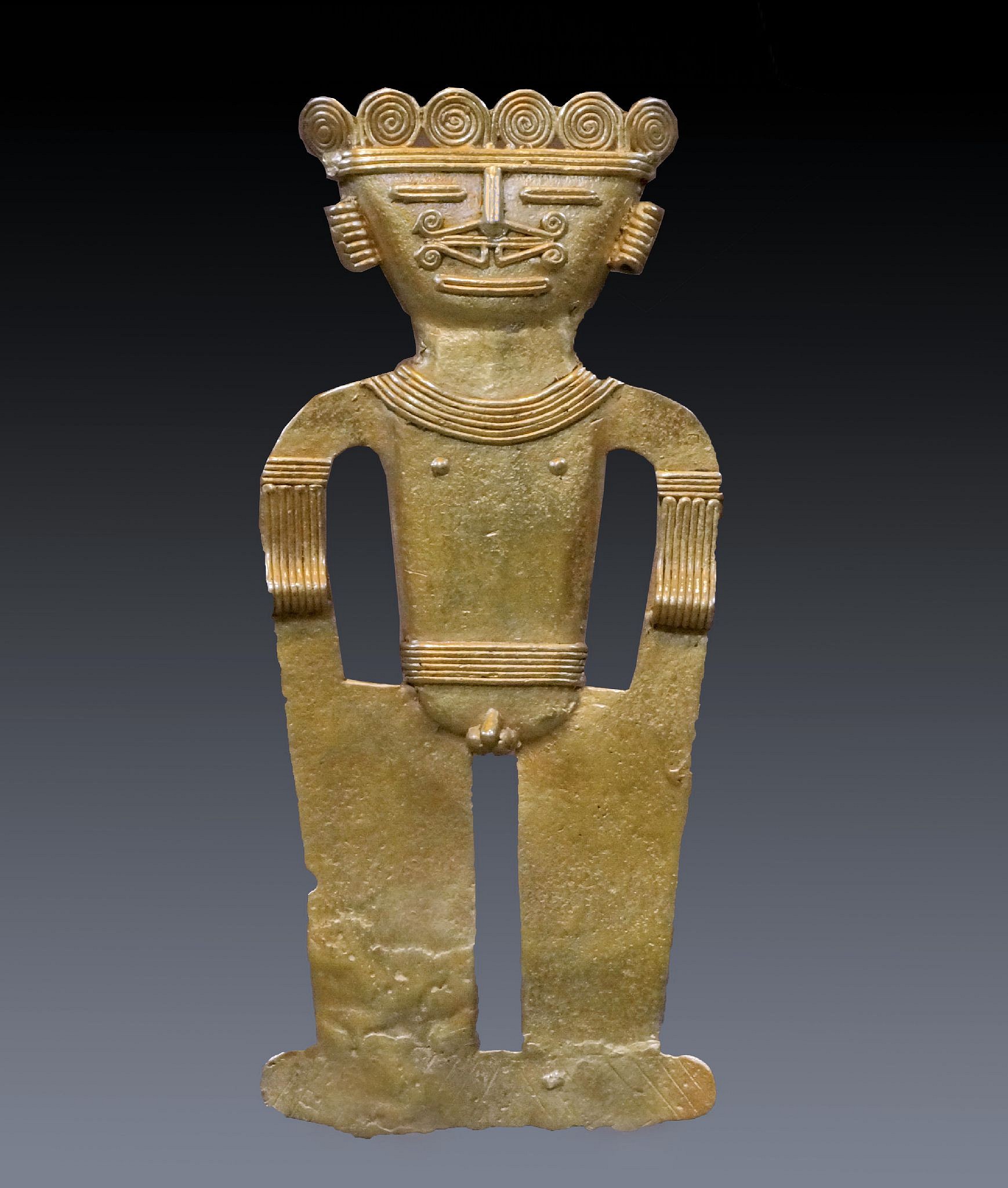



Colombia, Quimbaya cast gold pendant of a Lord in a Trance
The personage is wearing a crown, elaborate nose ornament, and necklace. He has an ancient casting repair to the lower left knee. The Uruba region is located on the Colombian/Panamanian border and had received early influences from the Quimbaya people and later influences from the Sinu. A similar pendant is illustrated in the article THE DARIEN GOLD PENDANTS OF ANCIENT COLOMBIA AND THE ISTHMUS, figure 35, and in the catalog of the Banco de Oro de Colombia # 414, Lam 46.
Media: Metal
Dimensions: Height: 6 3/8" ( 16.3cm) Weight 91.4 grams
XRF Au. 62% Ag. 22%, Cu16%
Price Upon Request
n4033
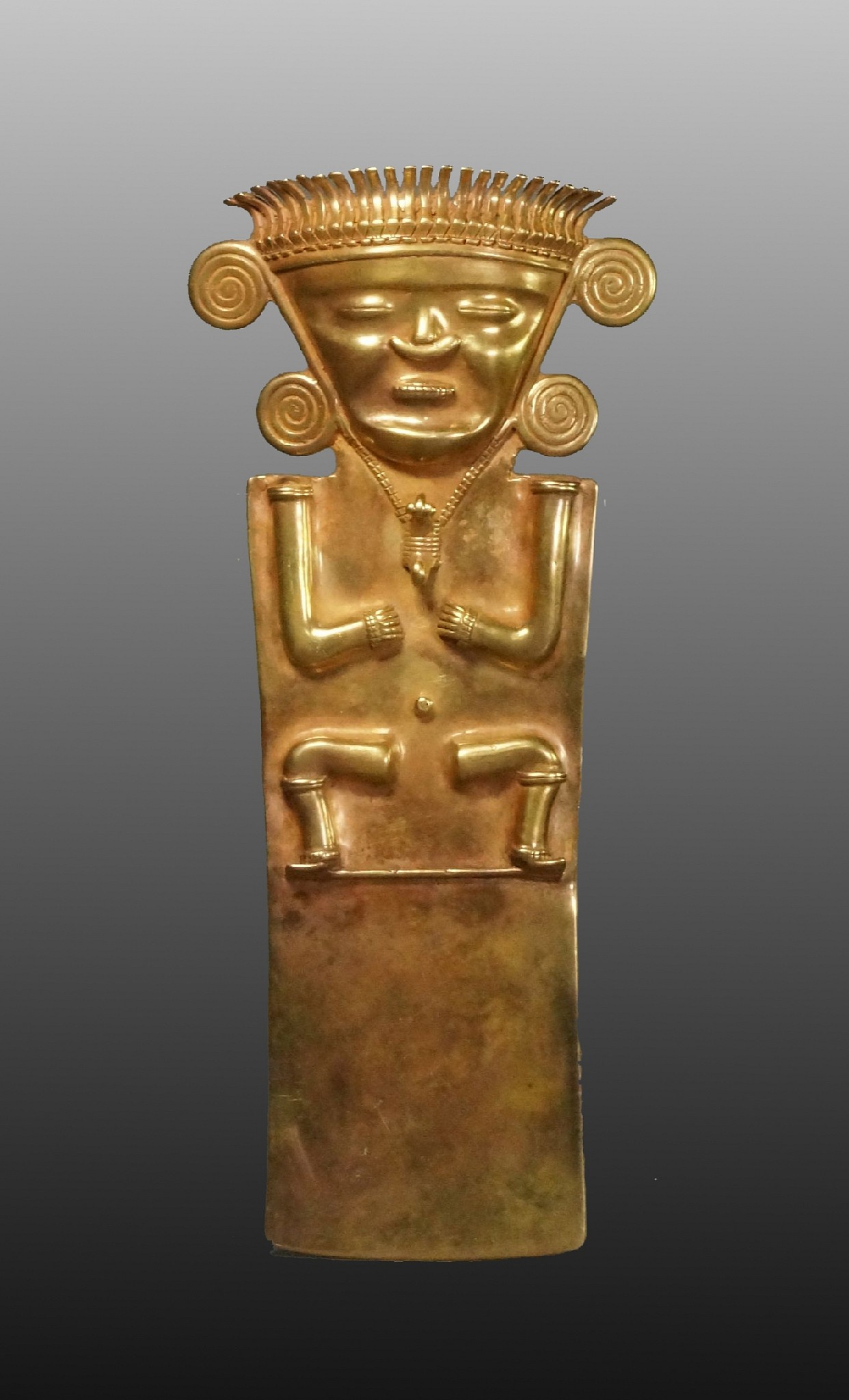









Colombia, Quimbaya Cast Gold Pendant of a Male Shaman
This is the largest known gold Quimbaya shaman. The shaman is in a state of trance or meditation, and wears elaborate ornaments, including: a crown with 24 birds facing downwards, a large pair of double-spiral ear ornaments, a crescent-shaped nose ornament, and a special gold necklace with a curly-tailed animal pendant. There are two suspension loops on the back. The casting is extremely well executed, with fine details on the crown and the necklace. A similar ornament is in the Museo del Oro and only measures 7 1/2" in height. A pair is illustrated in The Dora Janssen Collection catalogue, which measures 7 1/2" in height. Similar examples are also illustrated in MASTERWORKS OF PRE-COLUMBIAN GOLD: The Glassell Collections of The Museum of Fine Arts, Houston, p.151, and in The Art of Pre-Columbian Gold:The Jan Mitchell Collection, p.59. Similar examples are also published in The Gold of Eldorado, by Warwick Bray, on p. 218. From a Texas collector, acquired prior to the 1970s. Ex. Jan Mitchell collection, acquired prior to the 1980s by descent to his son David Mitchell.
Media: Metal
Dimensions: Height" 8 1/2" x Width: 3 2/4" Weight: 192 grams.
$165,000
n7061
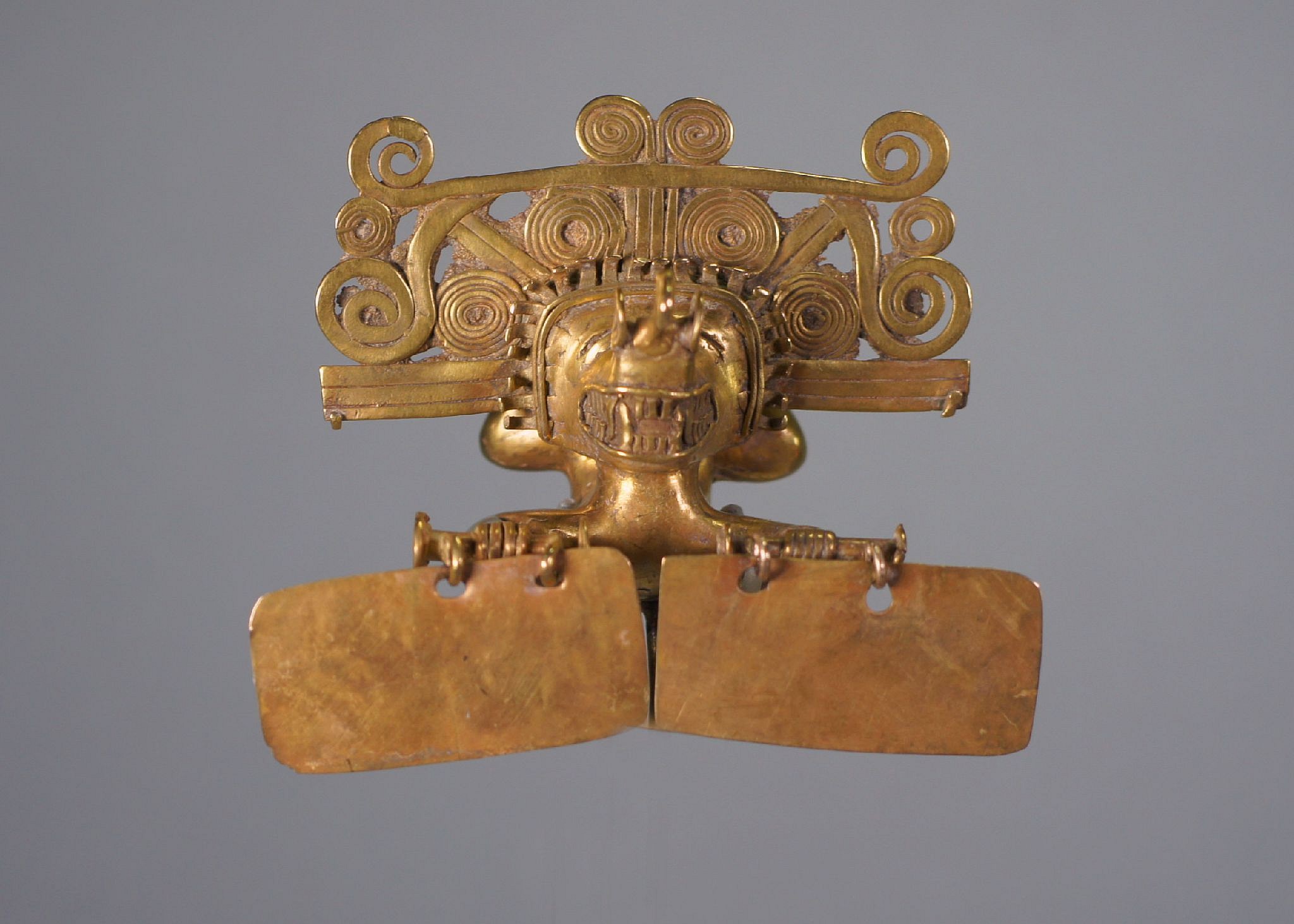


Colombia, Quimbaya Style Gold Pendant of a Tumbling Shaman with Two Rectangular Dangles
Cast figural pendant of a feline-headed Shaman tumbling in a trance. The shaman holds bars with large rectangles in each hand. This pendant is extremely well sculpted with curved limbs arching upward at the back, legs bent, and toes curled, with suspension loops on each sole. This example was purported to be found in the Uruba region of North West Colombia. The subject is a very rare subject for Colombian gold work.
Media: Metal
Dimensions: Width: 2 5/8 inches
Price Upon Request
99120
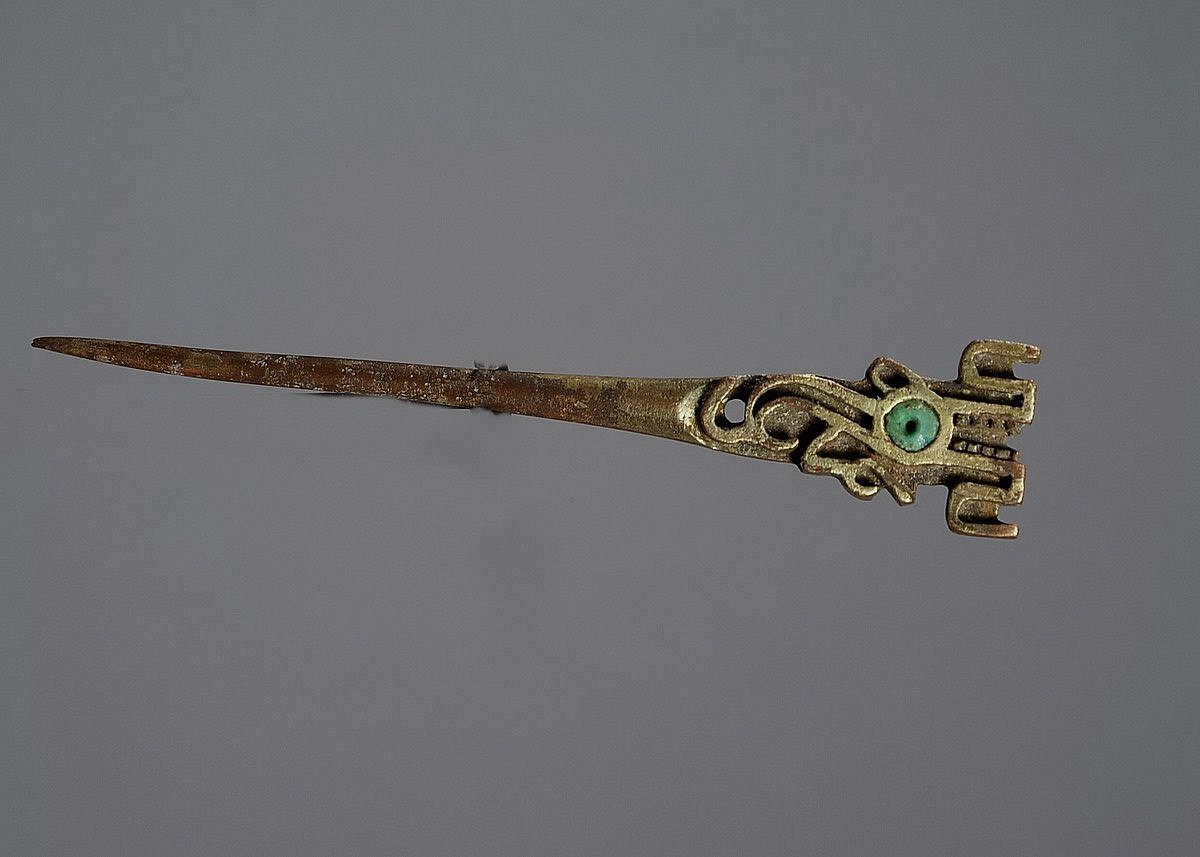





Peru, Recuay Gilt Copper Pin Decorated with the Moon Animal
This is a short tupú with a filigree design of the Moon creature, a North Coast deity invented by the Recuay and adopted by later societies. The creature may have been modeled after the Pampas Cat or the Andean Mountain Cat, a small feline that inhabits the region. The Recuay and Moche associated the Moon Animal with the crescent moon, stars and human sacrifice. There is a turquoise bead in the eye; other recessed areas of the casting also had inlays, which have been lost. Few Recuay gilded works have survived because the gilt tends to fall off over time. The Recuay had sophisticated techniques of metalworking, and this example is extremely well crafted. The gilding is thick (about 1mm). A similar pin was found at a Recuay site, and is on display at the American Museum of Natural History.
Media: Metal
Dimensions: Length: 3 1/2" x Width at top: 5/8"
$1,700
M2029

Peru, Salinar Gold Filigree Earrings
This is an early example of Pre Moche ear ornaments utilizing the filagree technique, soldered wire in a spiral design. The design is fitted between a single bent and hammered curve. Mastering soldering of thin wires is a very difficult technique as the heat can melt the entire construction if done poorly. Similar earrings are illustrated in the book, TRUJILLO PRECOLUMBINO, Odebrecht, 1990, pg.297.
Media: Metal
Dimensions: Each Height: 1" x Width: 0.9" Weight: 2.3 grams. combined.
$950
p1060



Peru, Salinar Group of Fourteen Gold Filigree Ear Ornaments
A group of 14 Salinar gold filigree nose ornaments of various designs and sizes. The Salinar people preceded the Moche on the North Coast of Peru in the Trujillo region. Ancient coastal Peruvians did not have access to bees or beeswax due to the dry coastal desert environment and were unable to use the lost wax casting method employed in ancient Colombia. Instead, they used soldering to create elaborate filigree ornaments. Soldering is technically complex, requiring carefully controlled temperatures along with the right mix of flux. This group of 14 individual gold filigree ear ornaments demonstrates the great level of skill and artistry achieved by the Salinar metalsmiths. Many of these filigree works are similar those illustrated in Trujillo Precolombino, by Jose Antonio de Lavalle, page 297. Three similar nose rings from the same region are also illustrated in RAIN OF THE MOON: Silver in Ancient Peru, published by The Metropolitan Museum of Art, 2001, fig. 1. Acquired in 2000 from a private New York collector.
Media: Metal
Dimensions: Range: 7/8" to 1 1/2" Width
$8,000
MM087
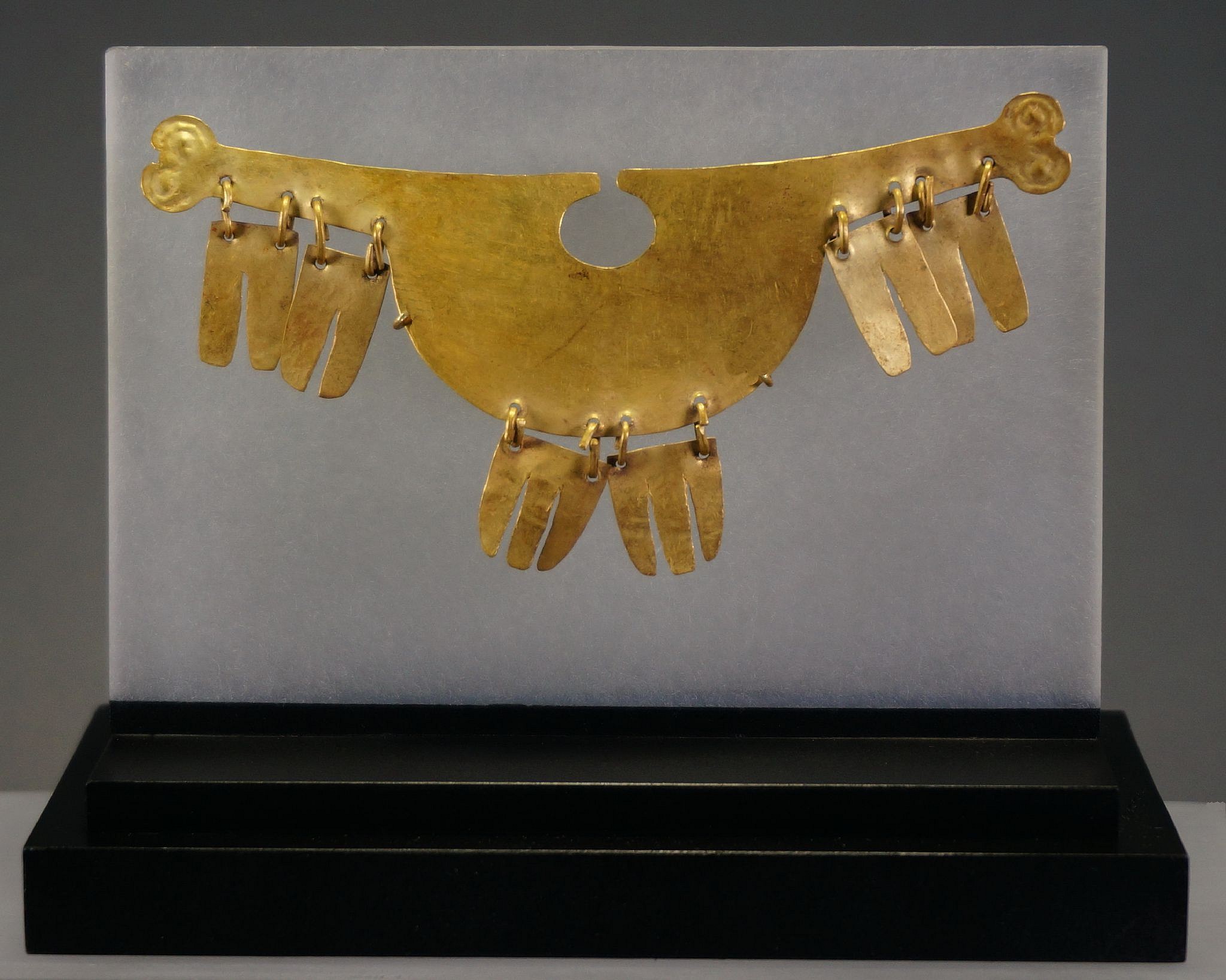


Peru, Salinar-Early Moche Gold Nose Ornament With Dangles in the Form of Bird Feathers
Unusual and rare nose ornament from the Salinar culture with stylized bird heads at each end and six dangles imitating feathers. A similar example is illustrated in "Oro del antiguo Peru" by José de Lavalle (1992: pl. 94).
Media: Metal
Dimensions: Width 4" x Height 1 3/4"
Price Upon Request
96164
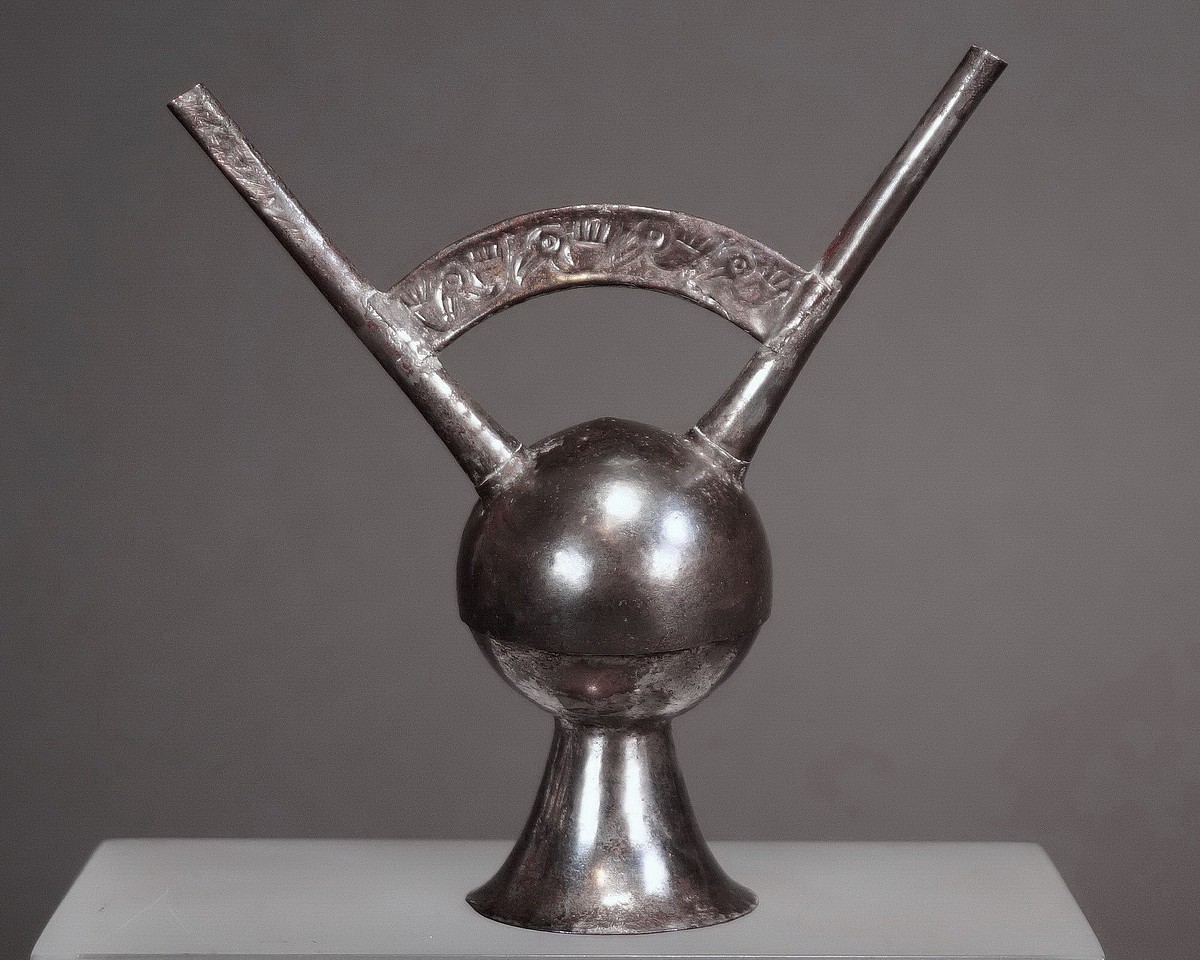



Peru, Sican Gilt Silver Miniature Double Spouted Vessel
The vessel was made for a child's tomb. It has an arched bridge with four marine birds embossed on each side and is made from 6 components that are soldered together. The base metal is copper, and there is a thin outer layer of silver, which is worn in a few places. Gilding, the method used to create this vessel, was a much more difficult process then sculpting with pure silver.
Media: Metal
Dimensions: Height: 5" x Width: 4 3/4"
Price Upon Request
n8036
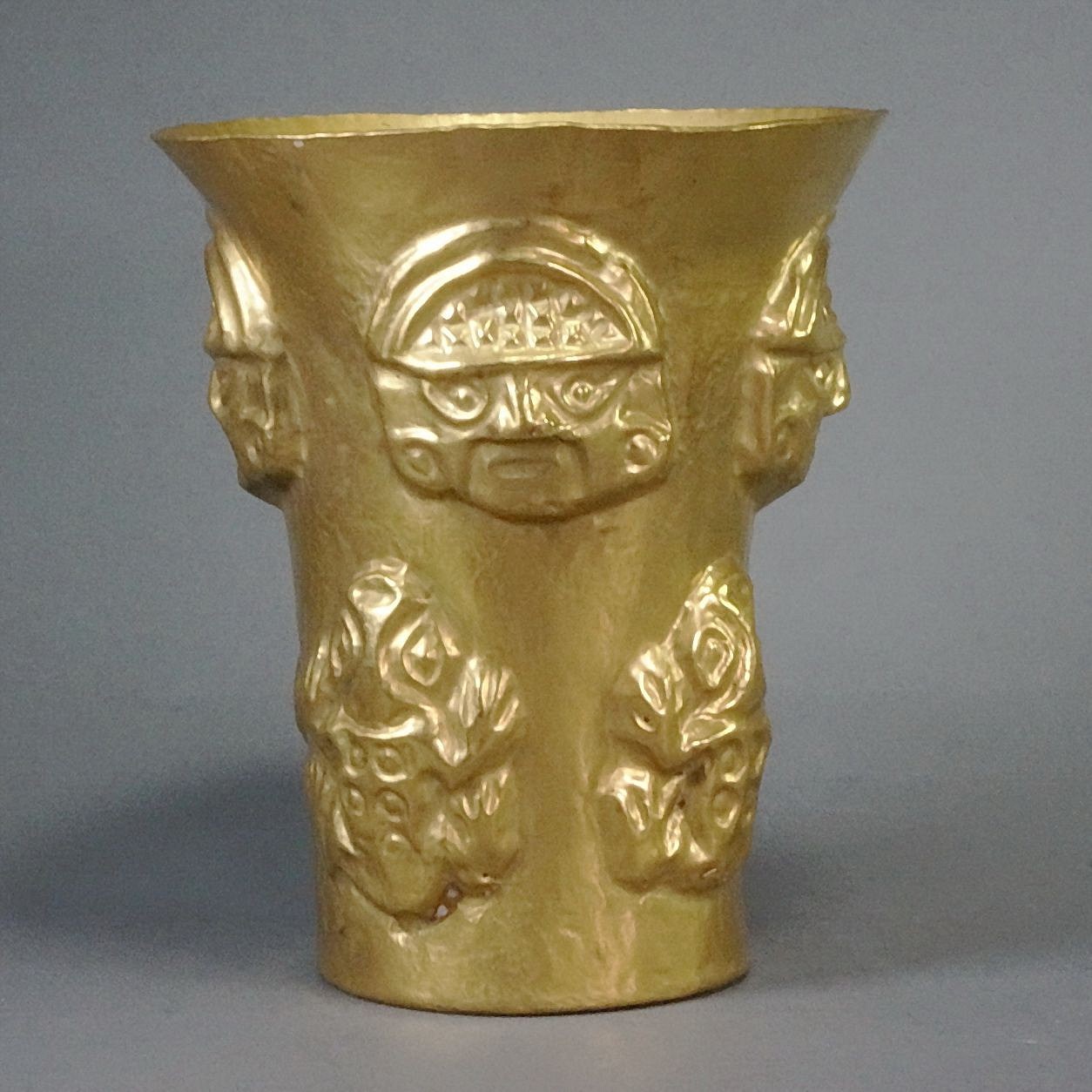
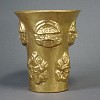




Peru, Sican Gold Beaker with Mask and Frog Motif
The Sican cache of gold came from the largest burial in the Americas at hacienda Batan Grande near the Chimu City of Chan Chan. These beakers were used to drink the ceremonial Chicha (Corn Beer). The masks and flared beakers were the most notable objects from this burial. The beakers came in various designs from frogs to Warriors. This beaker is unusual in that it has both masks and frog motifs. Illustrated in THE ART OF PRECOLUMBIAN GOLD, pg.227 the on the right. Exhibited in 1964, Los Angles # 202. Ex-Jan Mitchell collection, prior to 1980.
Media: Metal
Dimensions: Height: 5. 1/8" Diameter at top: 4 3/8" Weight: 184 grams
Price Upon Request
n7054




Peru, Sican Gold Flared Beaker with Embossed Toads
Bufo Marinus toads, depicted on this vessel beaker, are found on the dry coastal desert coast of Northern Peru. These toads are identifiable by their highly textured skin, represented by six sets of incised circles. Acquired from a private Texas collector, prior to the 1970s. Some traces of cinnabar.
Media: Metal
Dimensions: Height: 51/2" x Width: 4.2" Weight: 118 grams.
$32,000
N6001
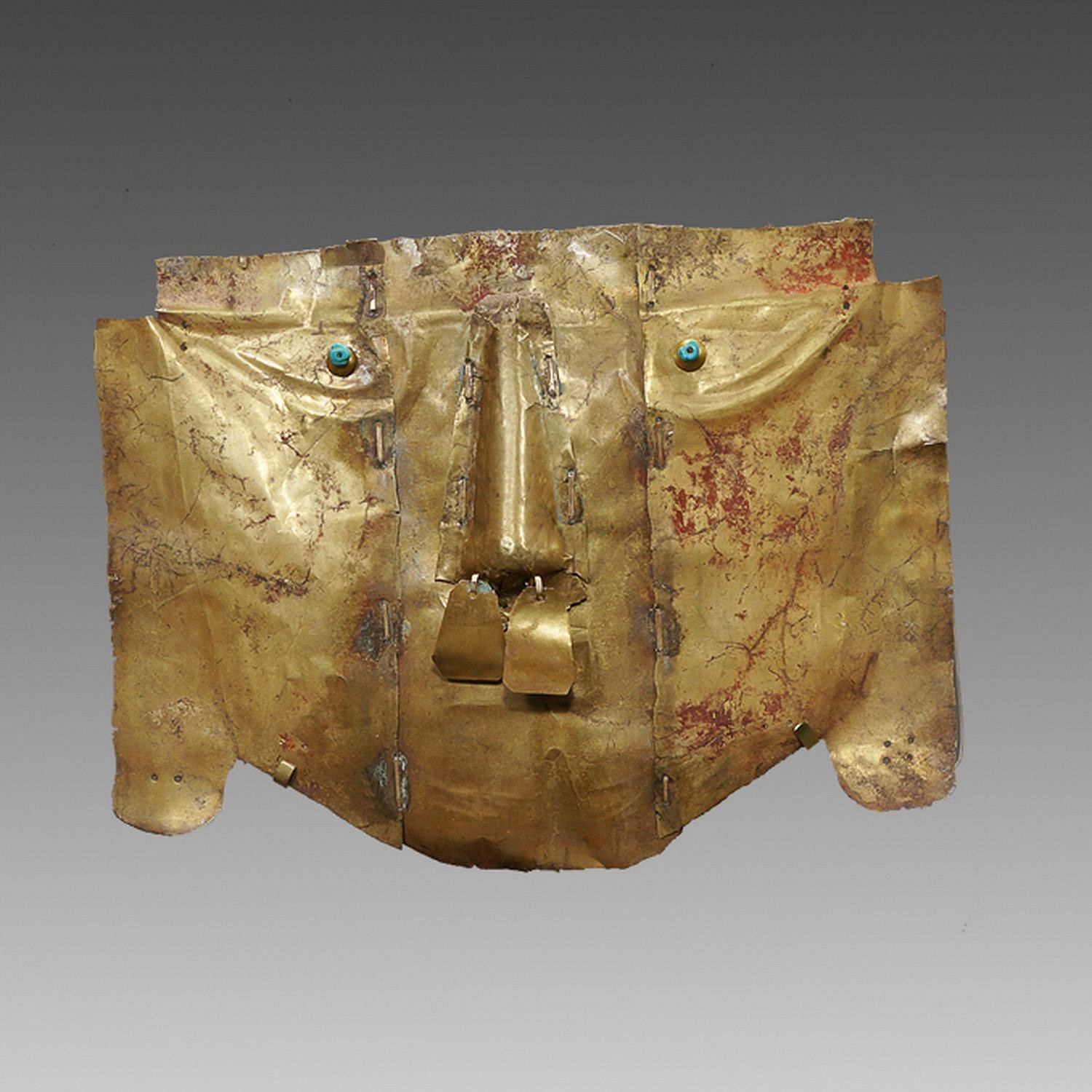
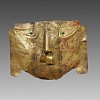




Peru, Sican Gold Mask of the Third Type
A classic type of mask from the 3rd Phase, constructed in 3 parts and held together by ancient gold staples. The eyes have turquoise bead pupils with gold hemispheres. Traces of the original cinnabar remain. Sicán masks are discussed in THE ART OF PRECOLUMBIAN GOLD - The Jan Mitchell Collection, page 66 - see example(s). The Sicán culture was extremely wealthy and was known to have built the largest city in the Americas, Chan- Chan, outside of the modern city of Trujillo. The Sicán were excellent gold workers, and when the Incas conquered them, they brought the metalsmiths to the Inca capital of Cuzco. Similar masks are illustrated in THE GOLD OF PERU-MUJICA GAILLO Collection. Ex. Private New York Collector.
Media: Metal
Dimensions: Height: 7.75" x Width 10 1/8"
Price Upon Request
n4001
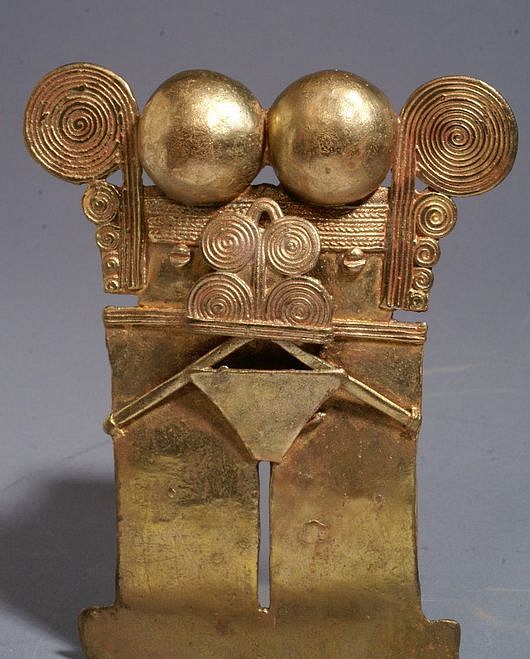


Colombia, Sinú Gold Pectoral of Mushroom Shaman in Trance
Called "Darien pectorals," these ornaments are one of the most fascinating and enigmatic in the corpus of Sinú gold work. They are not confined to one region, although their greatest concentration is in the Sinú area of northwestern Colombia, near the border with Panama's Darien Province. They are also found in the Quimbaya region of Colombia further south. The consensus of opinion on these pectorals is that they represent shamans in trance decorated with references to natural psychoactive hallucinogens (Shultes and Bright 1981, Reichel-Dolmatoff 1988). In this work and most such figures, the bell motifs above the face represent hallucinogenic mushrooms, and on some pieces, the mushrooms are realistically represented. Similarly, the mask of spiral curls in front of the face here is a stylized frog with hallucinogenic glands behind its eyes, but in some examples, the frog is completely realistic. Lastly, the vertical spirals on either side of the face are stylized bird wings, since shamans thought of their souls as flying to the otherworld to seek advice and knowledge from the ancestors and deity spirits.
Media: Metal
Dimensions: Height: 4 1/2" x Width: 3 1/2" Weight 119 grams
Price Upon Request
M7027

Colombia, Sinu Solid Gold Nose Ring with End Caps
A solid gold U-shaped bent rod for a nose ornament with hammered end caps. Exhibited at The Museum of Primitive Art in 1969, no 165. Illustrated in The Art of Pre-Columbian Gold: The Jan Mitchell Collection, pages 162-163. Ex. Jan Mitchell collection, prior to 1980s, by descent to his sons.
Media: Metal
Dimensions: Diameter: 1 3/4" Weight: 31 grams.
$7,000
p1253





Colombia, Tairona Cacique With Bird Headdress
This is a small pendant of its type, a classic cacique wearing an elaborate headdress crafted with traditional swirls resembling animal heads in profile. The details are well done for such a small piece. Ex. Jan Mitchell collection, prior to the 1970s.
Media: Metal
Dimensions: Height 3 1/4" x Weight: 55.1 grams.
•SOLD
P1003
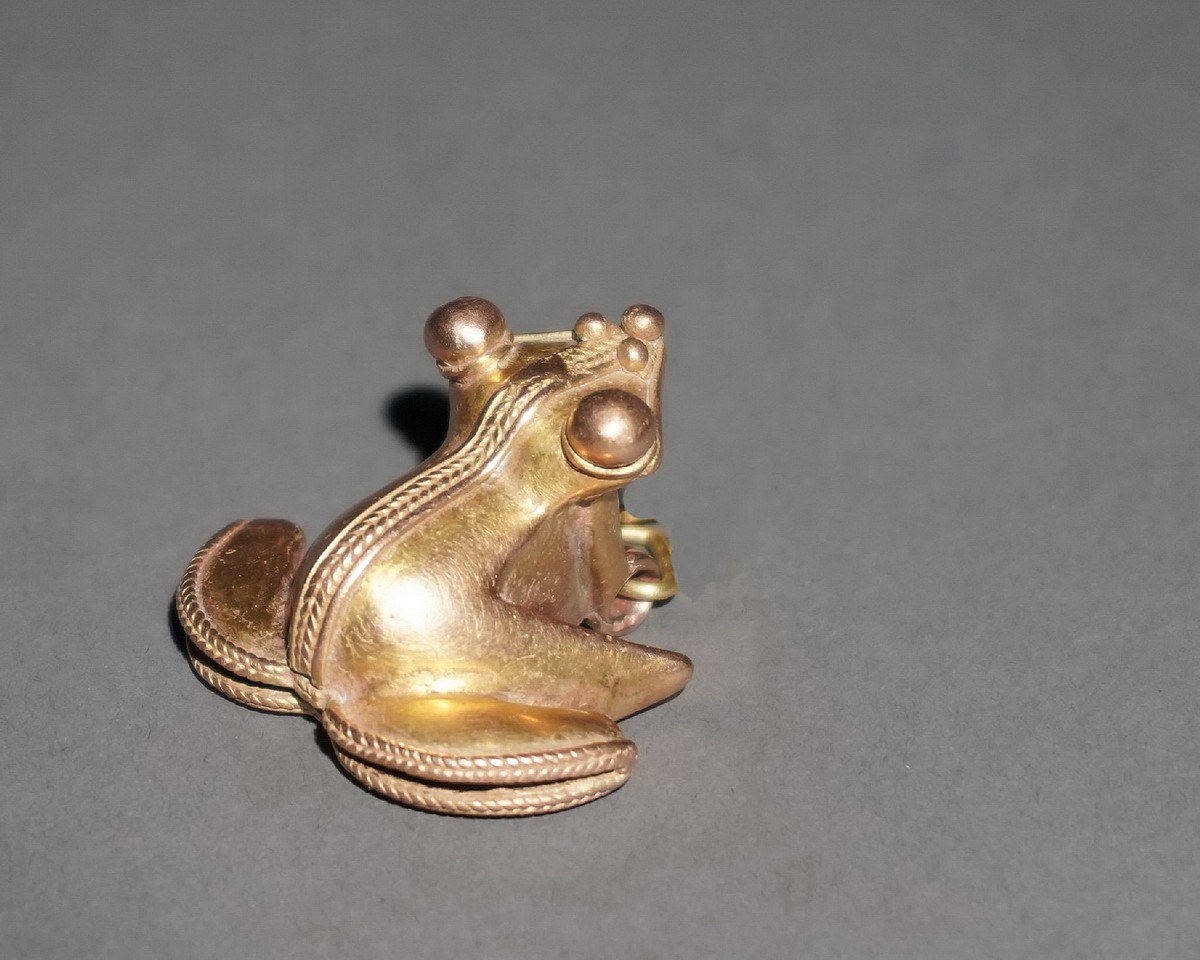





Colombia, Tairona Gold Cast Frog Pendant with Rattle
This expertly crafted gold pendant depicts a frog hunched on its back flippers. The frog has spherical eyes and a delicate braided ribbon that slopes down its back and borders its flippers. There is a modern suspension loop hung from the original suspension arrangement. Jan Mitchell collection prior to 1970, by descent to his sons.
Media: Metal
Dimensions: Length: 1 7/8" x Width: 1 5/8" Weight: 21.2 grams
Price Upon Request
p1045b





Colombia, Tairona Gold Cast Frog Pendant with Rattle
This expertly crafted gold pendant depicts a frog with large eyes hunched on its hind legs. A delicate braided ribbon slopes down its back and borders its legs. A modern suspension loop is attached to the original ancient suspension arrangement. From the Jan Mitchell collection, prior to 1970, by descent to his sons.
Media: Metal
Dimensions: Length: 1 7/8" x Width: 1 5/8" Weight: 21.2 grams.
$4,500
p1046
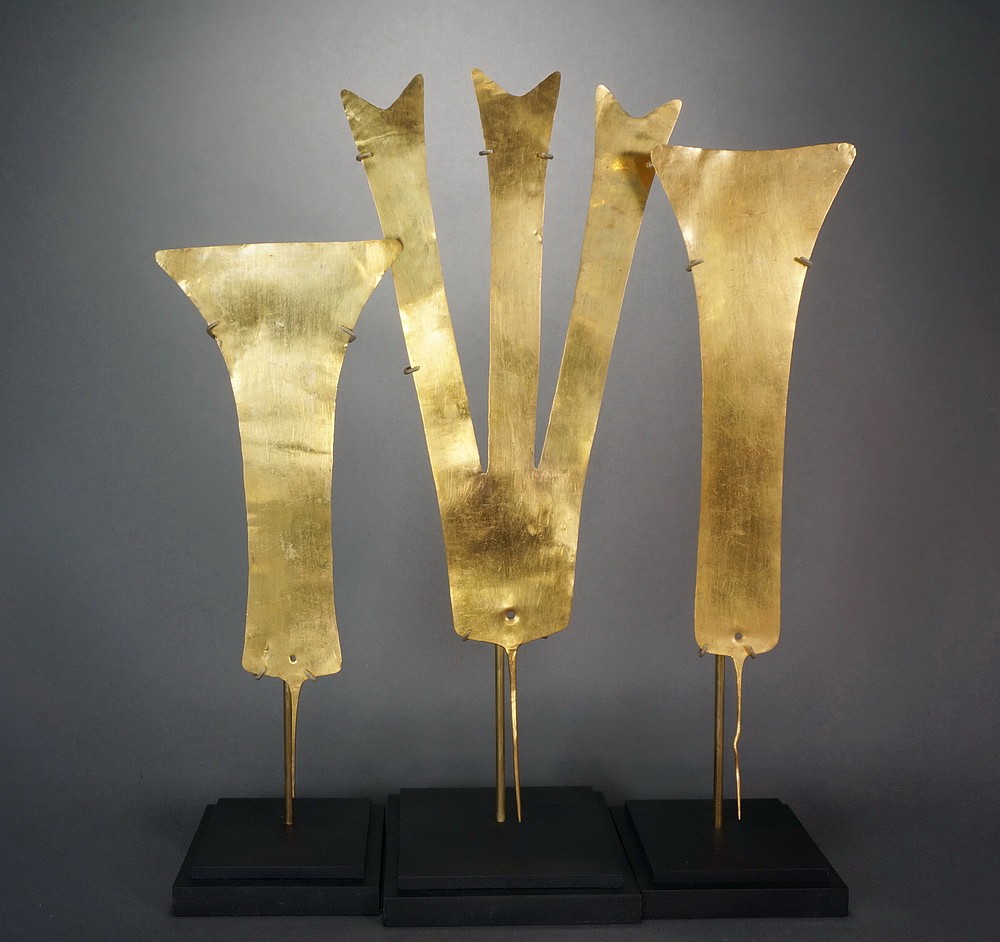




Peru, Three Chavin Gold Plumes for Headdress
Three hammered gold plumes were used as headdress or turban ornaments with tapering shafts. They were each fabricated from an individual nugget by repeatedly hammering and annealing. They are illustrated in TRUJILLO Precolumbino, Odebrecht-Lavalle, Editores 1990, pg 293. Other similar examples are illustrated in Oro del Antiguo Peru, pl. 51. These plumes are considered very large for early Peruvian goldwork.
Media: Metal
Dimensions: Height: 9", 11", 12" Weight for the three 90 grams
XRF: Au.81, Ag. 9.5%, Cu. 10.1% average for the 3
Price Upon Request
94192




Peru, Three Moche Bi -Metallic Nose Ornaments
These ornaments are excellent examples of the Moche metalsmiths’ ability to use depletion gilding to vary the surface area with both gold and silver decoration. The Moche believed that metal possessed sacred power, and according to their cosmological myths, the process of bringing the silver and gold colors to the surface revealed the metal’s spiritual qualities. A similar nose ornament is illustrated in ANTIGUO ORO DEL PERU, pg. 15. Private collector, Florida, prior to 1980.
Media: Metal
Dimensions: Width 4 3/4" Weight 24 grams.Width 3 5/8" Weight 13.8 grams.Width 3 7/16" Weight 14.8 grams.
$12,500
M5027

Ecuador, Three Tolita Gold Nose Ornaments
Three gold U-shaped miniature nose ornaments, each with a different pattern of granulation. The U-shape would likely have been created using lost wax casting and then granulated. Granulation uses heat only to attach the small spheres to the cast. A similar piece is illustrated in Charms in Pre-Columbian Ecuador by Christian Mesia Montenegro, 2007, on pages 53 and 55.
Media: Metal
Dimensions: Diameter: 7/8 - 2 3/8 inches. Weight:12.2 grams.
$4,500
99128



Ecuador, Tolita Gold Labret with Granulated Design and Turquoise Center
This small but early example of granulation of eight separate granulations section fitted on a gold plate on top of the stem. This is a tour de force of early metal working in the Americas.
Media: Metal
Dimensions: Depth: 1/2" x Face: 3/4" X 3/4"
$2,200
99600
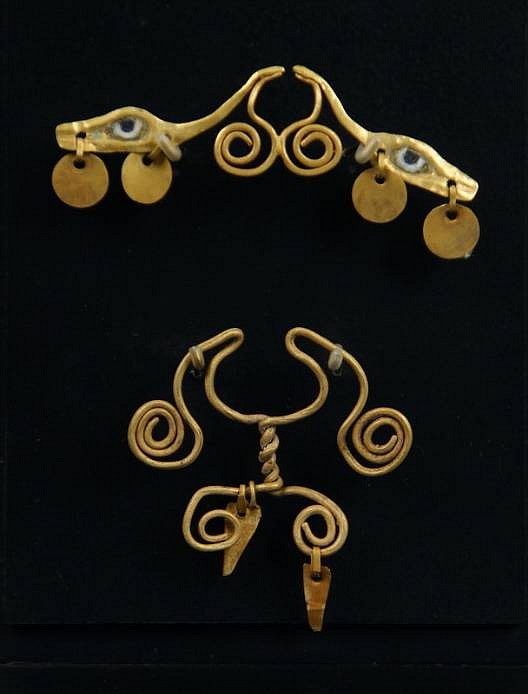



Peru, Two Chavin gold nose ornaments with openwork coils and dangles
One is fashioned from one continuous wire curled into double spirals and twisting into another set of doublle spirals flanking a central suspension plaque and two triangular dangles. The other has double spirals in the center framed by serpents heads, end to end, each with two suspended circular dangles. A similar one is illustrated in Oro Del Antiguo Peru, plate 42.
Media: Metal
Dimensions: Height 1 3/4 inches; Width 2 1/2 inches
Price Upon Request
94154
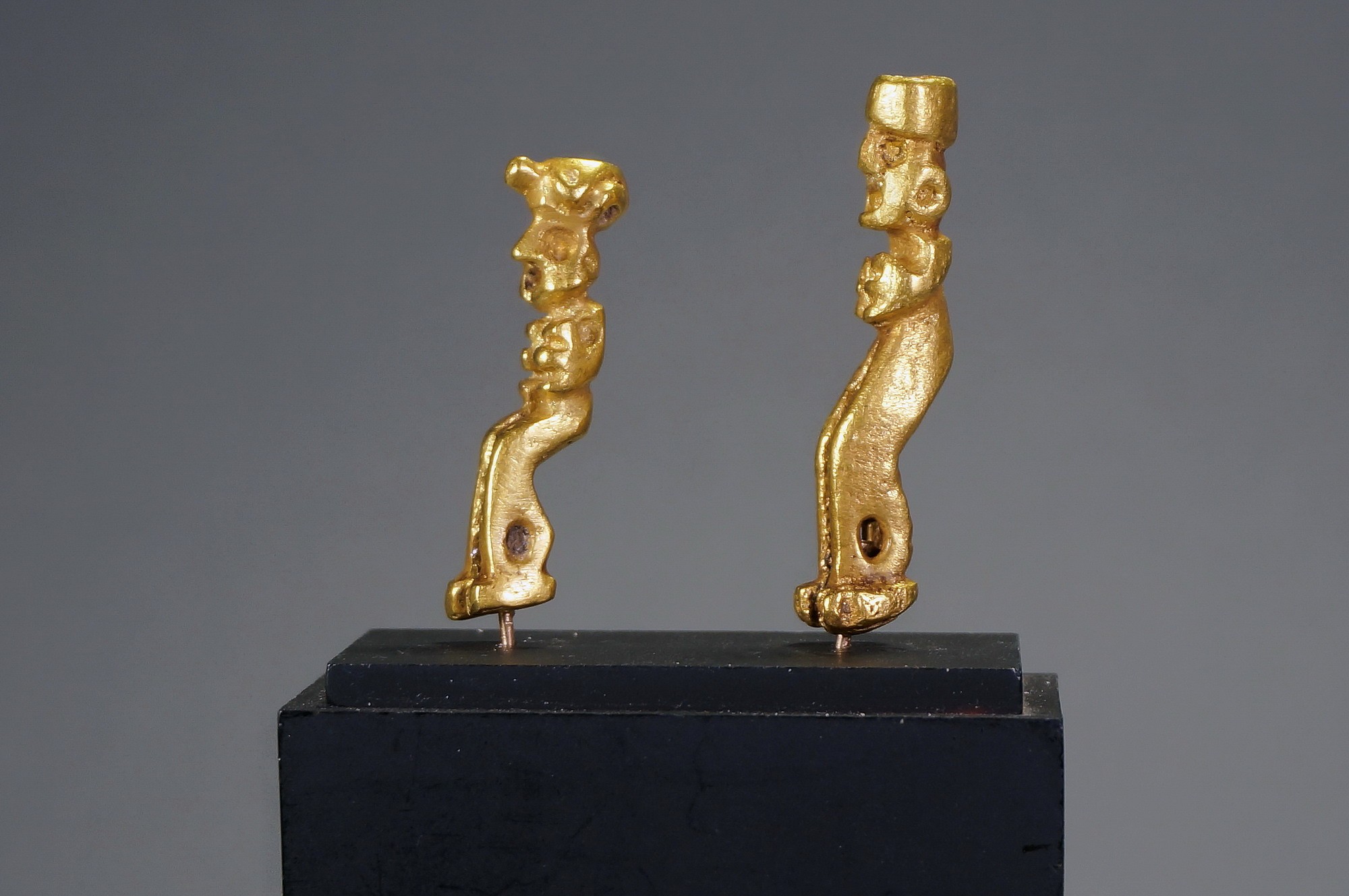




Peru, Two Inca Miniature Cast Gold Standing Figures
These two solid cast gold figures are highly unusual subjects. Each figure has exaggerated hands and elongated legs. Both figures have cast suspension holes above the ankles. The top of each figure has a hollow shape that could have been used to insert feathers. The only other example illustrated is in Oro del Antiguo Peru, lamina 210 (7 cm or 2.75"). One figure is wearing a headdress with a feline motif and the other one with a simple cylindrical shape. Ex. New York collector, prior to 1970.
Media: Metal
Dimensions: Height:1.5" and 1.75"; Weight: 24 grams for pair.
Price Upon Request
n7028

Peru, Two Miniature Nose Ornaments Demonstrating Early Goldwork Techniques
This beautiful set of miniature gold nose ornaments features two early Pre-Columbian goldwork techniques. The top ornament is from the Chavin culture and was formed using a combination of heating and annealing the gold. The bottom ornament is from the pre-Moche Salinar culture and features both granulation and filigree techniques.
Media: Metal
Dimensions: Chavin: Width:1 1/2" Weight: 4.2 grams.Salinar: Width: 1 1/4" Weight: 4.6 grams.
$1,850
90400
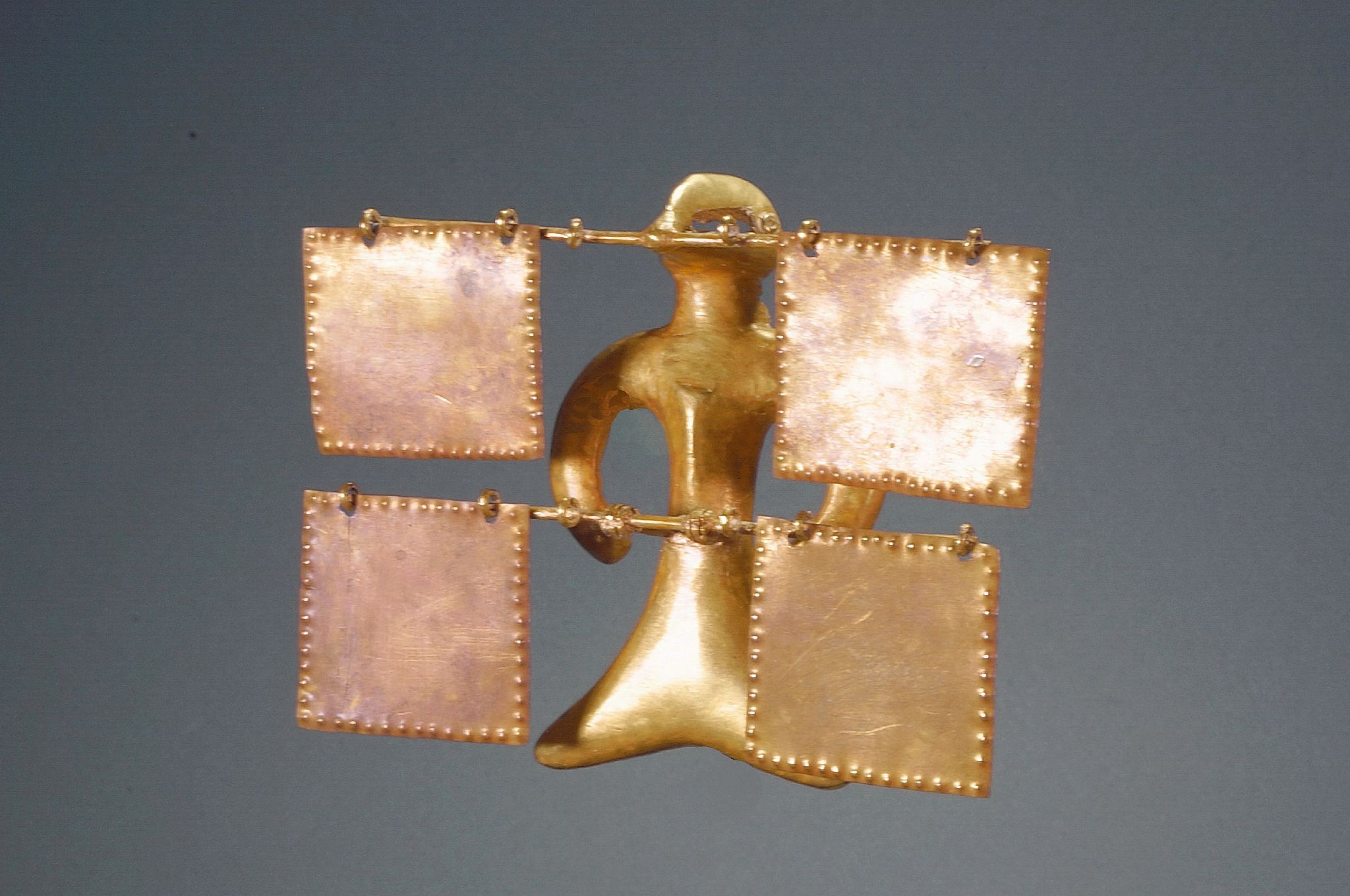



Colombia, Uruba Style Bird Pendant with Square Plaque Dangles
The bird has its wings arched to its sides, a flared tail, and four dangles suspended on two bars. The small suspension holes are inside the back of the neck. The bird has bead-like eyes and is a generalized composite of various birds. This piece is well cast, with evidence of the carbon core intact. There is a similar bird in The Gold Museum of Colombia in Bogota. Ex. Louisiana professor acquired prior to 1980s'.
Media: Metal
Dimensions: Height: 3 1/2" x Width: 4 1/2" Weight 33.6 grams.
$12,500
MM068
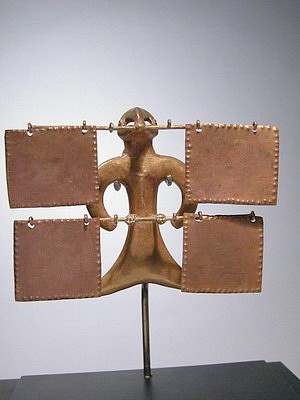
Colombia, Uruba style bird pendent with square plaque dangles
The bird has its wings arched to its sides and a flared tail and 4 dangles suspended on 2 bars. The suspension holes are small, inside the neck and two bead like eyes. The bird is a generalized composite of various birds, representing none in particular. It is well cast with evidence of the carbon core intact. There is a similar bird in The Gold Museum of Colombia in Bogota of the same size and posted on their website http://www.banrep.gov.co/museo/esp/o_uraba_O32654C.htm
Media: Metal
Dimensions: Height 3 1/2" x Width 4 1/2" Weight 33.6 grams
Price Upon Request
MM608
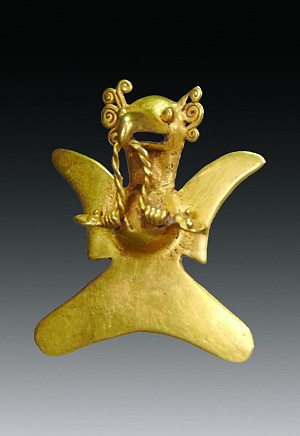





Costa Rica, Veraguas Cast Gold Eagle Pendant With Intertwining Serpents
This lost-wax cast gold miniature eagle is adorned with finely crafted scrolls around its head. In its claws, the eagle grasps a pair of intertwined serpents. There is a suspension loop behind the eagle’s neck, indicating that it was used as a pendant. This eagle is illustrated in The Met Musuem's THE ART OF PRECOLUMBIAN GOLD: The Jan Mitchell Collection, pg.110. Estate of Jan Mitchell prior to 1970.
Media: Metal
Dimensions: Height:1 3/4" x Width:1 1/2" Weight: 13.2 grams
$12,750
p1020

Panama, Veraguas Cast Gold Eagle Pendant with Serpent
This lost-wax cast gold miniature eagle is adorned with finely crafted scrolls around its head. In its claws, the eagle grasps a pair of intertwined serpents. There is a suspension loop behind the eagle's neck, indicating that it was used as a pendant. This eagle is illustrated in The Met Museum's The Art of Pre-Columbian Gold: The Jan Mitchell Collection, on page110. Estate of Jan Mitchell, prior to 1970.
Media: Metal
Dimensions: Height:1 3/4" x Width:1 1/2" Weight: 13.2 grams.
$12,750
p1020
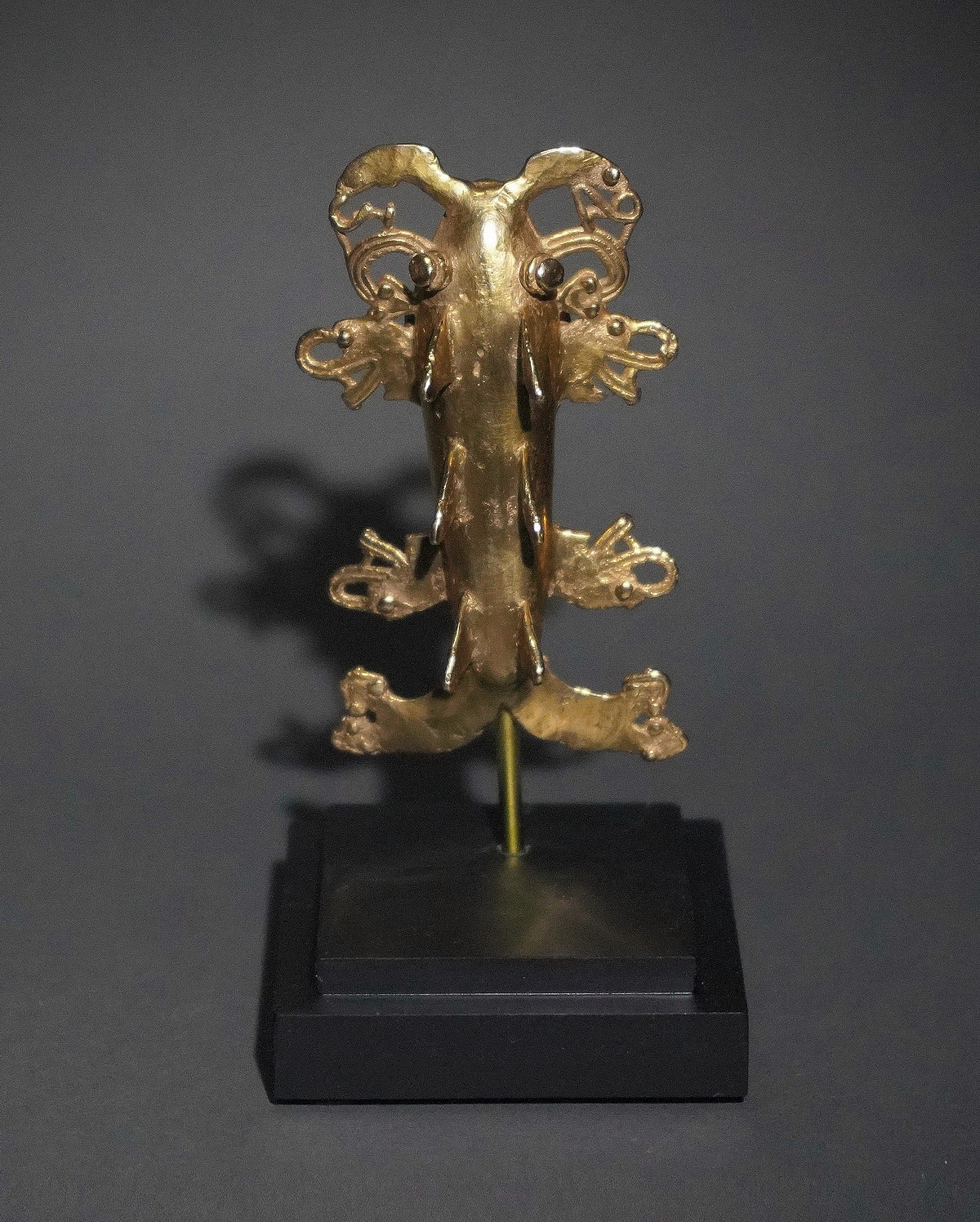




Panama, Veraguas Cast Gold Shark with Serpent and Crocodile Appendages
This is a variation of the classic Veraguas shark, with three sets of dorsal fins and four sets of Saurian appendages. On the underside of the mouth are two rows of intricately modeled teeth. There are two suspensions loops underneath the mouth. From the Jan Mitchell collection, prior to 1970, by descent to his sons. The top left serpent appendage is missing its eye.
Media: Metal
Dimensions: Length: 3 1/4" x Width: 1 7/8" Weight: 65.5 grams.
Price Upon Request
p1046







Panama, Veraguas Cast Gold Shark with Serpent and Crocodile Appendages
This is a variation of a typical Veraguas shark, with three sets of dorsal fins and four sets of appendages. There are two teeth on the top and bottom jaws, with two suspensions loops underneath the mouth. From the Jan Mitchell collection, acquired prior to 1970
Media: Metal
Dimensions: Length: 3 1/4" x Width: 1 7/8" Weight: 65.5 grams.
•SOLD
p1048





Panama, Veraguas Cast Tumbaga Pair of Composite Animals
This pendant was found in Panama, along the Panamanian border with Colombia, but was influenced by the Darien aesthetic, which spread from eastern Columbia all the way to Honduras. These stylized anthropomorphic figures, representing shamans or priests in hybrid animal form, feature thin arms and simple faces, with birds representing celestial wanderings. There are two suspension loops behind the heads. Lost wax cast of copper and gold alloy. From the estate of Jan Mitchell, prior to 1970. There is an ancient repair to the band that holds the creatures together. A similar piece is reported and displayed in the classic book - Oferbereria Prehispanica de Columbia - Estillo Quimbaya Otras by Jose Perez de Baradas.
Media: Metal
Dimensions: Length: 3" x Width: 2 5/8" Weight: 62.8 grams.
$8,750
p1026










Panama, Veraguas Lost-Wax Cast Gold Figural Pendant with Triangular Tail
The figure holds a short staff in each hand and wears an elaborate Saurian headdress. Illustrated in Pre-Columbian Art of Mexico and Central America, by Hasso Von Winning, in 1968 on page 379. Also illustrated in The Art of Pre-Columbian Gold, published by the Metropolitan Museum of Art in 1985, (page 107), and in Beyond El Dorado: power and gold in ancient pre-colombia (page 77). Originally from the Estate of Jan Mitchell, by descent to David Mitchell, prior to 1968. From a Texas collector, acquired prior to the 1970s. The upper left extension was professionally bent and welded back into proper place.
Media: Metal
Dimensions: Height: 3 3/8" x Width 3.8: Weight: 127 grams. Au 55.4%, Cu 40.2%,
•SOLD
N7048

Peru, Vicus Embossed Gold Nose Ring
The section of Vicus, known as Loma Negra, yielded a horde of finely metal objects, mostly face and body embossed ornaments mostly made in gold, silver or copper. They are Moche in style, probably related to the early Moche ceramics at Loma Negra. This nose ring is embossed with imagery anthropomorphized feline. Above their heads, beneath their feet, and between them are bosses with a central raised dot. It is possible that the two central puncture marks were added at later date. A similar nose ring is illustrated in The Art of Pre-Columbian Gold: The Jan Mitchell Collection, page 209. Ex. Jan Mitchell collection, prior to the 1980s, by descent to his sons.
Media: Metal
Dimensions: Height: 3 in x Width: 4.5 in. Weight: 12 grams.
$3,000
p1251
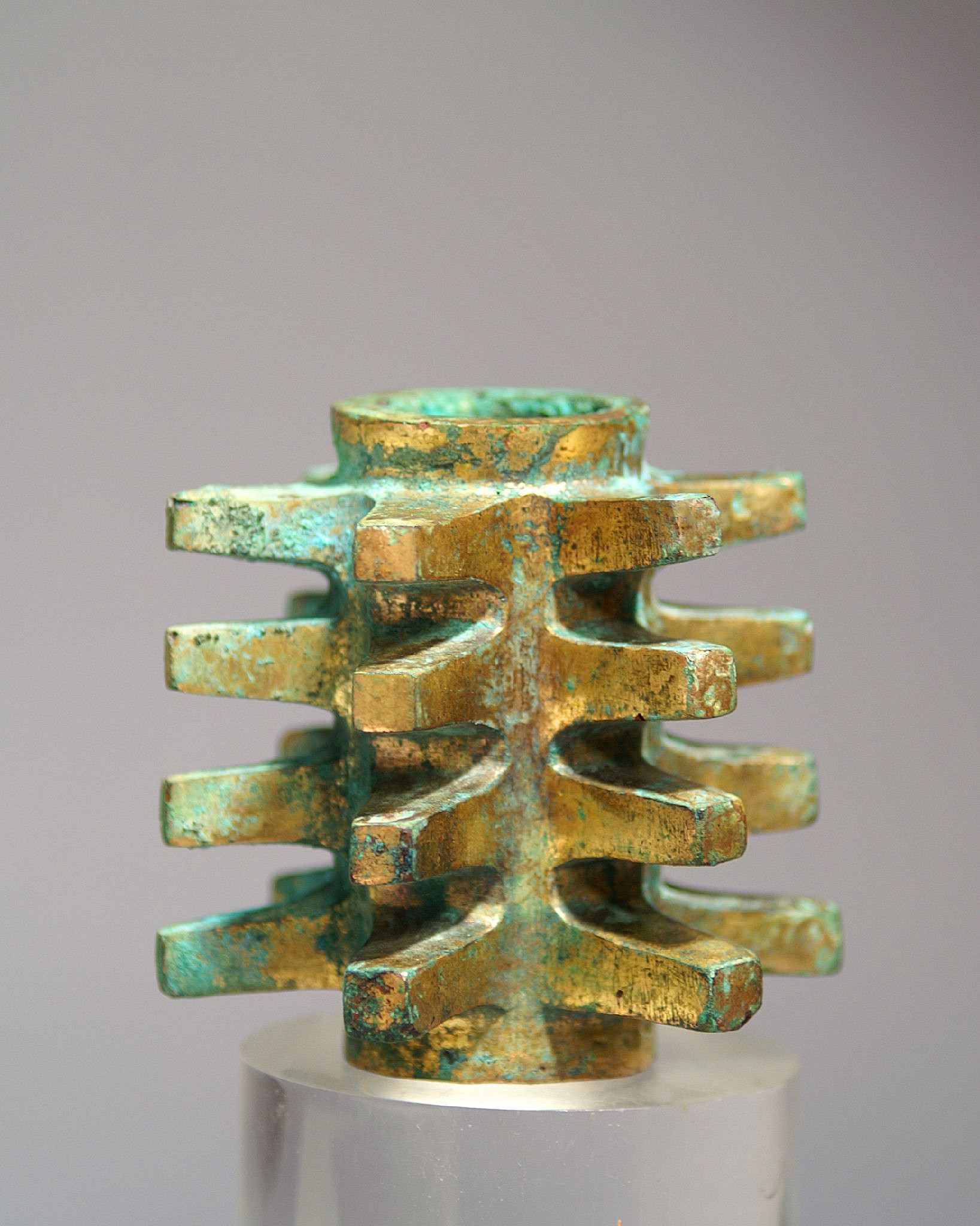


Peru, Vicús Gilt Copper Mace Head with four Levels of Six Pointed Stars
The mace has a richly gilded surface with traces of malchite corrosion inside and out. A similar mace with only three layers of stars and less intact gilt is illustrated in Mufareche (1999: #132). Mace heads were attached to wooden shafts and used as weapons. This is a particularly fine example from the early Vicús culture.
Media: Metal
Dimensions: Diameter 3" x length 3 5/8"
Price Upon Request
M3053
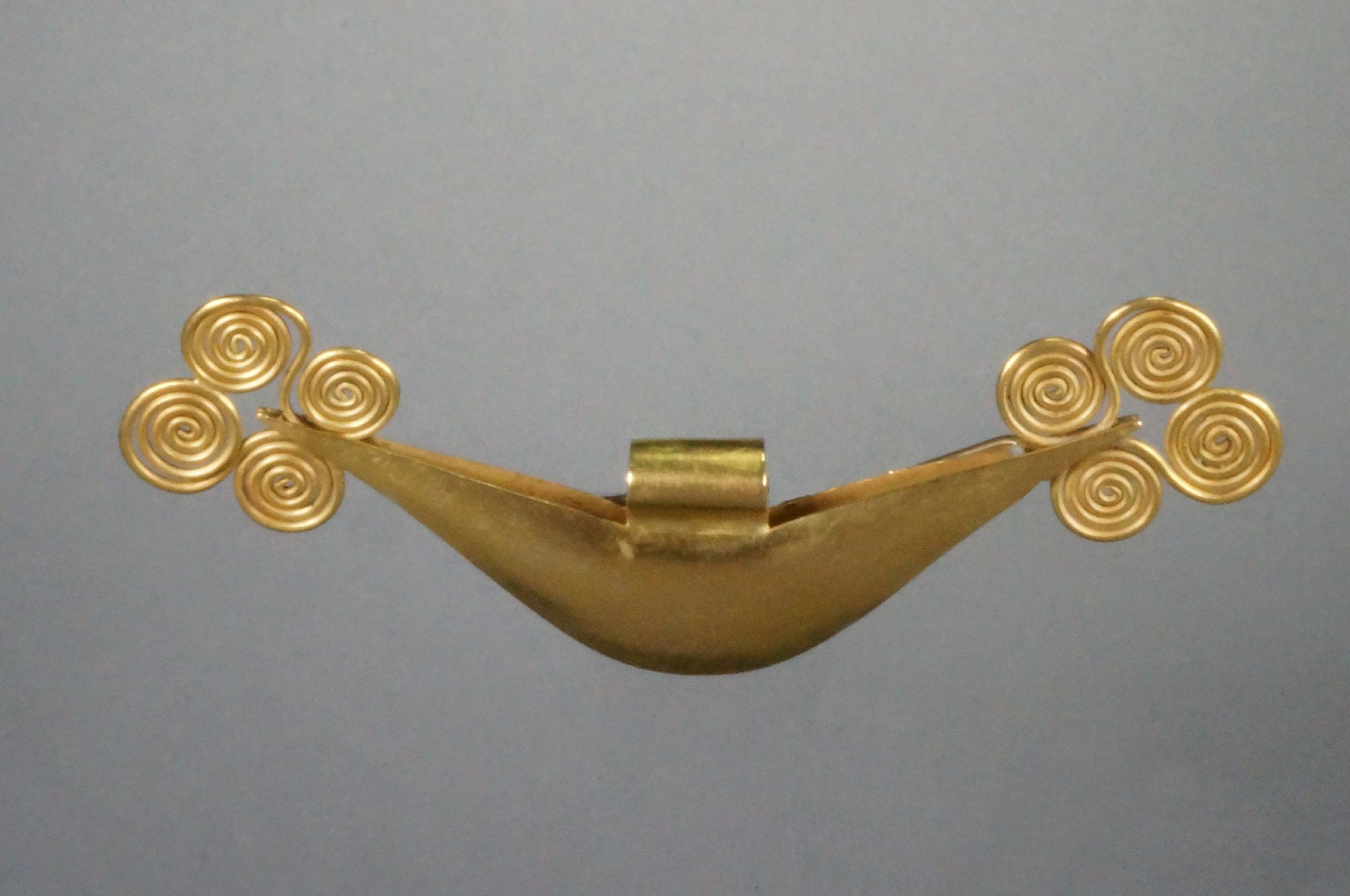


Peru, Vicús Gold Crescent Tweezers with Four Spirals on Each End
An elegant gold nose ornament with four wire spirals expertly soldered on each end. Made of two oblong sheets of gold with soldered filigree spirals reveals a high degree of craftsmanship. Tweezers were status implements fabricated in copper, silver and gold, with gold reserved for the highest level of status. Tweezers are often confused with nose ornaments, however they are spring loaded by annealing the metal, and were used to pluck the thick facial hairs of the Andean people. Shaving was not done in the New World, but was widely practiced in Europe and the Middle East.
Media: Metal
Dimensions: Width 6" Weight: 36.5 grams
XRF: Au. 83.8%, Ag. 20.0%, Cu.5.1%
Price Upon Request
96050
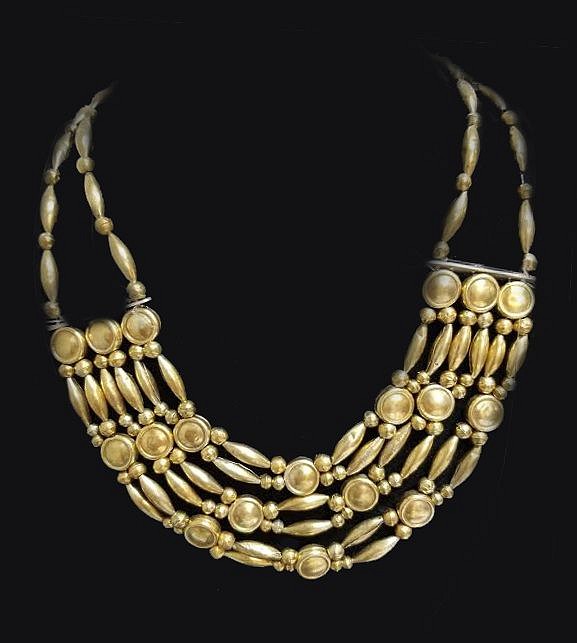



Peru, Vicus Gold Necklace of Soldered Discs and Rolled Oblong Beads
The necklace has been restrung to resemble the original ancient necklace. The beads were strung so that the necklace hangs flat. The roundels each have two sets of holes on either edge. The oblong beads are made from hemispheres and rolled, creating an elongated oblong shape. A necklace with similar shaped beads was found at the early Vicus site of Ayabeca in the far north of Peru.
Media: Metal
Dimensions: Length: 23" without clasp. Height: 12" atcenter. Weight: 88 grams.
$17,000
88121
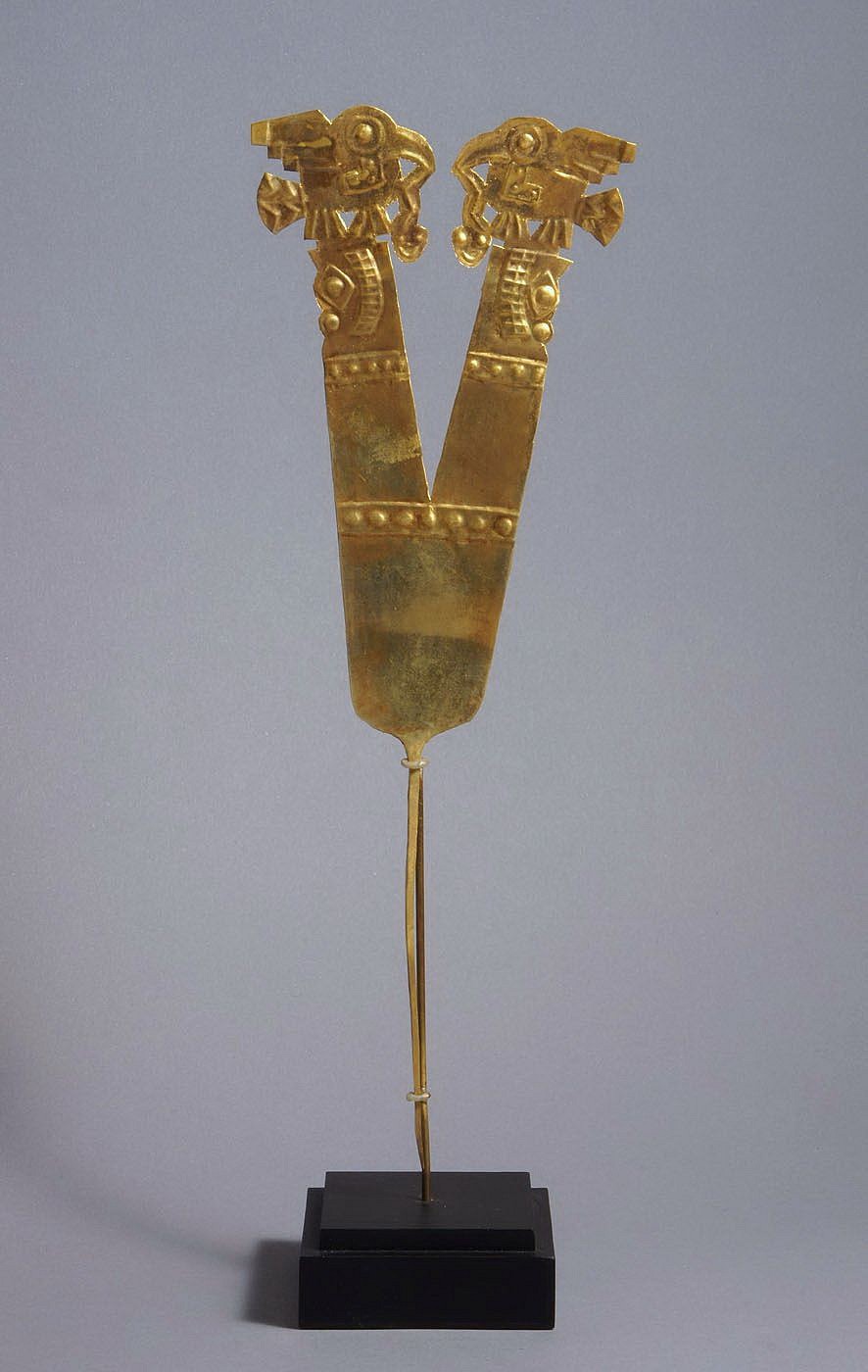


Peru, Wari Double-headed Gold Feather Plume with Embossed and Cutout Decoration
The feather plume is worked with embossed designs of two cutout birds standing on Puma heads and holding serpents in their beaks. The Puma Head can also be seen as a Condor head facing in the downward direction and seen in the classic Wari Tunics. The surfaces are beautifully burnished. A similar plume in the Berlin Museum measures 8 ¾†and is illustrated in WARI - Lords of the Andes, fig. 216. This plume is unusual in that it has two "branches" and is worked with both cutout and embossed designs while the others only have embossed work. Formerly in the collection of Robert Sonin.
Media: Metal
Dimensions: Height 10 1/2"
$12,500
M7122b




Peru, Wari Embossed Gold Feather Plume Decoration Depicting a Pair of Vultures
This double-headed design features two cutout birds of prey holding serpents in their beaks. This style of gold plume would have been attached to the headdress of a high-status individual, signifying strength and power. A less elaborate gold plum by the same artist is illustrated in WARI: Lords of the Ancient Andes, page 227. Acquired from a New York collector prior to 1990.
Media: Metal
Dimensions: Height 11 1/4" Weight: 26 grams.
Price Upon Request
m7122

Peru, Wari Gold and Silver Bicephalous Arc (Serpent Deity) with Dangles
This ornament represents a plume of features, intended to be placed into a gold headband. When worn in ceremonies, the kinetic dangles would have moved and reflected a variety of colors of warm light, attracting the attention of onlookers.
Media: Metal
Dimensions: Heigh: 8 1/2" x Width: 6" Weight:26 grams.
$7,800
p4162





Peru, Wari Pair of Gold and Silver Ear Plugs
This pair of ear plugs has gilt gold fronts attached to silver plugs. The silver plugs were made using a wood matrix, which can be seen in a few exposed areas on the back. It is quite rare to see the wooden matrix intact underneath the gold as it usually disintegrates within a few hundred years. Similar ear spools are illustrated in PRE-COLOMBIAN ART OF SOUTH AMERICA by Alan Lapiner, plate 566.
Media: Metal
Dimensions: Diameter: 2 5/8" x Depth: 3 1/8"
$7,500
n8032